Quanta Microsystems WV202 WV202 WiMAX IAD User Manual WV202 Ver 1 0 GN
Quanta Microsystems, Inc. WV202 WiMAX IAD WV202 Ver 1 0 GN
Contents
- 1. Manual Part 1
- 2. Manual Part 2
Manual Part 1

Quanta Computer Inc. IEEE802.16e WiMAX IAD (WV202)
User Manual
211, Wen Hwa 2nd Rd., Kuei Shan Hsiang, CONFIDENTIAL
Tao Yuan Shien, Taiwan, R.O.C. Classification: proprietary information
http://www.quantatw.com
1
Brand Name: Quanta
Quanta Computer, Inc.
IEEE802.16e WiMAX IAD
(WV202)
User Manual
Version 1.0

Quanta Computer Inc. IEEE802.16e WiMAX IAD (WV202)
User Manual
211, Wen Hwa 2nd Rd., Kuei Shan Hsiang, CONFIDENTIAL
Tao Yuan Shien, Taiwan, R.O.C. Classification: proprietary information
http://www.quantatw.com
2
Revision History
Revision Date By Description Reviewed By
0.1 09/03/2007 Terry First edition
0.2 09/07/2007 Terry Refine format
0.3 11/1/2007 Terry Modify
0.4 03/25/2008 Jud Modify
0.5 07/08/2008 Jud Modify
0.6 08/04/2008 Jud 1. Add the copyright
description.
2. Update the newest
UI and the description.
3. Add TR069
0.7 08/12/2008 Jud 1. Modify the title to
add brand name
2. Add the using
notice.
1.0 08/03/2009 Jud 3. Add Federal
Communication
Commission
Interference
Statement

Quanta Computer Inc. IEEE802.16e WiMAX IAD (WV202)
User Manual
211, Wen Hwa 2nd Rd., Kuei Shan Hsiang, CONFIDENTIAL
Tao Yuan Shien, Taiwan, R.O.C. Classification: proprietary information
http://www.quantatw.com
3
Federal Communication Commission Interference Statement
This equipment has been tested and found to comply with the limits for a
Class B digital device, pursuant to Part 15 of the FCC Rules. These
limits are designed to provide reasonable protection against harmful
interference in a residential installation. This equipment generates, uses
and can radiate radio frequency energy and, if not installed and used in
accordance with the instructions, may cause harmful interference to radio
communications. However, there is no guarantee that interference will
not occur in a particular installation. If this equipment does cause
harmful interference to radio or television reception, which can be
determined by turning the equipment off and on, the user is encouraged to
try to correct the interference by one of the following measures:
- Reorient or relocate the receiving antenna.
- Increase the separation between the equipment and receiver.
- Connect the equipment into an outlet on a circuit different from that to
which the receiver is connected.
- Consult the dealer or an experienced radio/TV technician for help.
FCC Caution: Any changes or modifications not expressly approved by
the party responsible for compliance could void the user's authority to
operate this equipment.
This device complies with Part 15 of the FCC Rules. Operation is subject
to the following two conditions:
(1) This device may not cause harmful interference, and
(2) this device must accept any interference received, including
interference that may cause undesired operation.
IMPORTANT NOTE:
FCC Radiation Exposure Statement:
This equipment complies with FCC radiation exposure limits set forth for
an uncontrolled environment. This equipment should be installed and
operated with minimum distance 20cm between the radiator & your body.
This transmitter must not be co-located or operating in conjunction with
any other antenna or transmitter.

Quanta Computer Inc. IEEE802.16e WiMAX IAD (WV202)
User Manual
211, Wen Hwa 2nd Rd., Kuei Shan Hsiang, CONFIDENTIAL
Tao Yuan Shien, Taiwan, R.O.C. Classification: proprietary information
http://www.quantatw.com
4
Due to the essential high output power natural of WiMAX device, use of
this
device with other transmitter at the same time may exceed the FCC RF
exposure
limit and such usage must be prohibited (unless such co-transmission has
been approved by FCC in the future).

Quanta Computer Inc. IEEE802.16e WiMAX IAD (WV202)
User Manual
211, Wen Hwa 2nd Rd., Kuei Shan Hsiang, CONFIDENTIAL
Tao Yuan Shien, Taiwan, R.O.C. Classification: proprietary information
http://www.quantatw.com
5
Copyright
The information described in this document is confidential and protected by
copyright. All contents (part or whole) can not be reproduced, transmitted, translated
into any language, or copied and stored without the written permission of Quanta
Computer Inc. All rights reserved. This document is published by QCI.
Trademarks
QCI is a registered trademark of Quanta Computer Inc. Other trademarks and
registered trademarks and logo mentioned in this publication are only used for
identification purposes.
Notice
When the operator is using this product, and if this product has the signal
interference in the same time, it will have noise interference in the telephone. But the
noise interference is lower, it won’t interfere the communication quality when operators
are making the call. And this interference is normal status and under the product spec.

Quanta Computer Inc. IEEE802.16e WiMAX IAD (WV202)
User Manual
211, Wen Hwa 2nd Rd., Kuei Shan Hsiang, CONFIDENTIAL
Tao Yuan Shien, Taiwan, R.O.C. Classification: proprietary information
http://www.quantatw.com
6
Table of Contents
TABLE OF CONTENTS............................................................................................................................ 6
1. INTRODUCTION............................................................................................................................. 8
1.1 AUDIENCE .................................................................................................................................. 9
1.2 ACRONYMS................................................................................................................................. 9
2. INSTALLATION AND SETUP...................................................................................................... 10
2.1 QUICK START ............................................................................................................................ 10
2.1.1 WV202 WiMAX IAD factory default settings ...................................................................... 10
2.1.2 How to configure WV202 .................................................................................................... 10
2.1.3 How to use VoIP?................................................................................................................12
2.1.4 How to make a three way conference call?......................................................................... 14
3. NETWORK SETTINGS................................................................................................................. 15
3.1 WAN ........................................................................................................................................ 16
3.1.1 WAN Setting ........................................................................................................................ 16
3.1.2 WiMAX Setting.................................................................................................................... 20
3.2 AUTO CONNECT........................................................................................................................ 25
3.3 WIMAX EAP........................................................................................................................... 26
3.4 LAN SETTING........................................................................................................................... 30
3.4.1 DNS Proxy........................................................................................................................... 30
3.5 DHCP....................................................................................................................................... 31
3.5.1 DHCP Server ...................................................................................................................... 31
3.6 STATIC ROUTE .......................................................................................................................... 32
3.7 NAT ......................................................................................................................................... 33
3.7.1 NAT Setting ......................................................................................................................... 33
3.7.2 Virtual Server Mapping....................................................................................................... 34
3.7.3 Port Trigger......................................................................................................................... 35
3.7.4 Port Forward ...................................................................................................................... 35
3.8 PACKET FILTER ......................................................................................................................... 37
3.9 URL FILTER.............................................................................................................................. 40
3.10 SECURITY ................................................................................................................................. 41
3.11 UPNP........................................................................................................................................ 42
3.12 DDNS ...................................................................................................................................... 43
3.13 QOS.......................................................................................................................................... 44
3.14 TR069...................................................................................................................................... 45
4. SIP SETTINGS................................................................................................................................ 47
4.1 BASIC SETTING......................................................................................................................... 47
4.2 ACCOUNT SETTING................................................................................................................... 50
4.3 SERVER SETTING ...................................................................................................................... 52
4.4 NAT TRAVERSAL ...................................................................................................................... 54
5. VOIP SETTINGS ............................................................................................................................ 55
5.1 VOICE SETTING ........................................................................................................................ 55
5.1.1 Codec .................................................................................................................................. 57
5.2 TONE SETTING.......................................................................................................................... 59
5.3 CALL SERVICE .......................................................................................................................... 60
5.3.1 Call Service for All Line...................................................................................................... 62

Quanta Computer Inc. IEEE802.16e WiMAX IAD (WV202)
User Manual
211, Wen Hwa 2nd Rd., Kuei Shan Hsiang, CONFIDENTIAL
Tao Yuan Shien, Taiwan, R.O.C. Classification: proprietary information
http://www.quantatw.com
7
5.3.2 Call Service for Per Line..................................................................................................... 63
5.4 FXS PORT SETTING .................................................................................................................. 65
5.4.1 FXS Port Setting for All Line .............................................................................................. 65
5.4.2 FXS Port Setting for Per Line............................................................................................. 67
5.5 FAX SETTING ........................................................................................................................... 68
5.6 GENERAL DIALING SETTING..................................................................................................... 69
5.7 DIAL PLAN................................................................................................................................72
5.8 PHONE BOOK............................................................................................................................ 73
5.9 CALL SCREEN ........................................................................................................................... 74
6. INFORMATION ............................................................................................................................. 75
6.1 SYSTEM INFORMATION ............................................................................................................. 75
6.2 WIMAX STATUS....................................................................................................................... 77
6.3 ROUTING TABLE ....................................................................................................................... 80
6.4 CALL DETAIL RECORD.............................................................................................................. 81
6.5 LINE STATUS ............................................................................................................................. 83
6.6 PACKET STATISTIC .................................................................................................................... 84
6.7 SYSTEM LOG ............................................................................................................................ 85
7. MANAGEMENT............................................................................................................................. 87
7.1 ADMINISTRATOR ACCOUNT ...................................................................................................... 87
7.2 SYSTEM LOG SETTING.............................................................................................................. 89
7.3 DATE/TIME ............................................................................................................................... 90
7.4 PING TEST................................................................................................................................. 92
7.5 CONFIG..................................................................................................................................... 93
7.6 PROVISIONING .......................................................................................................................... 94
8. LOGOUT ......................................................................................................................................... 97
8.1 LOGOUT.................................................................................................................................... 97
8.2 REBOOT.................................................................................................................................... 97
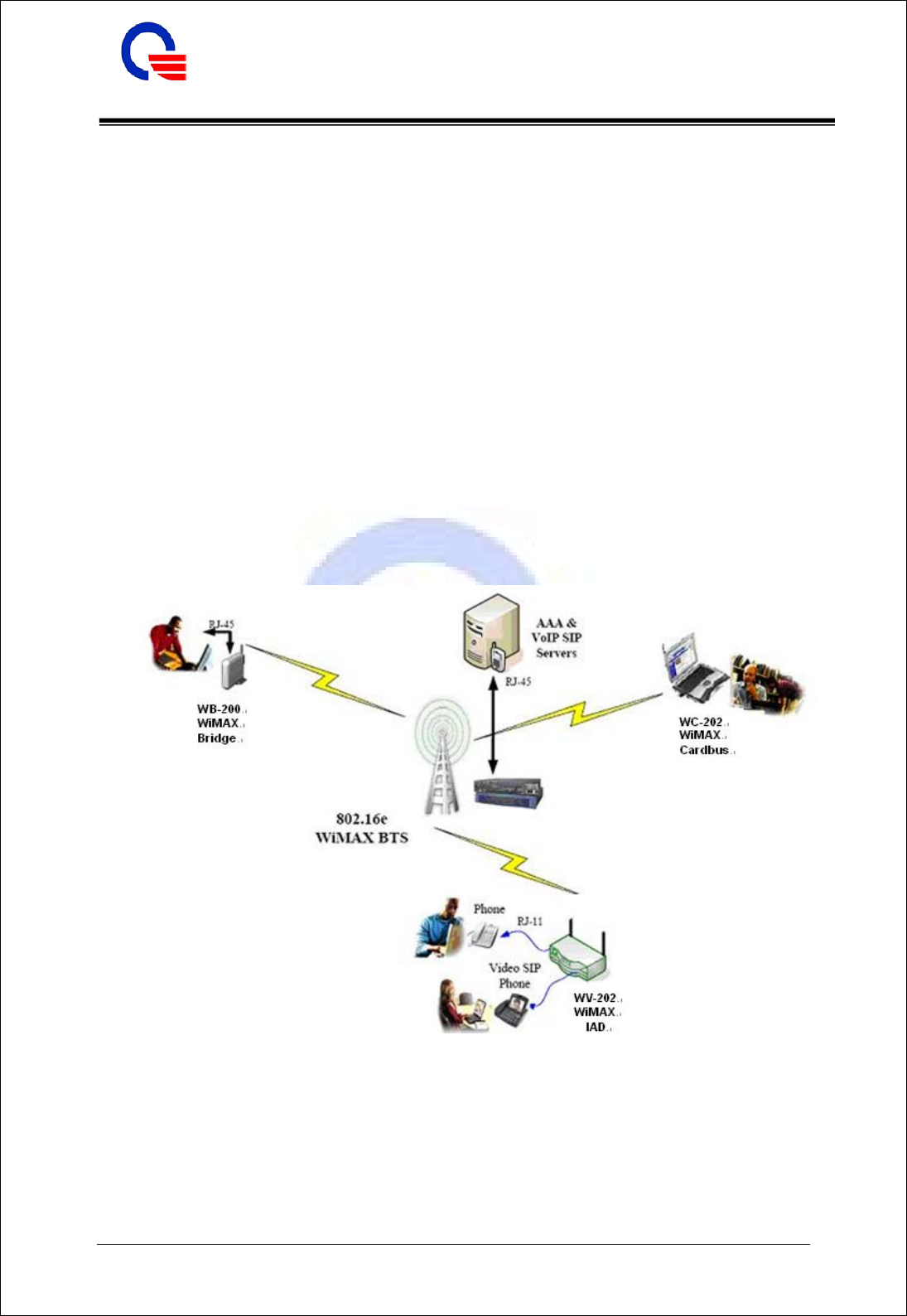
Quanta Computer Inc. IEEE802.16e WiMAX IAD (WV202)
User Manual
211, Wen Hwa 2nd Rd., Kuei Shan Hsiang, CONFIDENTIAL
Tao Yuan Shien, Taiwan, R.O.C. Classification: proprietary information
http://www.quantatw.com
8
1. Introduction
The WV202 WiMAX IAD is a WiMAX LAN router with two LAN ports, two VoIP (FXS) ports
and one WiMAX WAN interface. The WV202 supports IEEE 802.16e-2005 state of the art
Scalable OFDMA based Technology. It operates on 2.496 GHz ~ 2.69GHz frequency licensed
band. It supports WiMAX forum Wave1 SISO specification and provides users a seamless
broadband wireless access; VoIP calls at home, office. It acts as two devices in one box. First,
there’s a built-in two full-duplex 10/100 Base-T Ethernet ports that allows user to connect PC/NB
or Ethernet switch devices together to extend the connectivity. Secondly, the routing functions tie
these devices together and allow networked devices to share a high-speed broadband
connection via the broadband WiMAX WAN port.
Look at below diagram show you the example usage model for WV202 with our others
products (WC202 WiMAX Cardbus, WB200 WiMAX Bridge). With the WiMAX IAD at the center of
your home or office network, you can share a high-speed Internet connection, files, and
multi-player games with flexibility, speed, and security!
WiMAX Usage Model Example

Quanta Computer Inc. IEEE802.16e WiMAX IAD (WV202)
User Manual
211, Wen Hwa 2nd Rd., Kuei Shan Hsiang, CONFIDENTIAL
Tao Yuan Shien, Taiwan, R.O.C. Classification: proprietary information
http://www.quantatw.com
9
1.1 Audience
This document is intended for system vendor who are using WV202 to build an Internet telephony
gateway or server application. It is assumed that the reader has the general knowledge of VoIP applications
and products.
1.2 Acronyms
API Application Interface
ALG Application Layer Gateway
ACI Audio CODEC Interface
ADC Analog to Digital Converter
CODEC Coder / Decoder
DAC Digital to Analog Converter
DC Direct Current
DDNS Dynamic Domain Name System
DHCP Dynamic Host Configuration Protocol
DMZ Demilitarized Zone
DNS Domain Name System
DTMF Dual Tone Multi Frequency
FXO Foreign Exchange Office
FXS Foreign Exchange Station
GMT Greenwich Mean Time
IP Internet Protocol
IPsec Internet Protocol Security
L2TP Layer 2 Tunnel Protocol
LAN Local Area Network
MAC Media Access Control
MII Media Independent Interface
NAT Network Address Translation
NTP Network Time Protocol
PPTP Point-to-Point Tunneling Protocol
RTP Real-Time Transport Protocol
RTCP Real-Time Transport Control Protocol (also known as RTP control protocol)
SIP Session Initiation Protocol
SLIC Subscriber Line Interface Circuit
STUN Simple Traversal of UDP through NATs
TCP Transmission Control Protocol
UDP User Datagram Protocol
UPnP Universal Plug and Play
URI Uniform Resource Identifier
VoIP Voice Over Internet Protocol
WAN Wide Area Network
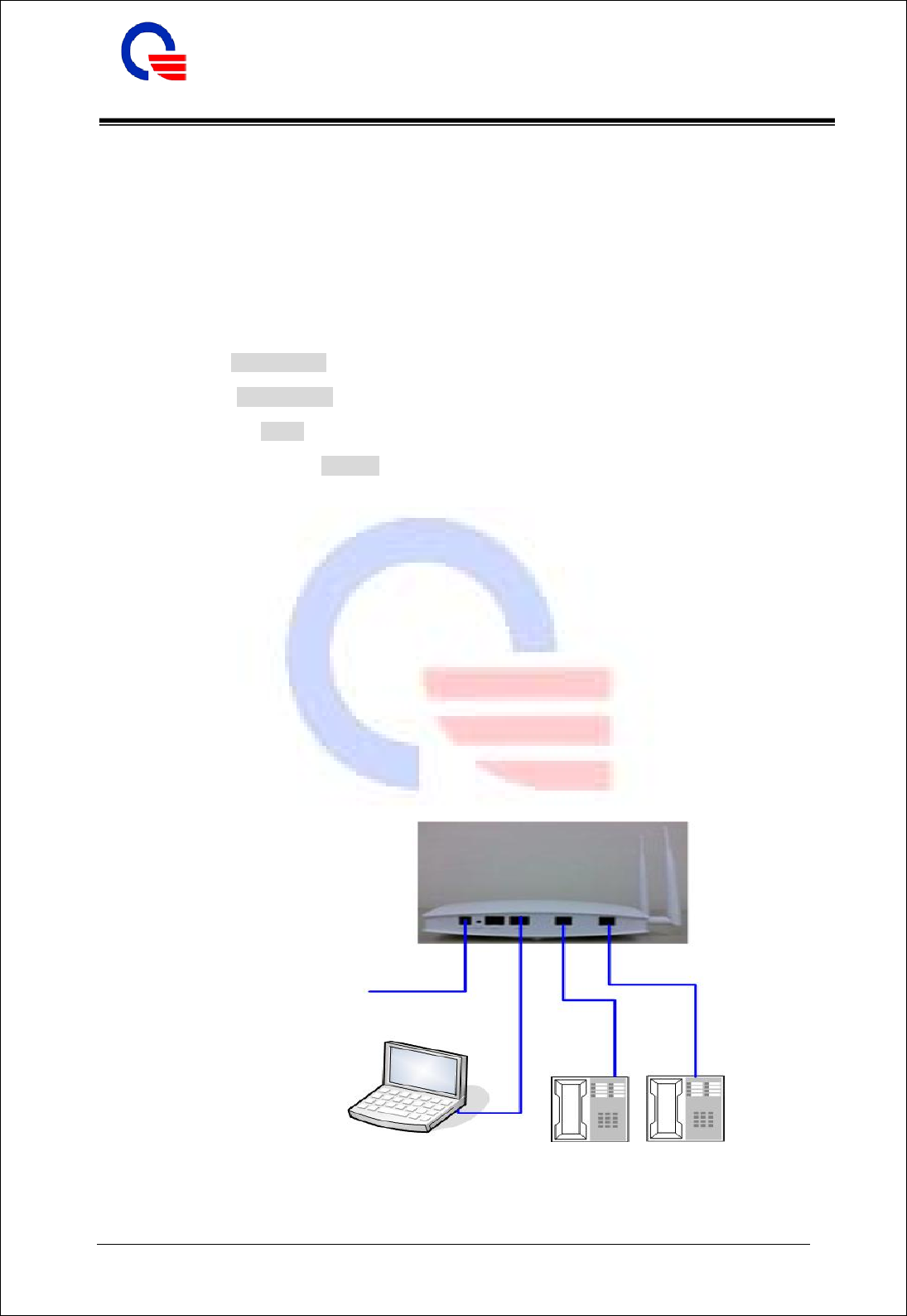
Quanta Computer Inc. IEEE802.16e WiMAX IAD (WV202)
User Manual
211, Wen Hwa 2nd Rd., Kuei Shan Hsiang, CONFIDENTIAL
Tao Yuan Shien, Taiwan, R.O.C. Classification: proprietary information
http://www.quantatw.com
10
2. Installation and Setup
2.1 Quick Start
2.1.1 WV202 WiMAX IAD factory default settings
¾ LAN IP: 192.168.1.254
¾ Netmask: 255.255.255.0
¾ LAN DHCP: enable
¾ User Name/Password: root/root
2.1.2 How to configure WV202
To access the WiMAX IAD via Ethernet, the host computer must meet the following requirements:
¾ Equipped with an Ethernet network interface.
¾ Have TCP/IP installed.
¾ Allow the client PC to obtain an IP address automatically or set a fixed IP address.
¾ With a web browser installed: Internet Explorer 5.x or later.
The connection structure is as below:
Power
NB or PC Phone4
2
Phone3
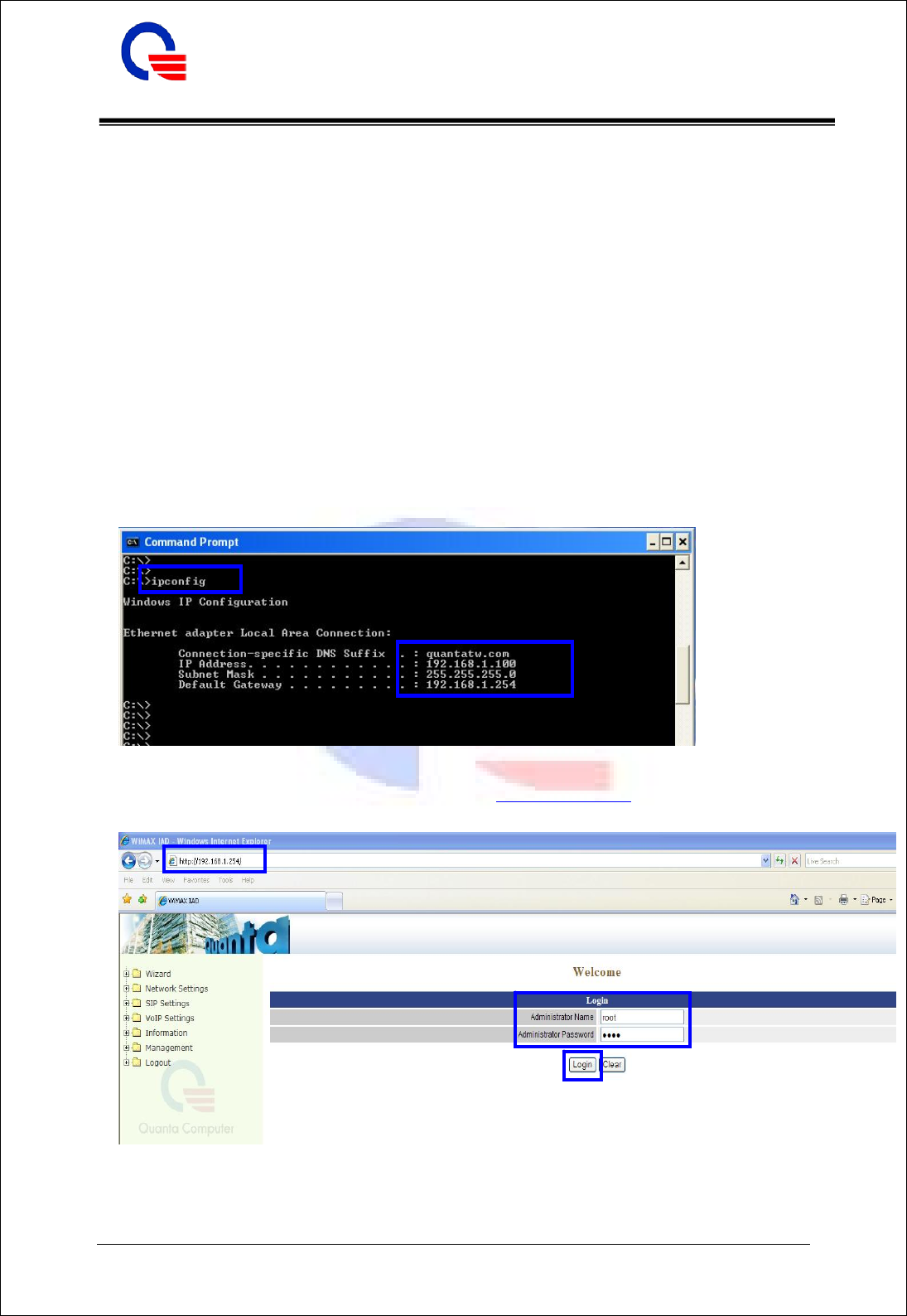
Quanta Computer Inc. IEEE802.16e WiMAX IAD (WV202)
User Manual
211, Wen Hwa 2nd Rd., Kuei Shan Hsiang, CONFIDENTIAL
Tao Yuan Shien, Taiwan, R.O.C. Classification: proprietary information
http://www.quantatw.com
11
The WiMAX IAD is configured with the default IP address of 192.168.1.254 and subnet mask of
255.255.255.0. Considering that the DHCP server is enabled by default, the DHCP clients should be
able to access the WiMAX, or the host PC should be assigned an static IP address first for initial
configuration. An example for static IP address can be set to “192.168.1.100”.
You also can manage the WiMAX IAD through a web browser-based manager. The WiMAX IAD
manager uses the HTTP protocol via a web browser to allow you to set up and manage the device. The
URL of management web site is : http://192.168.1.254. Following are the steps to login and control the
IAD.
Step 1: Power on IAD, when the booting is finished, the LED stats of IAD is as below:
LED is always “ON”: “Power”, “FXS1”, “FXA2”
LED is always “OFF”: “WiMAX”, “LAN1”, “LAN2”, “System”
Step 2: Connect the network adapter of the PC to the LAN1 port on IAD.
Step 3: Make sure the PC’s IP address getting from IAD DHCP server is 192.168.1.xxx. The default IP
address is 192.168.1.100 for the first requested client.
Step 4: Open the browser and input the web control site: http://192.168.1.254 and input the login
username and password: root/root, then click the “Login” button
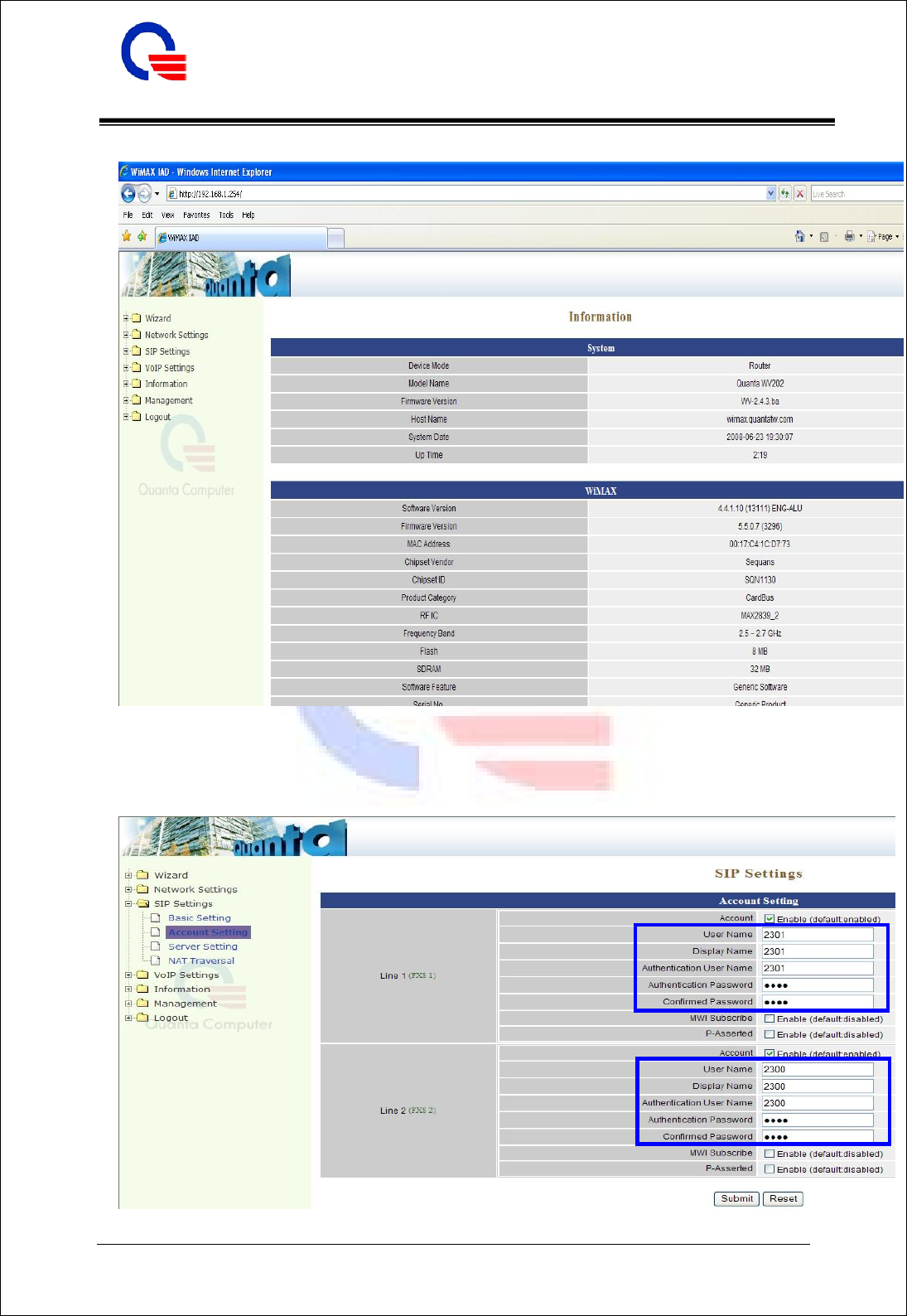
Quanta Computer Inc. IEEE802.16e WiMAX IAD (WV202)
User Manual
211, Wen Hwa 2nd Rd., Kuei Shan Hsiang, CONFIDENTIAL
Tao Yuan Shien, Taiwan, R.O.C. Classification: proprietary information
http://www.quantatw.com
12
Step 5: You will see the information page after login the web site.
2.1.3 How to use VoIP?
SIP Settings -> Account Setting
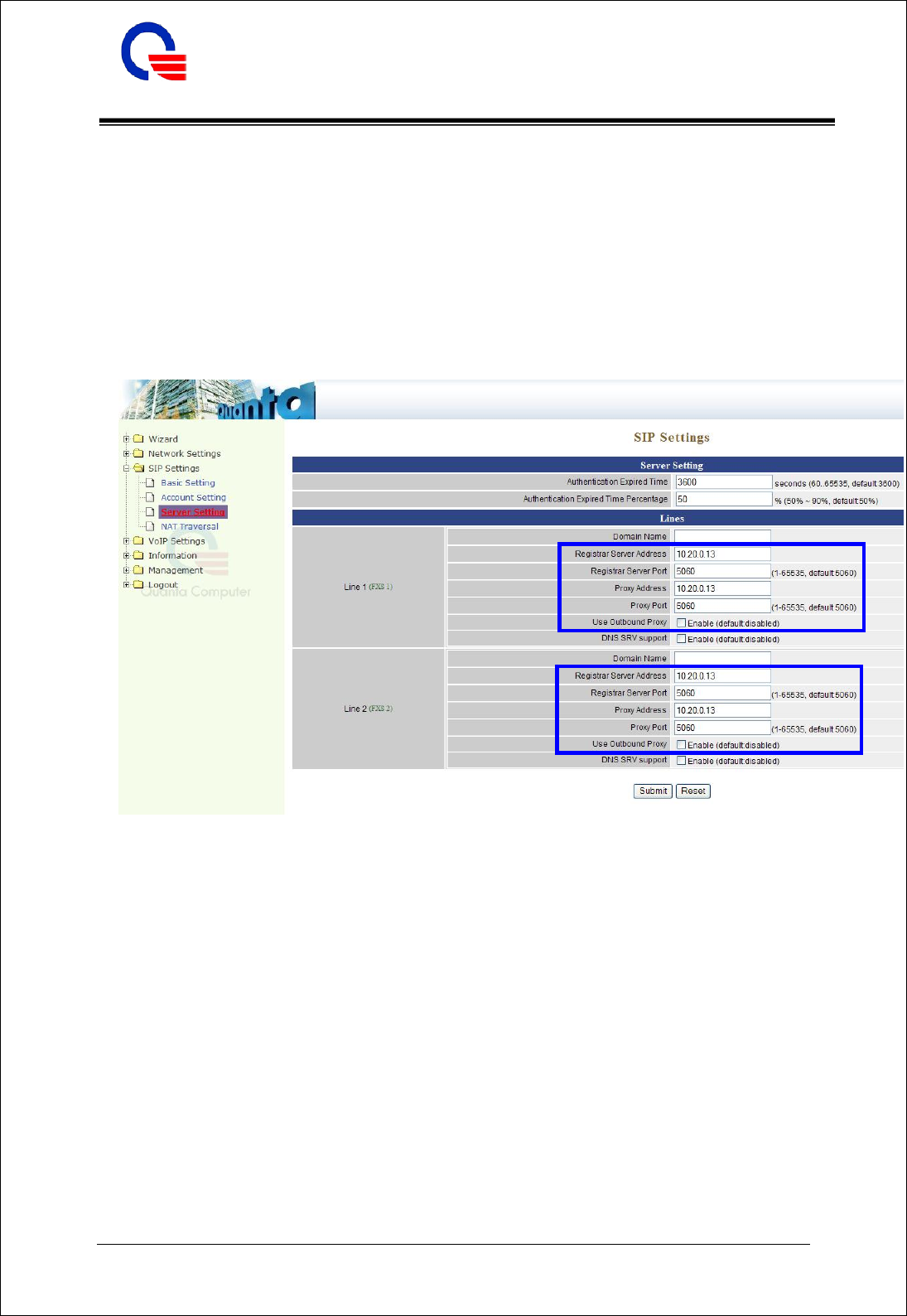
Quanta Computer Inc. IEEE802.16e WiMAX IAD (WV202)
User Manual
211, Wen Hwa 2nd Rd., Kuei Shan Hsiang, CONFIDENTIAL
Tao Yuan Shien, Taiwan, R.O.C. Classification: proprietary information
http://www.quantatw.com
13
¾ Type User Name and Display Name
¾ Type Authentication User Name as the phone number
¾ Type Authentication Password
¾ Confirmed Password
Please make sure the Authentication User Name and Authentication Password had been setup in
SIP server.
SIP Settings -> Server Setting
¾ Type Registrar Server Address as your SIP server address
¾ Type Proxy Address to the same with SIP server
¾ Make sure WV202 has already registered to your Registrar Server then you can make
VoIP call.
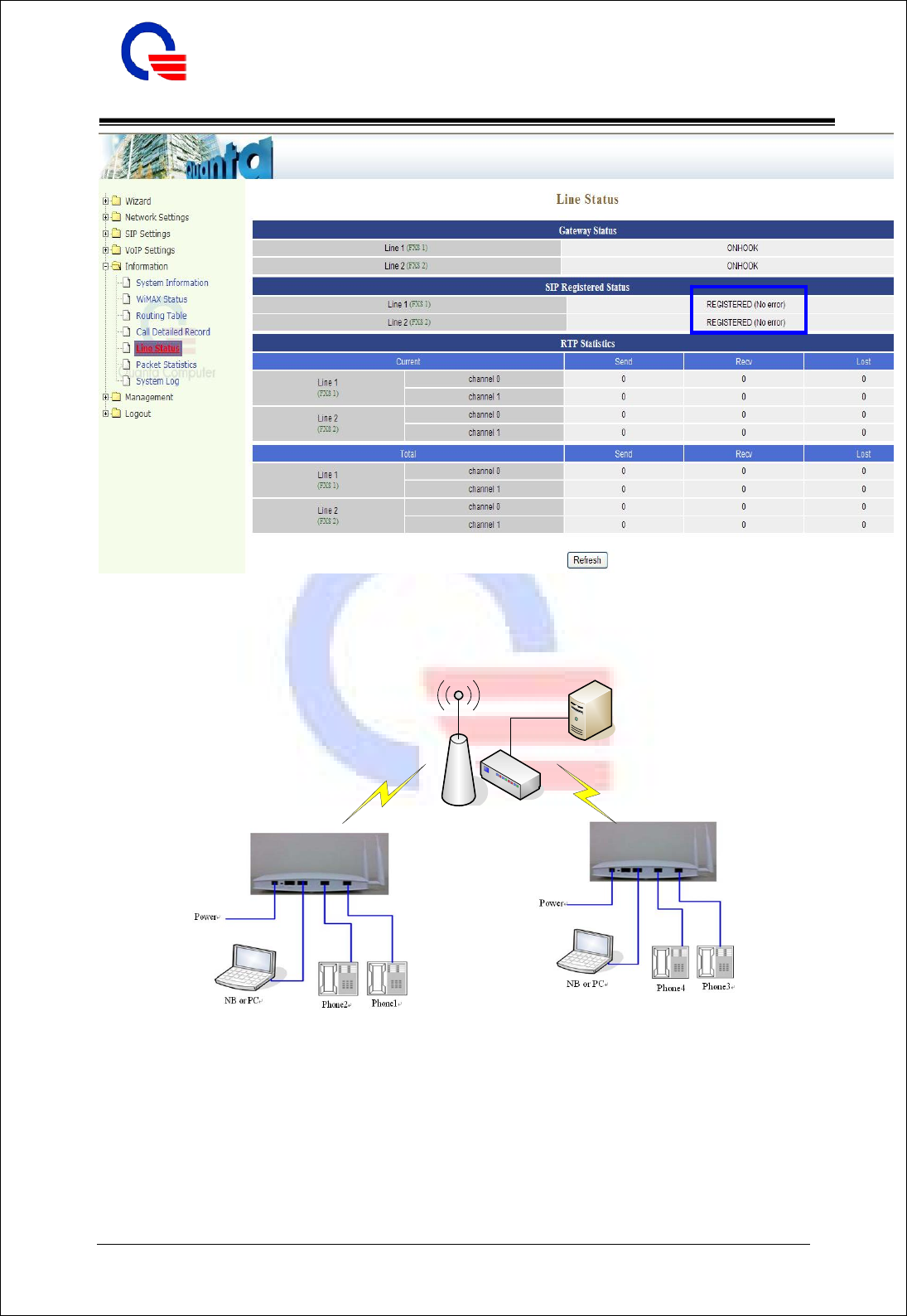
Quanta Computer Inc. IEEE802.16e WiMAX IAD (WV202)
User Manual
211, Wen Hwa 2nd Rd., Kuei Shan Hsiang, CONFIDENTIAL
Tao Yuan Shien, Taiwan, R.O.C. Classification: proprietary information
http://www.quantatw.com
14
2.1.4 How to make a three way conference call?
¾ Make a call to the first party. For example: phone1 makes a call to phone2.
¾ "Flash hook" to hold the call. For example: phone1 “Flash hook”.
¾ Then you will hear a dial tone.
¾ Make the other call to the third party. For example: phone1 makes the other call to phone3.
¾ Dial "*71" to connect the two party calls for conferencing. For example: phone1 dials “*71”,
then phone1, phone2 and phone3 are in a conference call.
SIP server
Base Station
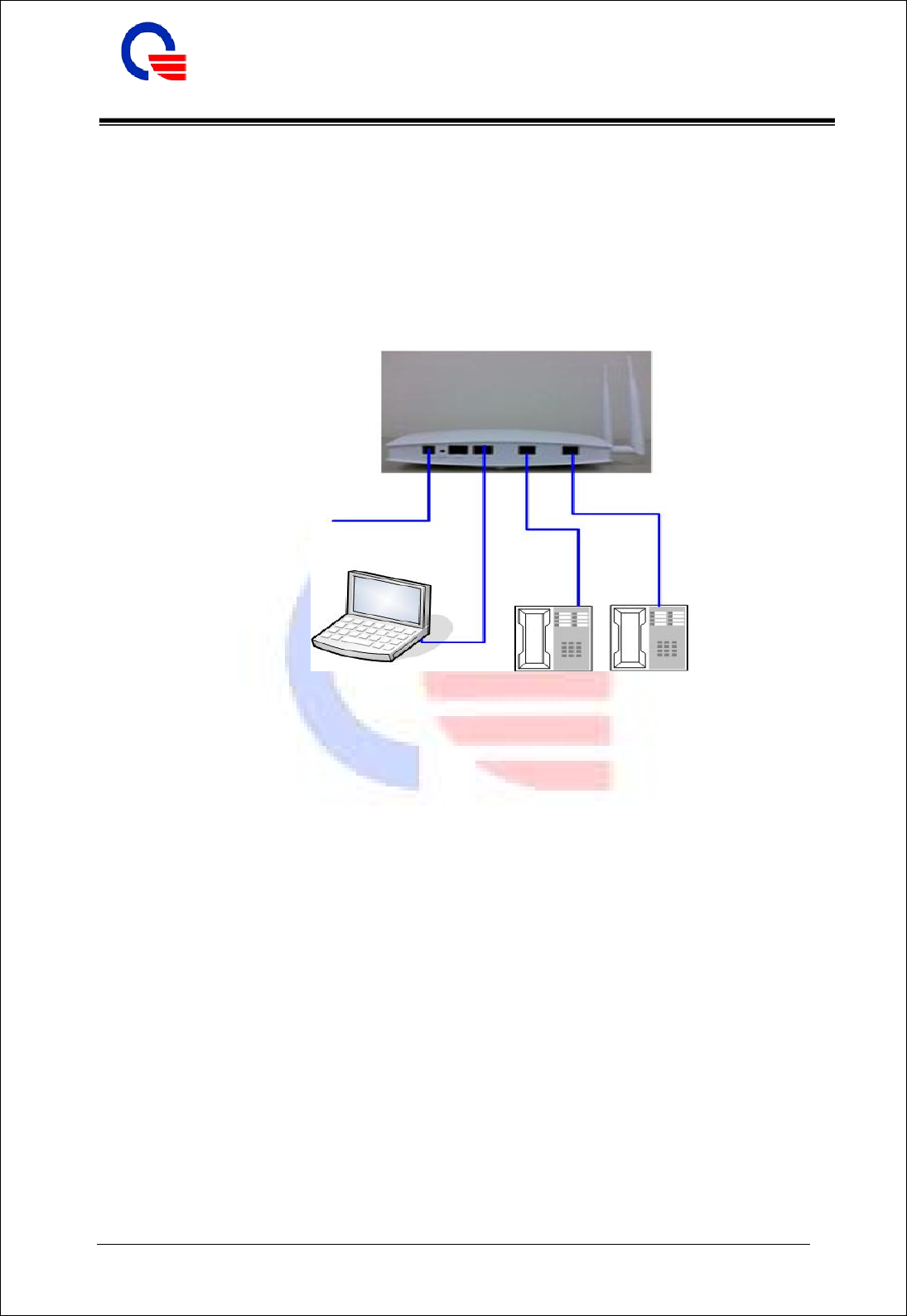
Quanta Computer Inc. IEEE802.16e WiMAX IAD (WV202)
User Manual
211, Wen Hwa 2nd Rd., Kuei Shan Hsiang, CONFIDENTIAL
Tao Yuan Shien, Taiwan, R.O.C. Classification: proprietary information
http://www.quantatw.com
15
3. Network Settings
All the network functions are set in this section. Before managing the IAD, please make sure you
have set the connection structure as below and refer the settings in the section 2.1.2 How to configure
WV202.
All the functions are supported as the following items.
¾ WAN
¾ Auto Connect
¾ WiMAX EAP
¾ LAN
¾ DHCP
¾ Static Route
¾ NAT
¾ Packet Filter
¾ URL Filter
¾ Security
¾ UPnP
¾ DDNS
¾ QOS
¾ TR069
Power
NB or PC Phone4
2
Phone3
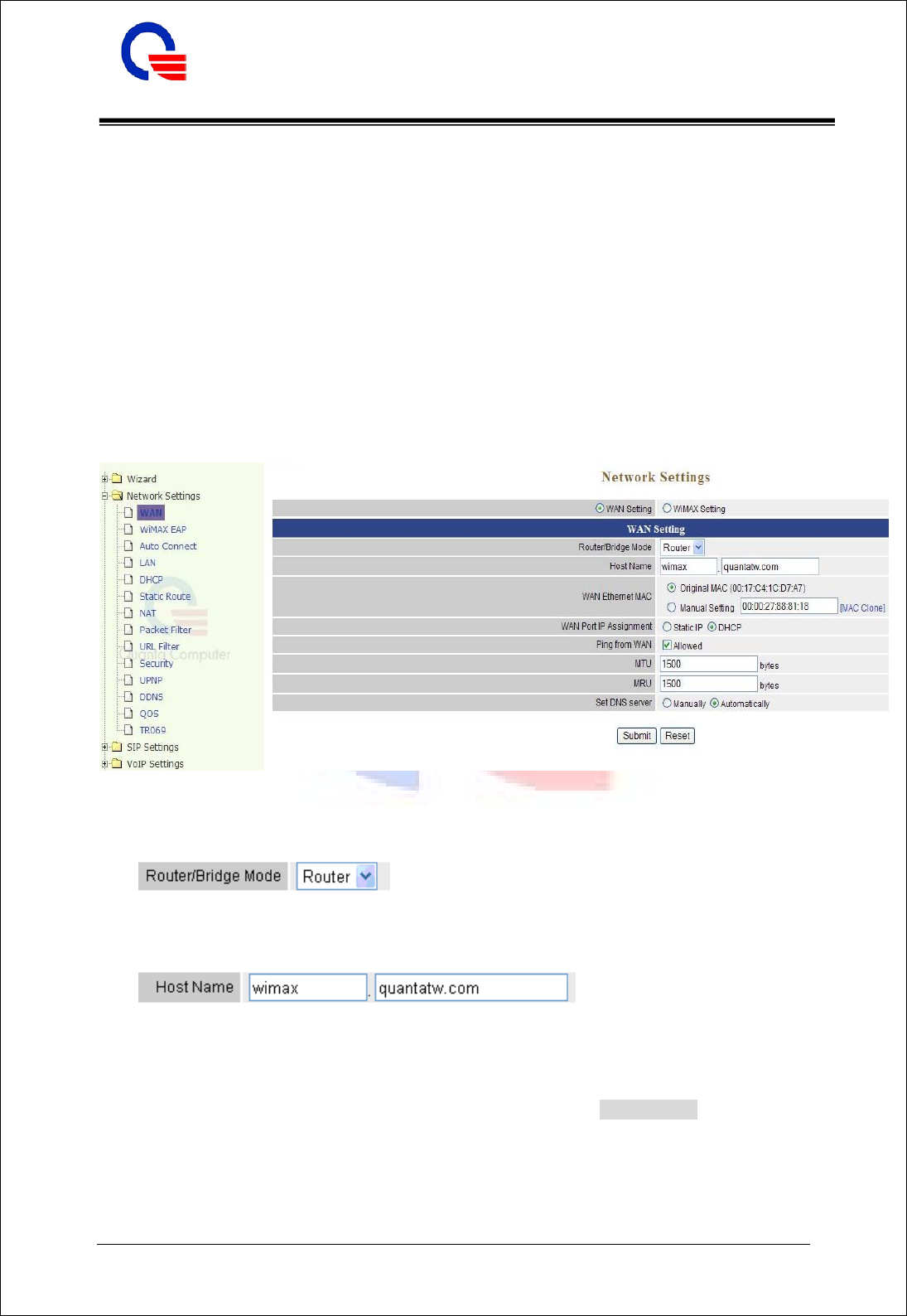
Quanta Computer Inc. IEEE802.16e WiMAX IAD (WV202)
User Manual
211, Wen Hwa 2nd Rd., Kuei Shan Hsiang, CONFIDENTIAL
Tao Yuan Shien, Taiwan, R.O.C. Classification: proprietary information
http://www.quantatw.com
16
3.1 WAN
In WV202, the WAN is the WiMAX connection entry. There are two pages (WAN Setting and WiMAX
Setting) to setting the TCP/IP settings and WiMAX frequency and bandwidth settings. The IAD is not yet
supported the bridge mode for WAN.
This chapter is going to introduce the function of each connection mode and the basic configuring steps
that you have to do. If you do not follow the configuring steps for using these connection modes, you
might get some connection problems and cannot connect to the Internet well.
3.1.1 WAN Setting
In this page, you can set the values about TCP/IP information like as IP address, MAC address, host
name, MTU, MRU, and DNS server.
¾ Router / Bridge Mode
In this version it is just supported the “Router” mode to work as a gateway/router.
¾ Host Name
The Host Name field is optional but may be required by some Internet Service Providers. The default host
name is wimax.quantatw.com. It is a computer that is connected to a TCP/IP network, including the
Internet. Each host has a unique IP address. Assign the domain name or IP address of your host computer.
When the host operating system is set up it is given a name. This name may reflect the prime use of the
computer. For example, a host computer that is a web server may be called www.xxx.com. When we need
to find the host name from an IP address we send a request to the host using its IP address. The host will
respond with its host name.
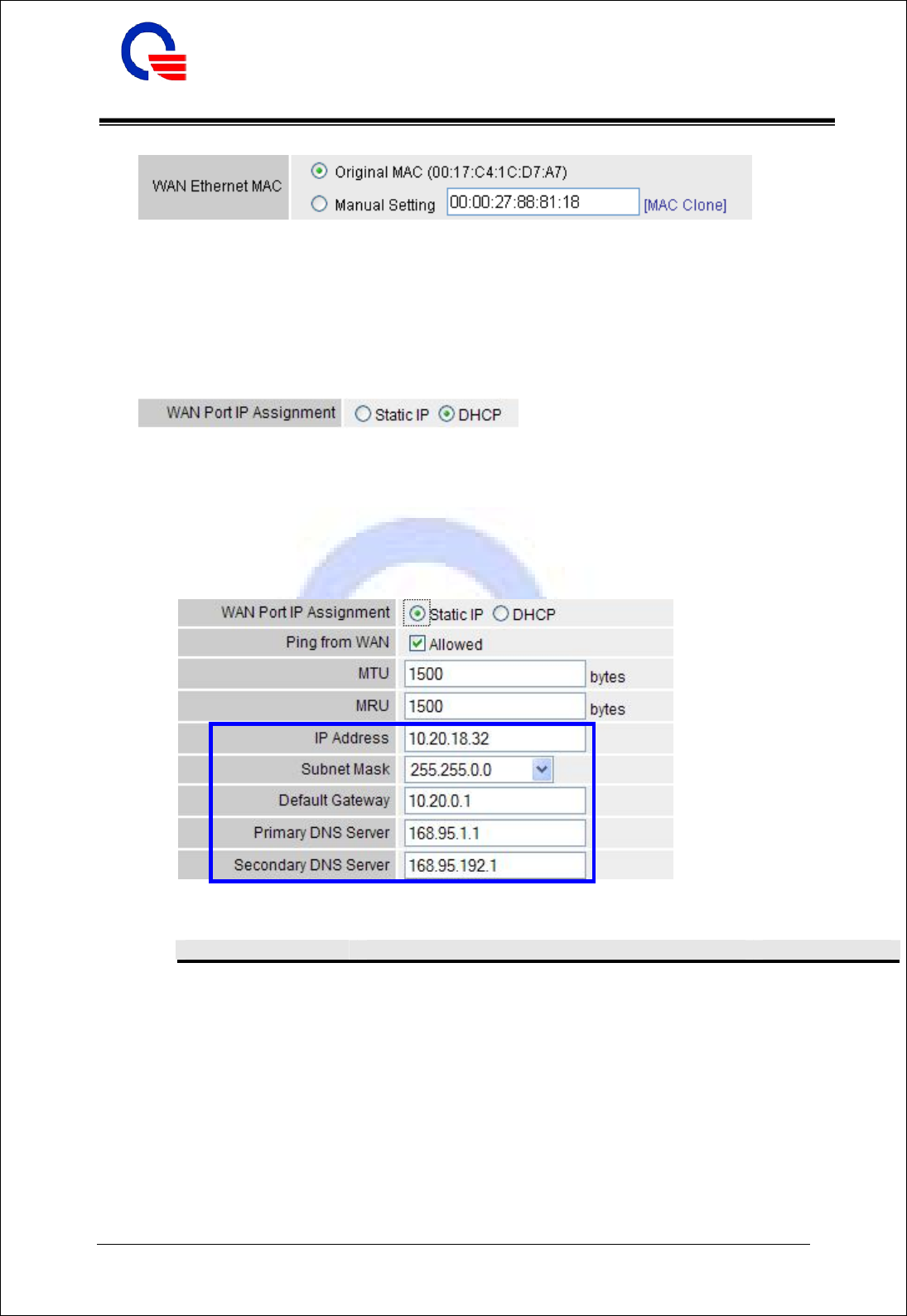
Quanta Computer Inc. IEEE802.16e WiMAX IAD (WV202)
User Manual
211, Wen Hwa 2nd Rd., Kuei Shan Hsiang, CONFIDENTIAL
Tao Yuan Shien, Taiwan, R.O.C. Classification: proprietary information
http://www.quantatw.com
17
¾ WAN Ethernet MAC
There are two methods to set the MAC address.
a. Original MAC
The original MAC is the manufacture shipping MAC address.
b. Manual Setting
You can set the specific MAC address in this field or set the MAC address of the computer
you are using by clicking the “MAC Clone”. After setting MAC address, please click
“Submit” button.
¾ WAN Port IP Assignment
You have two methods to set the WAN port IP, one is Static IP mode and the other one is DHCP
mode. The default setting is DHCP mode to get IP from DHCP server.
Static IP Mode
When you want to set the WAN IP to a static IP address, you can select Static IP mode.
Sometimes the ISP provider maybe gives you a static IP and requests you to set it for WAN
port.
If you select Static IP mode, you have to set the following fields.
Field Description Default value
IP address Enter the IP address provided by your ISP
10.20.18.32
Subnet Mask Enter the subnet mask provided by your ISP.
255.255.0.0
Default Gateway Enter the gateway provided by your ISP.
10.20.0.1
Primary DNS Server DNS (Domain Name System) is for mapping a domain
name to its assigned IP address. Enter the IP address for
the primary DNS server. The IPS maybe provides you
the IP address for DNS server.
168.95.1.1
Secondary DNS Server Enter the IP address for the second DNS server 168.95.192.1
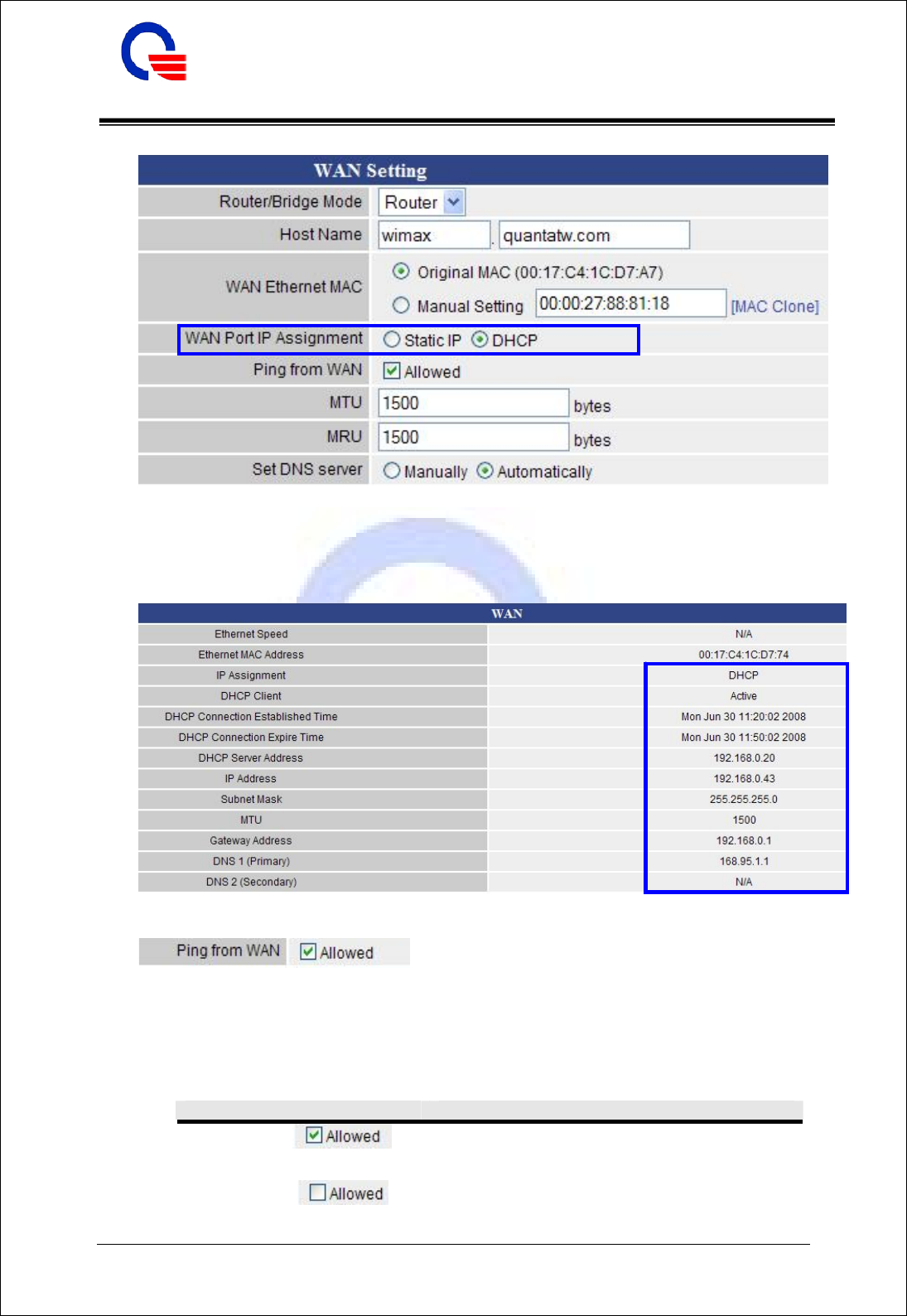
Quanta Computer Inc. IEEE802.16e WiMAX IAD (WV202)
User Manual
211, Wen Hwa 2nd Rd., Kuei Shan Hsiang, CONFIDENTIAL
Tao Yuan Shien, Taiwan, R.O.C. Classification: proprietary information
http://www.quantatw.com
18
DHCP mode
If you select DHCP mode for WAN port, the IAD will auto gets IP address, subnet mask and
default gateway address from ISP’s DHCP server.
After the WAN port is connected to WiMAX Base Station, the DHCP client will auto gets the
information from DHCP server like as the below picture.
¾ Ping From WAN
Ping is a basic Internet program that lets you verify that a particular IP address exists and can accept
requests. Ping is used diagnostically to ensure that a host computer you are trying to reach is actually
operating
The default setting is allowed user can ping the host computer from remote site. If you disallow, the host
computer doesn’t response any user who issues Ping IP address command from any remote sites.
Field Description
Allowed Enable Response the ping information to remote client.
(Default setting is enable)
Allowed Disable Doesn’t response the ping information to remote
client.
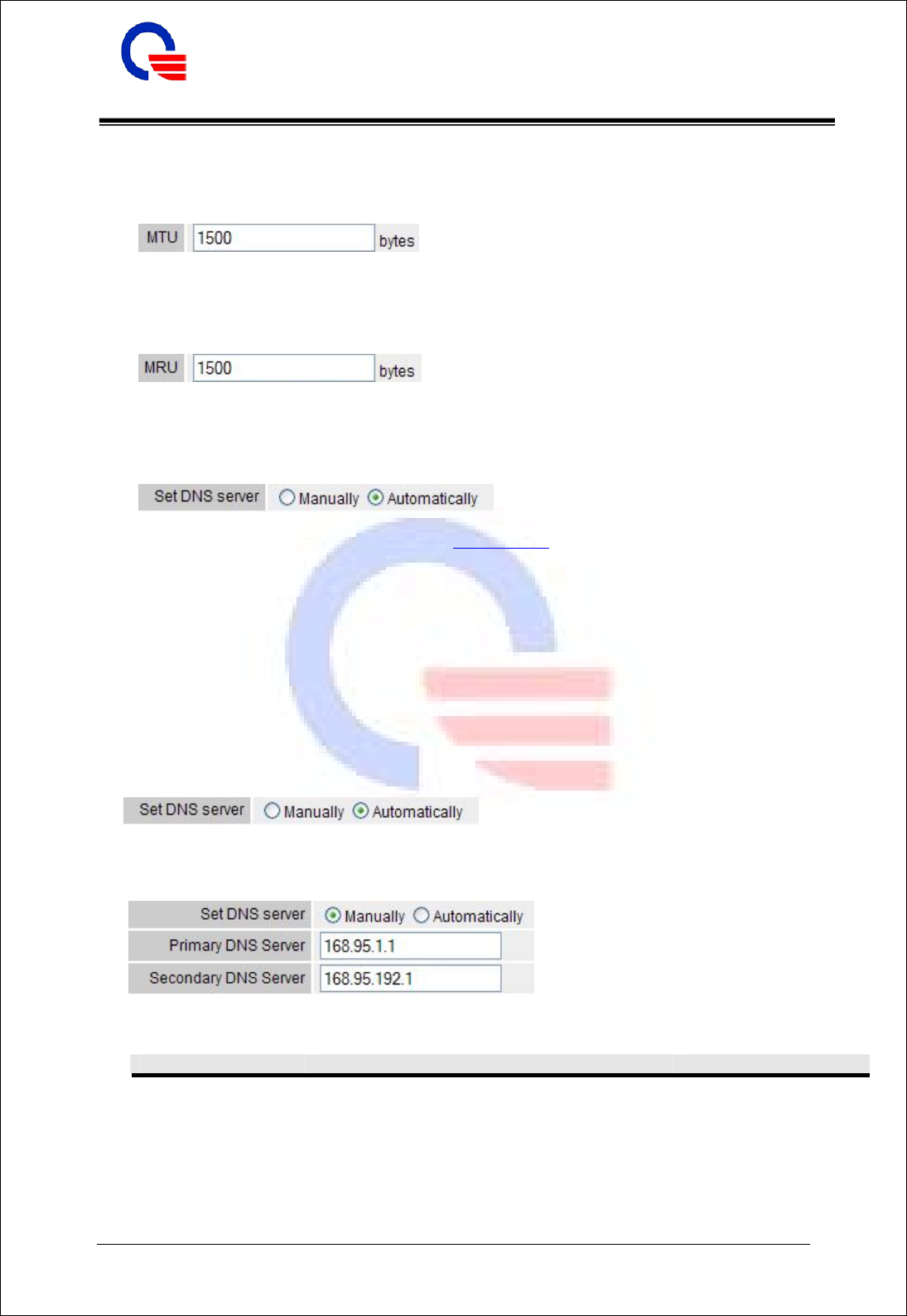
Quanta Computer Inc. IEEE802.16e WiMAX IAD (WV202)
User Manual
211, Wen Hwa 2nd Rd., Kuei Shan Hsiang, CONFIDENTIAL
Tao Yuan Shien, Taiwan, R.O.C. Classification: proprietary information
http://www.quantatw.com
19
¾ MTU
MTU stands for Maximum Transmission Unit, the largest physical packet size, measured in bytes
that a network can transmit. Any messages larger than the MTU are divided into smaller packets before
being sent. The network MTU rate is set to 1500 bytes with default settings.
¾ MRU
MRU stands for Maximum Receiving Unit. the largest physical packet size, measured in bytes that a
network can receive. Any messages larger than the MRU are divided into smaller packets before being
received. The network MRU rate is set to 1500 bytes with default settings.
¾ Set DNS Server
DNS stands for Domain Name System. Every Internet host must have a unique IP address, also they may
have a user-friendly, easy to remember name such as www.xxx.com. The DNS server converts the
user-friendly name into its equivalent IP address.
The original DNS specifications require that each domain name is served by at least 2 DNS servers for
redundancy. When you run your DNS, web, and mail servers all on the same machine - if this machine
goes down, it doesn't really matter that the backup DNS server still works.
The recommended practice is to configure the primary and secondary DNS servers on separate machines,
on separate Internet connections, and in separate geographic locations.
Primary DNS Server: Sets the IP address of the primary DNS server.
Secondary DNS Server: Sets the IP address of the secondary DNS server.
There are two methods to set the DNS server:
a. Automatically (Default setting)
When you select the Auto mode, the IP address of DNS server will be gotten from ISP’s DHCP
server. You will get IP address of the primary DNS server and the secondary DNS server.
b. Manually
When you want to set the DNS server manually, you can select this mode to set primary DNS server
and secondary DNS server as below.
Field Description Default value
Primary DNS Server Sets the IP address of the primary DNS server
168.95.1.1
Secondary DNS Server Sets the IP address of the secondary DNS server 168.95.192.1
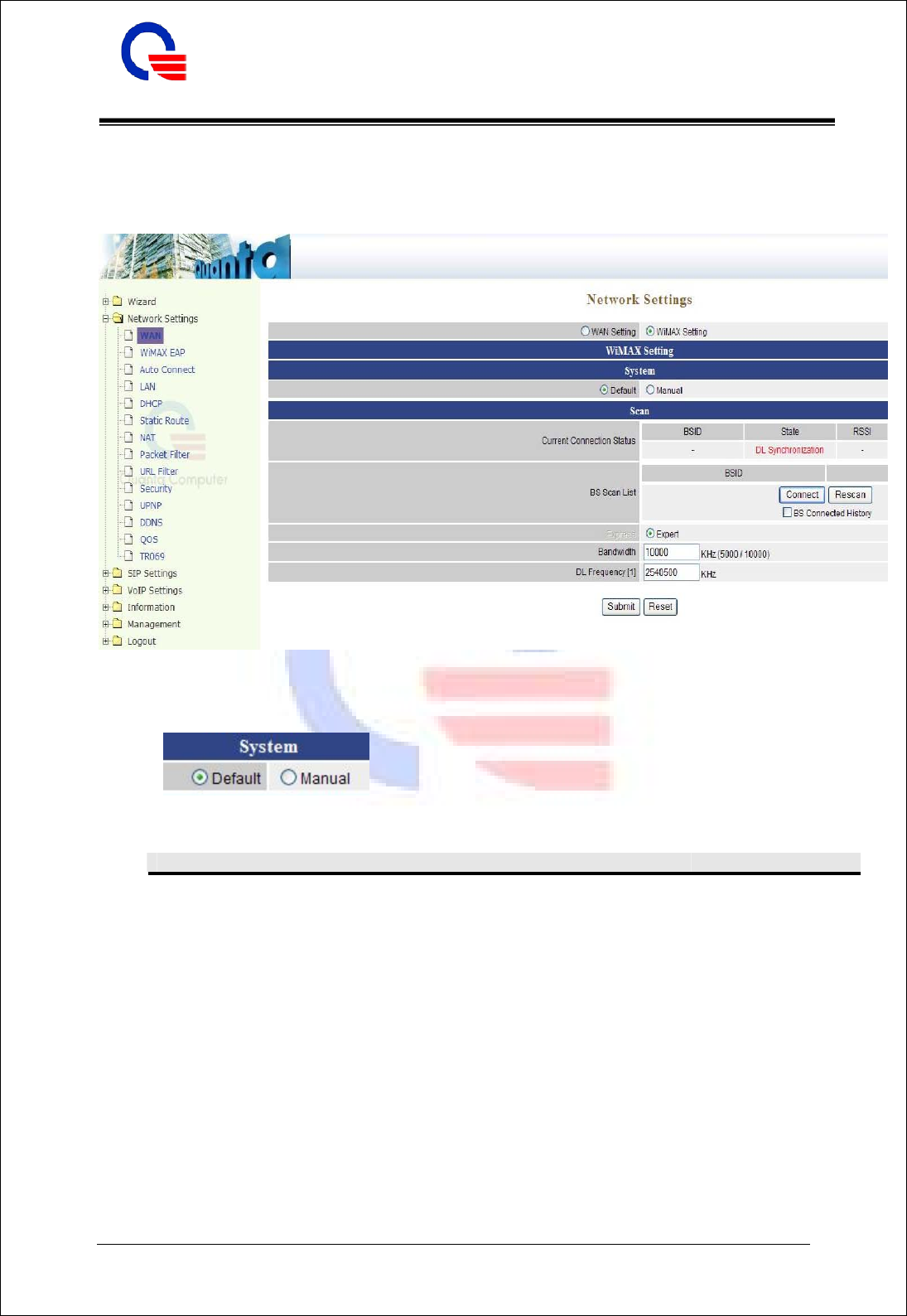
Quanta Computer Inc. IEEE802.16e WiMAX IAD (WV202)
User Manual
211, Wen Hwa 2nd Rd., Kuei Shan Hsiang, CONFIDENTIAL
Tao Yuan Shien, Taiwan, R.O.C. Classification: proprietary information
http://www.quantatw.com
20
3.1.2 WiMAX Setting
The WiMAX settings for connecting to BS are described in this section. You can set the WiMAX
bandwidth and DL frequency from your ISP and to scan the BS to show how many BS can be found to
connect.
¾ System page
To set the OFDM and the gap time of TTG and RTG has two methods.
a. Default mode
In default mode, the default settings of the OFDM, TTG gap time and RTG gap time are as
below.
Field Description Default value
OFDM To input the FFT size in this field. The FFT size can be
512 or 1024 according to bandwidth is 5 MHz or 10 MHz.
1024
Gap Time TTG Transmit/receive Transition Gap (TTG) is defined as the
time between end of the last sample of the last
OFDM-symbol of the UL and the start of the first sample
of the preamble of the following DL frame.
50 micro seconds
Gap Time RTG Receive/transmit Transition Gap (RTG) is defined as the
time between end of the last sample of the last
OFDM-symbol of the DL and the start of the first sample
of the first OFDM-symbol of the UL frame
50 micro seconds
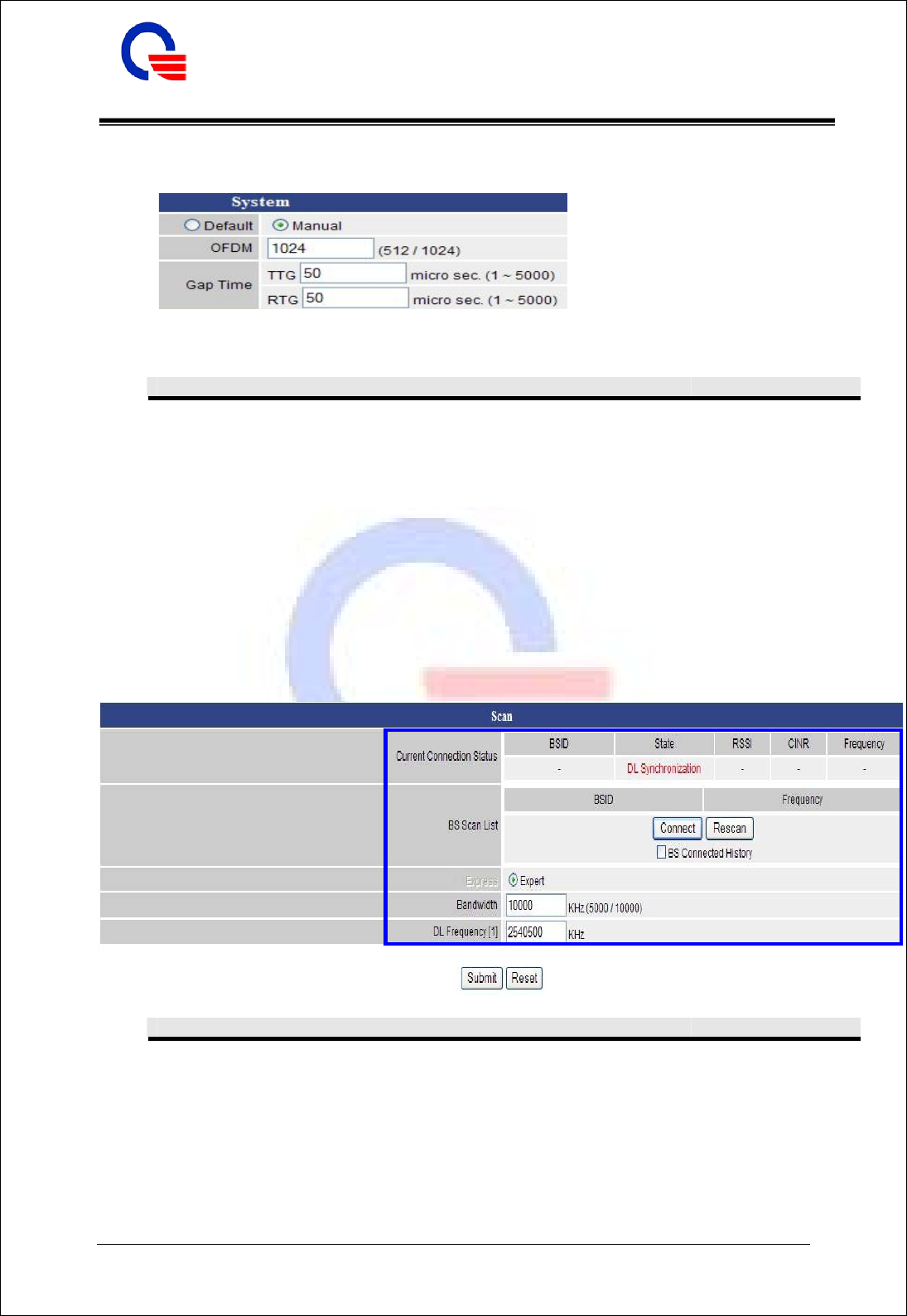
Quanta Computer Inc. IEEE802.16e WiMAX IAD (WV202)
User Manual
211, Wen Hwa 2nd Rd., Kuei Shan Hsiang, CONFIDENTIAL
Tao Yuan Shien, Taiwan, R.O.C. Classification: proprietary information
http://www.quantatw.com
21
b. Manual mode
To manual set the following parameters for gap time and OFDM size to change
different bandwidth responding BS.
Field Description Default value
OFDM To input the FFT size in this field. The FFT size can be
512 or 1024 according to bandwidth is 5 MHz or 10 MHz.
1024
Gap Time TTG Transmit/receive Transition Gap (TTG) is defined as the
time between end of the last sample of the last
OFDM-symbol of the UL and the start of the first sample
of the preamble of the following DL frame.
50 micro seconds
Gap Time RTG Receive/transmit Transition Gap (RTG) is defined as the
time between end of the last sample of the last
OFDM-symbol of the DL and the start of the first sample
of the first OFDM-symbol of the UL frame
50 micro seconds
¾ Scan page
Field Description Default value
Current
Connection Status To show the information of the connected BS. It shows the
BSID, State, RSSI, CINR, and Frequency data.
BS Scan List To show the BS list you scan with the DL frequency.
Bandwidth To set the Bandwidth for 5000 KHz (5 MHz) or 10000 (10
MHz) KHz by according to BS setting.
10000
DL Frequency[1] To set the frequency from 2496000 KHz to 2699800 KHz
by according to BS setting. 2540500
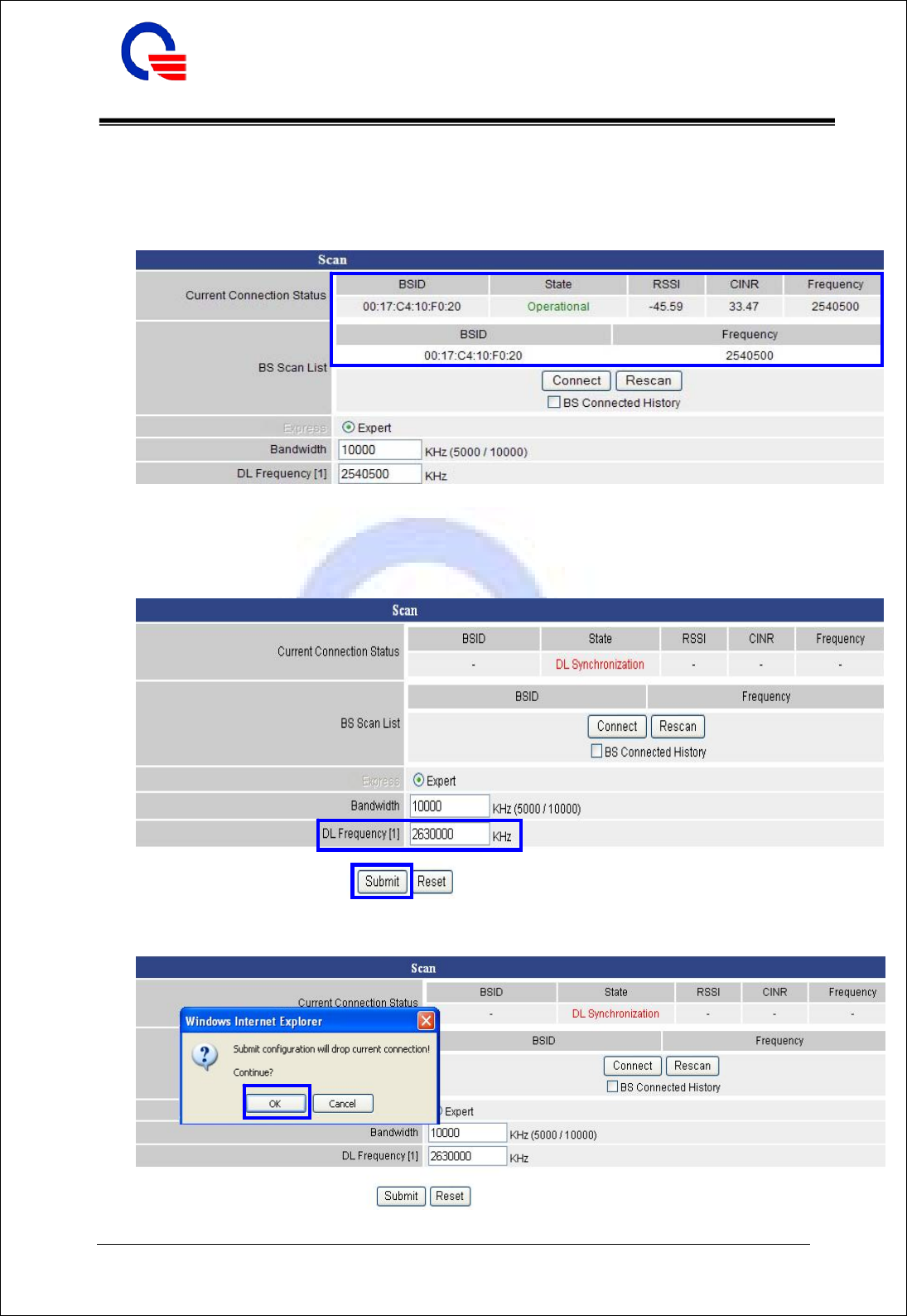
Quanta Computer Inc. IEEE802.16e WiMAX IAD (WV202)
User Manual
211, Wen Hwa 2nd Rd., Kuei Shan Hsiang, CONFIDENTIAL
Tao Yuan Shien, Taiwan, R.O.C. Classification: proprietary information
http://www.quantatw.com
22
To auto scan the BS is enabled as default setting, if the frequency of BS is the same with
default setting 2540500 KHz, the BS will be auto scanned and shown in the BS scan list. Then
the system will auto connects to the BS and shows the information of connected BS like as the
figure below.
If the frequency of BS is not the same with default setting, or you want to change BS with
another frequency, please follow the steps as below.
Step1. Setting the frequency from your ISP provider to the DL frequency[1] field. Then click the
“Submit” button to let it work. See the figure as below.
Step2. Then it will show the message to drop current connection like as below. Please click “OK”
button to continue.
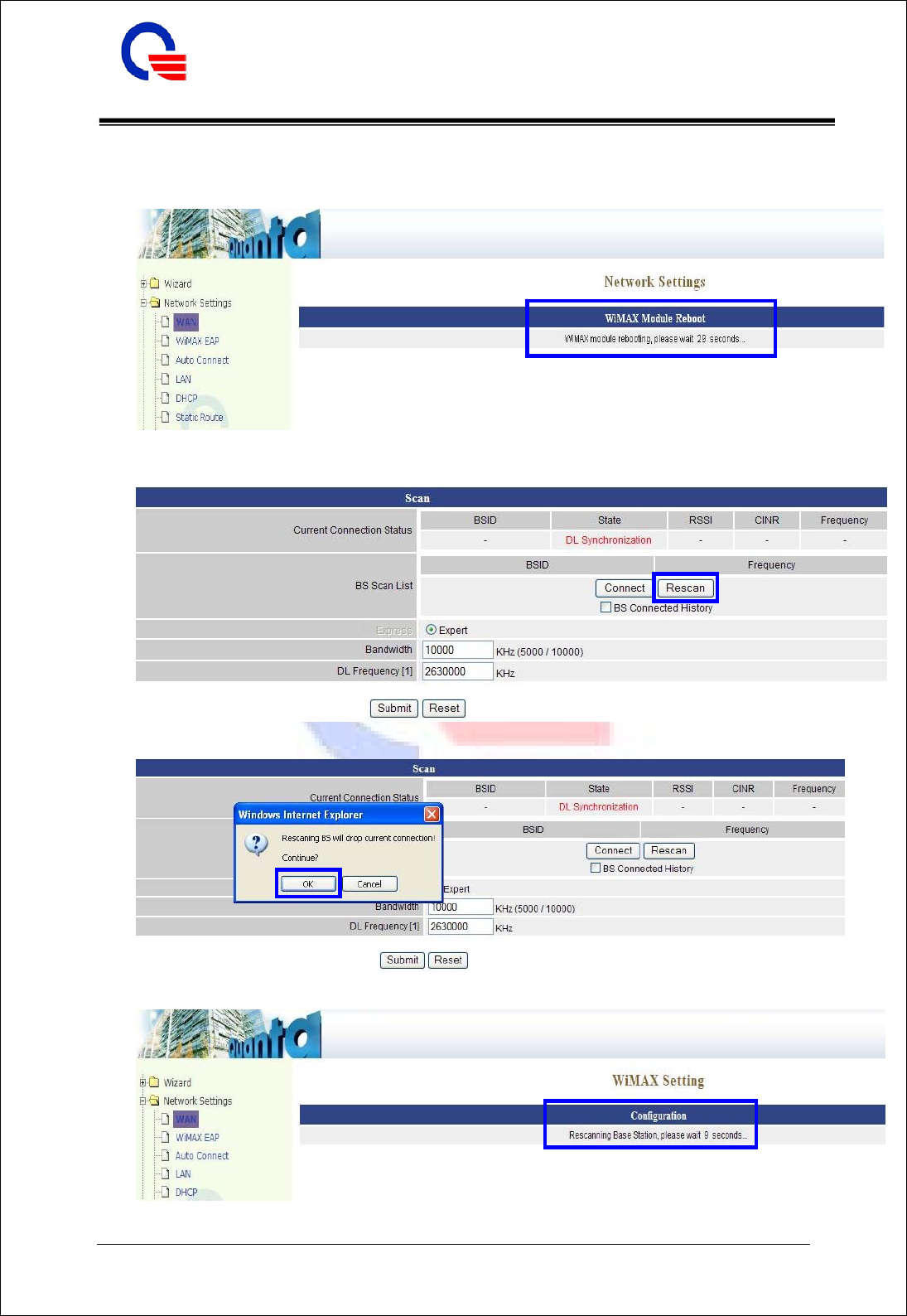
Quanta Computer Inc. IEEE802.16e WiMAX IAD (WV202)
User Manual
211, Wen Hwa 2nd Rd., Kuei Shan Hsiang, CONFIDENTIAL
Tao Yuan Shien, Taiwan, R.O.C. Classification: proprietary information
http://www.quantatw.com
23
Step3. After changing the frequency, the WiMAX card will reboot. Please wait 30 seconds for
rebooting.
Step4. It will go back to the setting page. If there is no BS scanned in the BS scan list, please click
“Rescan” button to rescan BS.
Step5. It will show the message to drop current connection, please click “OK” button.
Step6. Please wait for rescanning about 10 seconds.
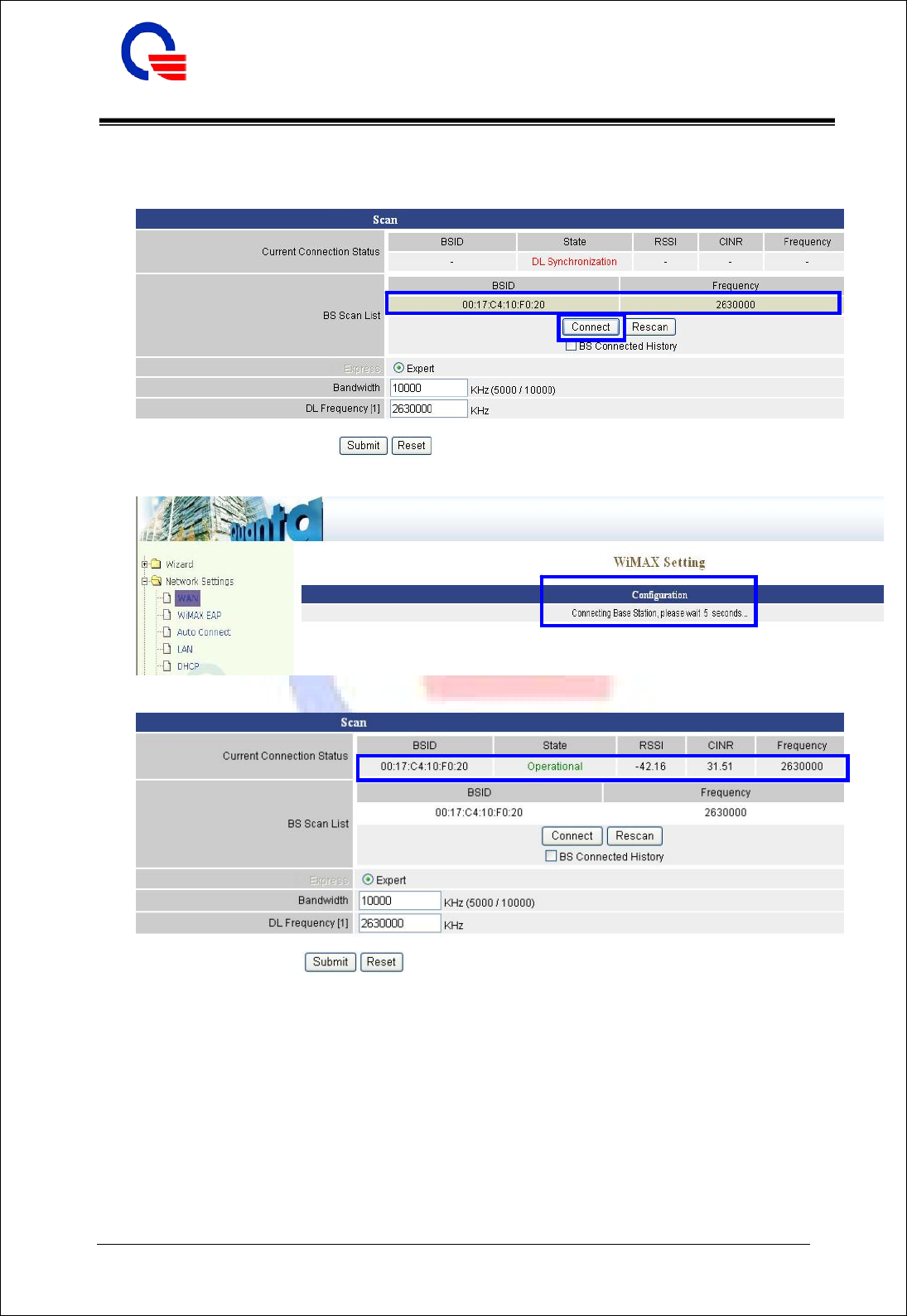
Quanta Computer Inc. IEEE802.16e WiMAX IAD (WV202)
User Manual
211, Wen Hwa 2nd Rd., Kuei Shan Hsiang, CONFIDENTIAL
Tao Yuan Shien, Taiwan, R.O.C. Classification: proprietary information
http://www.quantatw.com
24
Step7. If there is no BS scanned, please repeat from step 4 to step 6 to rescan it; if the BS is scanned,
it will be shown in the BS scan list. Please click the BSID of the scanned BD to mark the data, then
click “Connect” button to connect the BS.
Step8. Please wait for connecting BS about 5 seconds.
Step9. It will connect to the BS and show the connection status “Operational”.
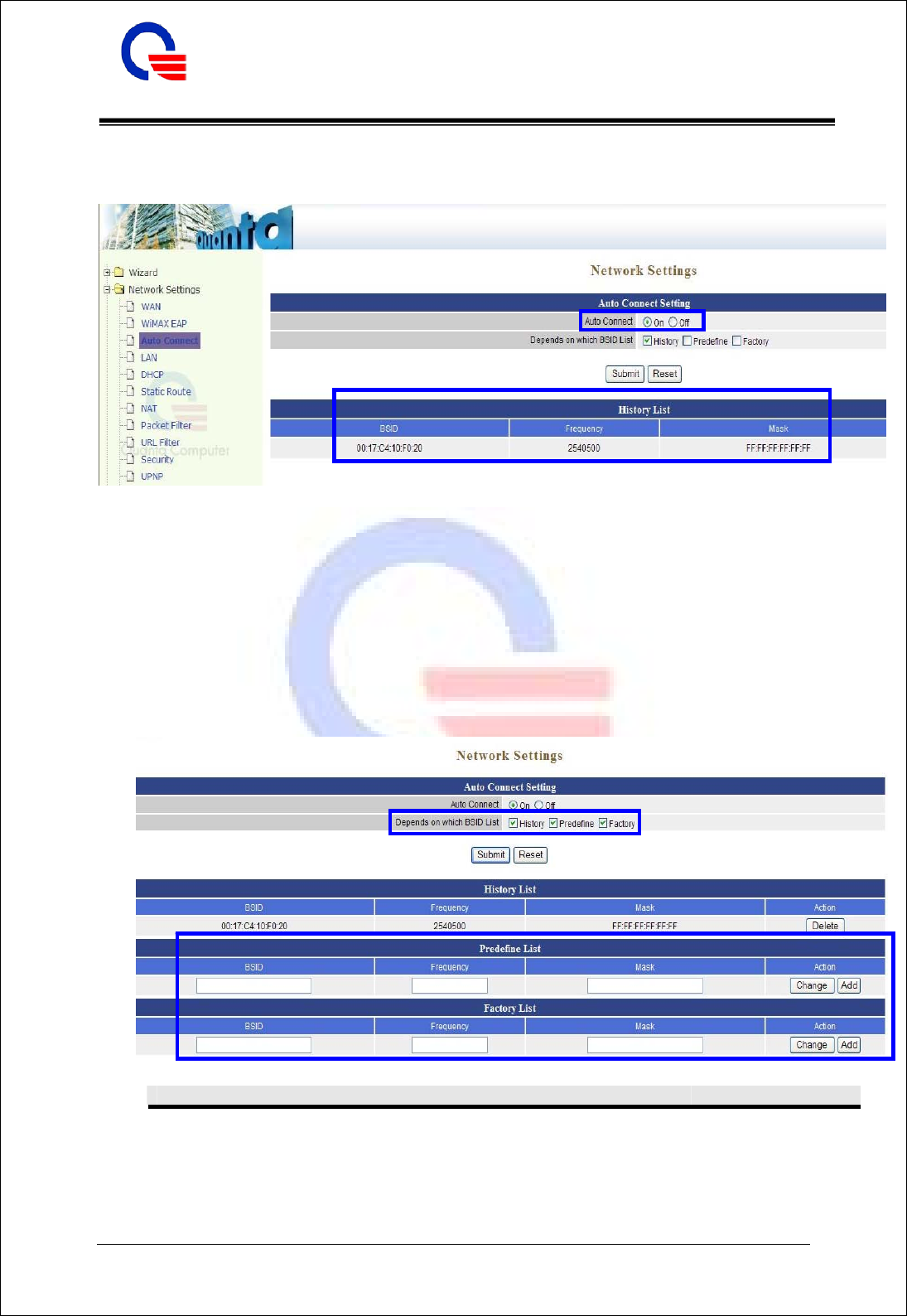
Quanta Computer Inc. IEEE802.16e WiMAX IAD (WV202)
User Manual
211, Wen Hwa 2nd Rd., Kuei Shan Hsiang, CONFIDENTIAL
Tao Yuan Shien, Taiwan, R.O.C. Classification: proprietary information
http://www.quantatw.com
25
3.2 Auto Connect
The Auto connect function will let IAD auto connect to WiMAX BS after booting up. There are some
rules when you enable and disable this function.
If the Auto Connect button is “On”, WiMAX will try to connect with BS automatically.
The default value of Auto Connect setting is “On”, if you rescan BS and connect to BS manual,
the setting will be changed to “Off”.
If the BSID list is by “History”, WiMAX IAD will connect to those BSs in the History list
firstly.
If several BSID entries in the history list, WiMAX IAD will connect to the BS which has the
best CINR.
The BS will be auto added in the history list after IAD has connected to the BS.
You can manual add BS in the predefine list and factory list by enable “Predefine” and
“Factory” function in the “Depends on which BSID List” field. See as below figure.
Field Description Default value
BSID Input the BS’s BSID provided by ISP
Frequency Input the BS’s frequency provided by ISP
Mask Input the BS’s mask provided by ISP
Change Click this button to change the data of existed BS
Add Click this button to add the data of BS
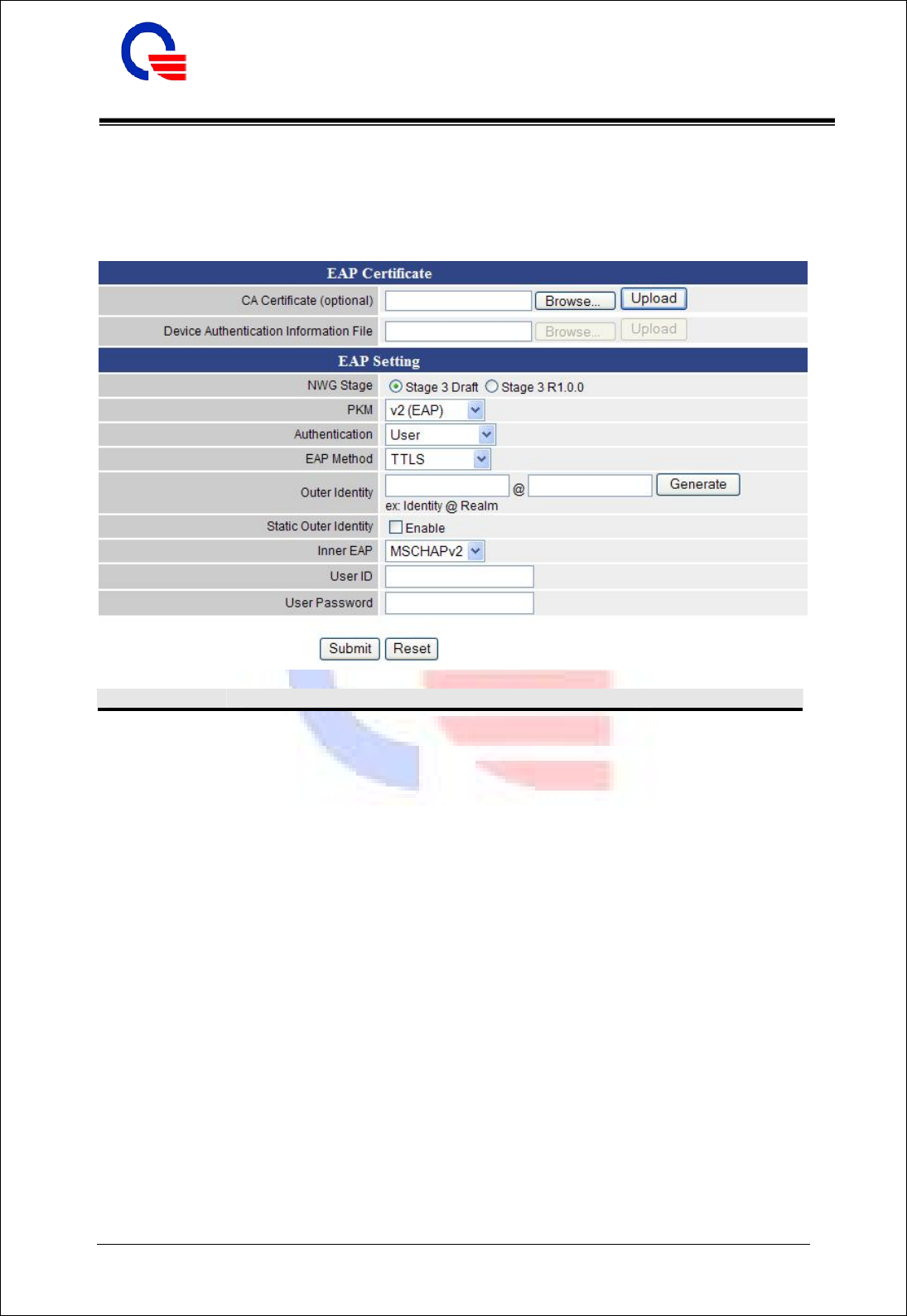
Quanta Computer Inc. IEEE802.16e WiMAX IAD (WV202)
User Manual
211, Wen Hwa 2nd Rd., Kuei Shan Hsiang, CONFIDENTIAL
Tao Yuan Shien, Taiwan, R.O.C. Classification: proprietary information
http://www.quantatw.com
26
3.3 WiMAX EAP
EAP is used to communicate authentication information between the Supplicant and the
Authentication Server. When you connect to BS with EAP authorization, an AAA (Authentication
Authorization Accounting) server behind BS will confirm your authentication information, authorization
and accounting.
Field Description Default value
CA Certificate
(optional) To upload the CA certificate file provided by ISP when
you select “User” or “User / Device” authentication. The
CA certificate file is optional but depends on the AAA
server request.
Device
Authentication
Information File
To upload the device authentication information file
provided by ISP when you select “Device” and “User /
Device” authentication.
NWG Stage There are two stage of NWG (Network Working Group)
to select. Base on the BS setting to select “Stage 3 Draff”
or “Stage 3 R1.0.0”
Stage 3 Draff
PKM Select “No PKM” (Private Key Management) or
“v2(EAP)” for communicating with BS.
No PKM
Authentication Three types to authenticate with AAA server or Radius
server. “User” or “Device” or “User / Device”
User
EAP Method Select TTLS (Technical Translation &
Localization Services) Method or AKA (Authentication
and Key Agreement) Method
TTLS
Outer Identity The identity of this IAD to communicate with BS.
It can be auto generated by clicking “Generate” button or
can be set with any string between 16 bytes to 48 bytes
manual. And the string only can be the combination with
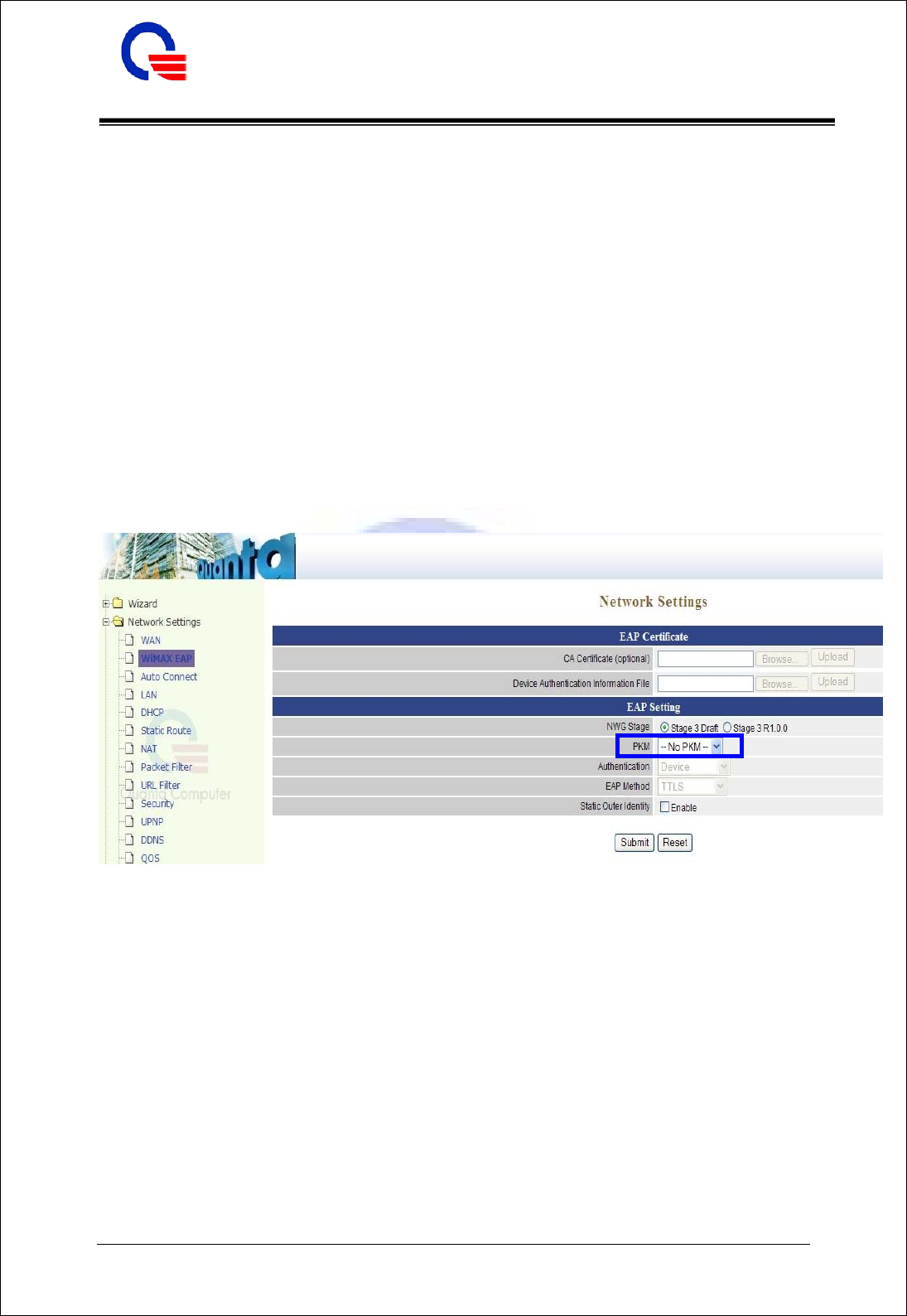
Quanta Computer Inc. IEEE802.16e WiMAX IAD (WV202)
User Manual
211, Wen Hwa 2nd Rd., Kuei Shan Hsiang, CONFIDENTIAL
Tao Yuan Shien, Taiwan, R.O.C. Classification: proprietary information
http://www.quantatw.com
27
numeral letters and English letters in lower case and upper
case. Input the domain name in the filed after “@”.
Static Outer
Identity You can input any string which length is no limit when it
is enable. The string can be set with any string between 16
bytes to 48 bytes manual. And the string only can be the
combination with numeral letters and English letters in
lower case and upper case.
Disable
Inner EAP There are 4 Inner EAP (Extensible Authentication
Protocol) to select. “MSCHAPv2” / “MSCHAP” /
“CHAP” / “PAP”
MSCHAPv2
User ID Input the user ID provided by ISP
User Password Input the user password provided by ISP
There are fore types for EAP setting to communicate authentication information with BS.
¾ Type1: No PKM setting
The WiAMX IAD connects to BS without any authentication.
¾ Type2: V2(EAP) with “User” authentication
In this type, there are two methods to communicate authentication information with BS.
TTLS (Technical Translation & Localization Services) Method
Input the marked fields as below.
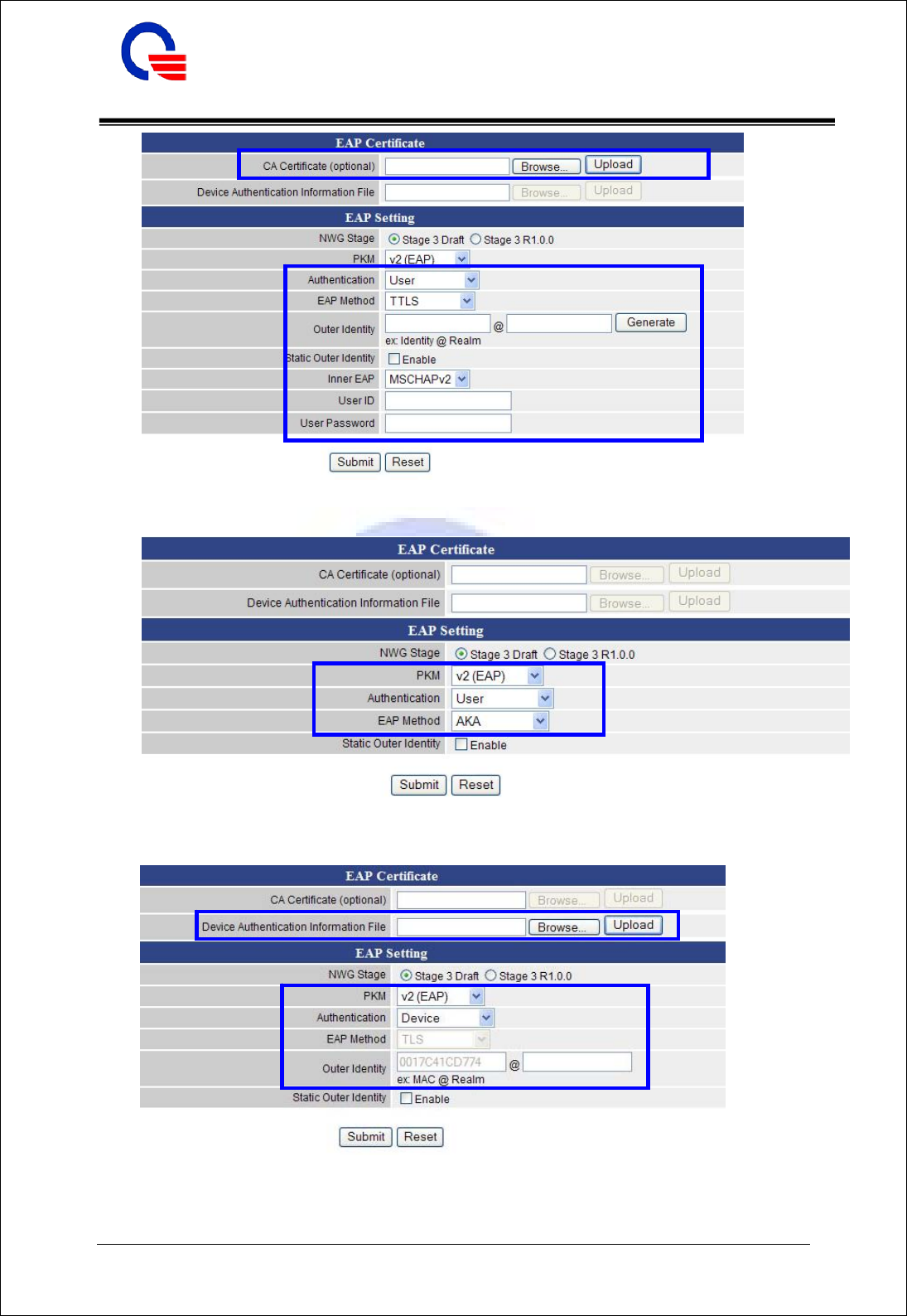
Quanta Computer Inc. IEEE802.16e WiMAX IAD (WV202)
User Manual
211, Wen Hwa 2nd Rd., Kuei Shan Hsiang, CONFIDENTIAL
Tao Yuan Shien, Taiwan, R.O.C. Classification: proprietary information
http://www.quantatw.com
28
AKA (Authentication and Key Agreement) Method
Input the marked fields as below.
¾ Type3: V2(EAP) with “Device” authentication
Input the marked fields as below.
¾ Type4: V2(EAP) with “User / Device” authentication
Input the marked fields as below.
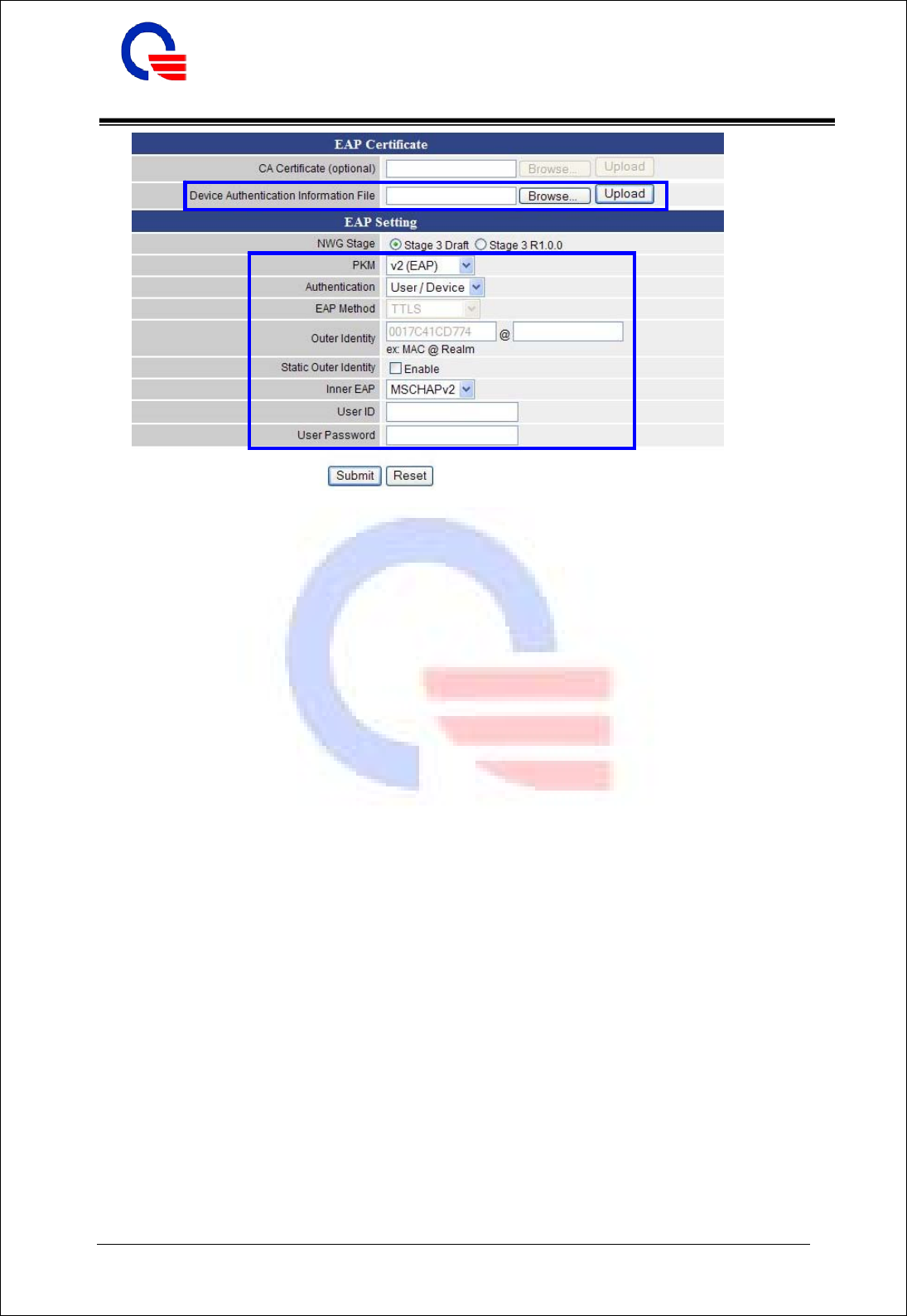
Quanta Computer Inc. IEEE802.16e WiMAX IAD (WV202)
User Manual
211, Wen Hwa 2nd Rd., Kuei Shan Hsiang, CONFIDENTIAL
Tao Yuan Shien, Taiwan, R.O.C. Classification: proprietary information
http://www.quantatw.com
29
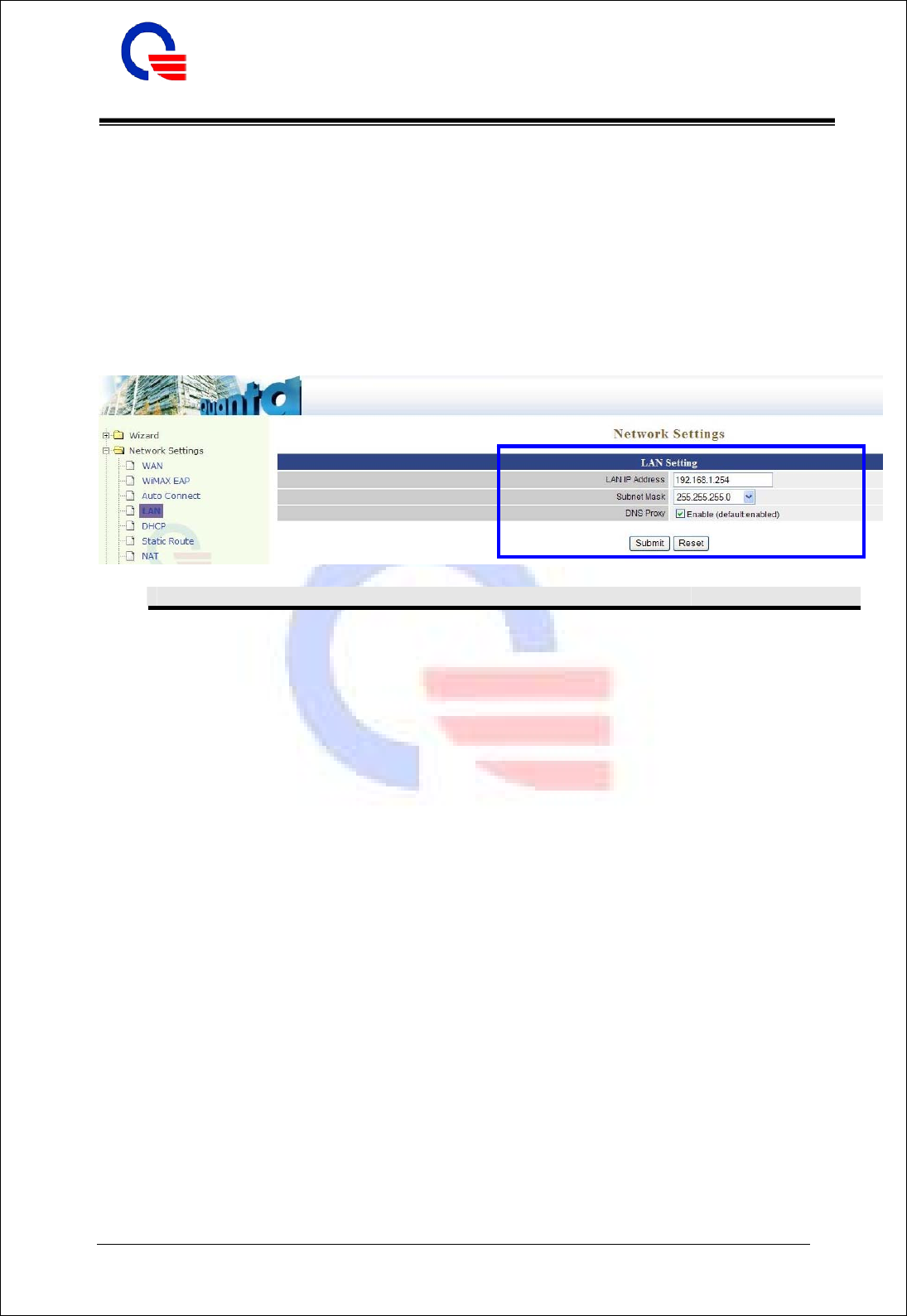
Quanta Computer Inc. IEEE802.16e WiMAX IAD (WV202)
User Manual
211, Wen Hwa 2nd Rd., Kuei Shan Hsiang, CONFIDENTIAL
Tao Yuan Shien, Taiwan, R.O.C. Classification: proprietary information
http://www.quantatw.com
30
3.4 LAN Setting
These are the IP settings of the LAN (Local Area Network) interface for the device. These settings may be
referred to as "private settings". You may change the LAN IP address if needed. The LAN IP address is
private to your internal network and cannot be seen on the Internet. The default IP address is
192.168.1.254 with a subnet mask of 255.255.255.0.
LAN is a network of computers or other devices that are in relatively close range of each other. For
example, devices in a home or office building would be considered part of a local area network.
LAN IP Address: Assign the IP address of LAN server, default is 192.168.1.254
Subnet Mask: Select a subnet mask from the pull-down menu, default is 255.255.255.0.
Field Description Default value
LAN IP Address Input the LAN IP address
192.168.1.254
Subnet Mask Select the subnet mask
255.255.255.0
DNS Proxy Enable / Disable the DNS proxy function
Enable
3.4.1 DNS Proxy
A proxy server is a computer network service that allows clients to make indirect network connections to
other network services. The default setting is Enable the DNS proxy server.
Enable the DNS Proxy which will relay users’/clients’ DNS requests to a real DNS server IP address.
Users no need to specify real DNS server IP address.
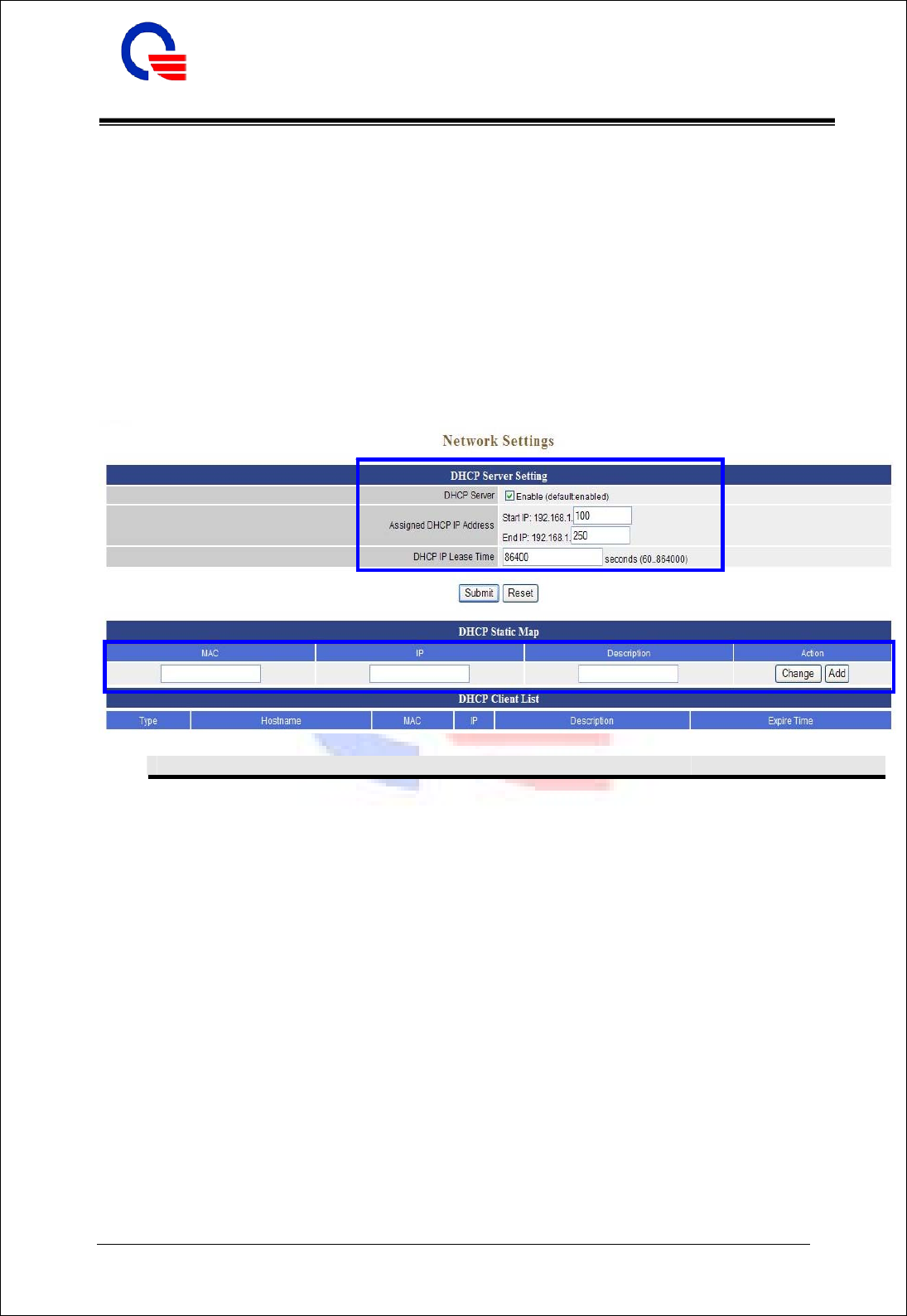
Quanta Computer Inc. IEEE802.16e WiMAX IAD (WV202)
User Manual
211, Wen Hwa 2nd Rd., Kuei Shan Hsiang, CONFIDENTIAL
Tao Yuan Shien, Taiwan, R.O.C. Classification: proprietary information
http://www.quantatw.com
31
3.5 DHCP
3.5.1 DHCP Server
DHCP stands for Dynamic Host Control Protocol. The DHCP server gives out IP addresses when a device
is starting up and request an IP address to be logged on to the network. The device must be set as a DHCP
client to "Obtain the IP address automatically". By default, the DHCP Server is enabled in the unit. The
DHCP address pool contains the range of the IP address that will automatically be assigned to the clients
on the network.
DHCP client computers connected to the unit will have their information displayed in the DHCP Client
List table. The table will show the Type, Host Name, IP Address, MAC Address, Description, and Expired
Time of the DHCP lease for each client computer.
Field Description Default value
DHCP Server Enable or Disable the DHCP server to dynamic release IP to
the connected client in LAN.
Enable
Assigned DHCP
IP Address Enter the starting IP address for the DHCP server’s IP
assignment and the ending IP address for the DHCP server’s
IP assignment.
Start IP: 192.168.1.100
End IP: 192.168.1.250
DHCP IP Lease
Time Assign the length of time for the IP lease, default setting is
86400 seconds.
86400
MAC Input the MAC address of the client which you want to add.
IP Input the IP address of the client which you want to add.
Description Input the description of the client which you want to add.
Change Click “Change” button to change the data for existed map.
Add Click “Add” button to add the DHCP static mapping data.
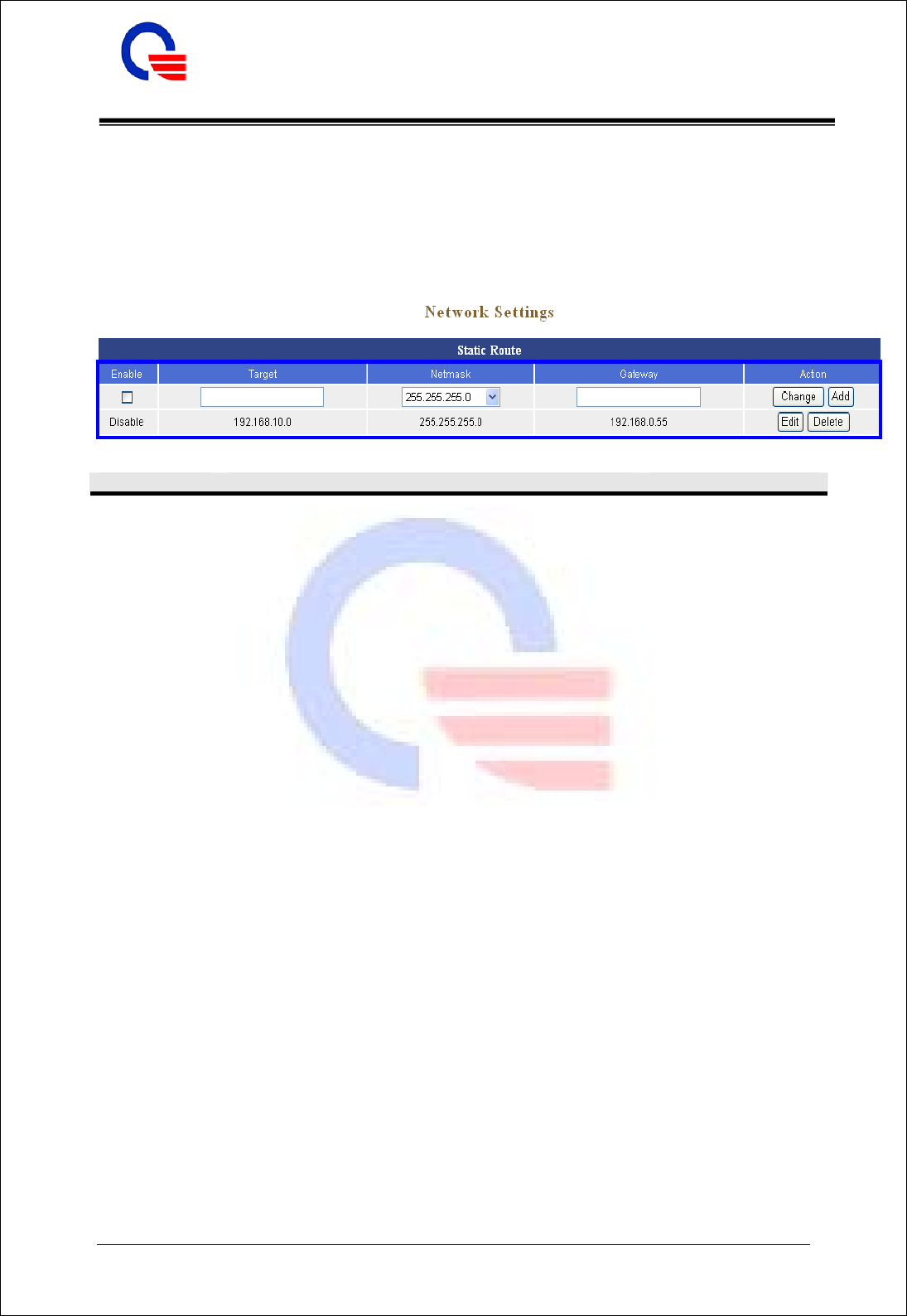
Quanta Computer Inc. IEEE802.16e WiMAX IAD (WV202)
User Manual
211, Wen Hwa 2nd Rd., Kuei Shan Hsiang, CONFIDENTIAL
Tao Yuan Shien, Taiwan, R.O.C. Classification: proprietary information
http://www.quantatw.com
32
3.6 Static Route
Static routes are special routes that the network administrator manually enters into the router configuration.
You could build an entire network based on static routes. The problem with doing this is that when a
network failure occurs, the static route will not change without you performing the change. This isn’t a
good thing if the failure occurs during the middle of the night, or while you are on vacation.
The routing table allows the user to configure and define all the static routes supported by the router.
Field Description Default value
Enable Enable/Disable the static route.
Disable
Target Defines the base IP address (Network Number) that will be
compared with the destination IP address (after an AND with
NetMask) to see if this is the target route.
Netmask The subnet mask that will be AND'd with the destination IP
address and then compared with the Target to see if this is
the target route.
255.255.255.0
Gateway The IP address of the next hop router that will be used to
route traffic for this route. If this route is local (defines the
locally connected hosts and Type = Host) then this IP
address MUST be the IP address of the router Action – Insert
a new Static Route entry or update a specified entry
Change Click “Change” button to modify one of the list routes and
to change the value.
Add Click “Add” button to add more routes for different target
domain
Edit Click “Edit” button to edit the route date.
Delete Click “Delete” button to delete the unneeded routes.
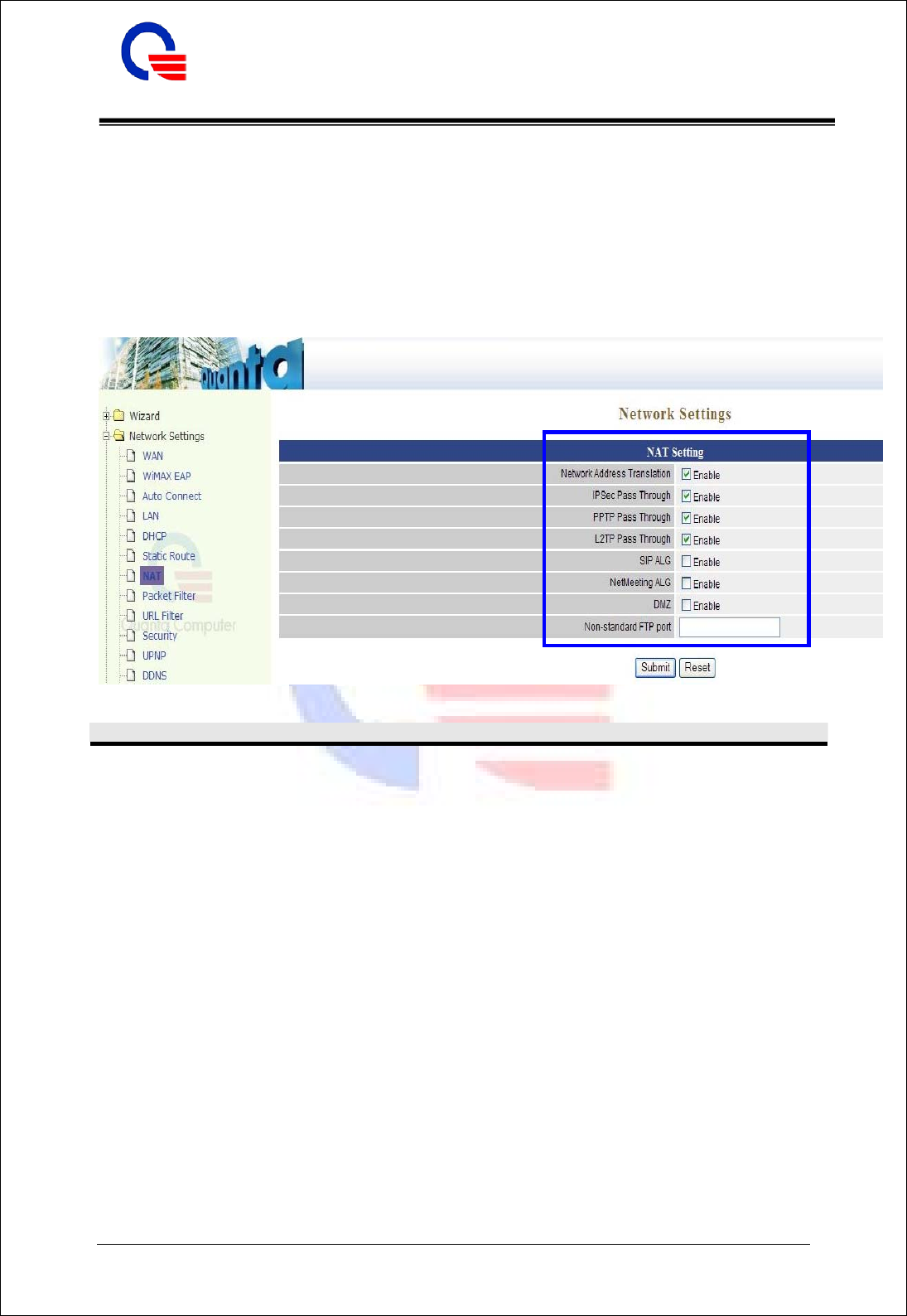
Quanta Computer Inc. IEEE802.16e WiMAX IAD (WV202)
User Manual
211, Wen Hwa 2nd Rd., Kuei Shan Hsiang, CONFIDENTIAL
Tao Yuan Shien, Taiwan, R.O.C. Classification: proprietary information
http://www.quantatw.com
33
3.7 NAT
NAT (Network Address Translation) serves three purposes:
1. Provides security by hiding internal IP addresses. Acts like firewall.
2. Enables a company to access internal IP addresses. Internal IP addresses that are only
available within the company will not conflict with public IP.
3. Allows a company to combine multiple ISDN connections into a single internet connection.
3.7.1 NAT Setting
Field Description Default value
Network Address
Translation
Enable/Disable NAT. Enable
IPSec Pass Through IPsec (Internet Protocol Security) is a framework for a
set of protocols for security at the network or packet
processing layer of network communication.
Enable/Disable this framework verification
Enable
PPTP Pass Through PPTP (Point-to-Point Tunneling Protocol) is a protocol
that allows corporations to extend their own corporate
network through private "tunnels" over the public
Internet. Enable/Disable this protocol verification.
Enable
L2TP Pass Through L2TP (The Layer 2 Tunnel Protocol) is an emerging
Internet Engineering Task Force (IETF) standard that
combines the best features of two existing tunneling
protocols: Cisco's Layer 2 Forwarding (L2F) and
Microsoft's Point-to-Point Tunneling Protocol (PPTP).
L2TP is an extension to the Point-to-Point Protocol
(PPP), which is an important component for VPNs.
VPNs allow users and telecommuters to connect to their
corporate intranets or extranets. Enable/Disable this
function.
Enable
SIP ALG SIP (Session Initiation Protocol) is a signaling protocol Disable
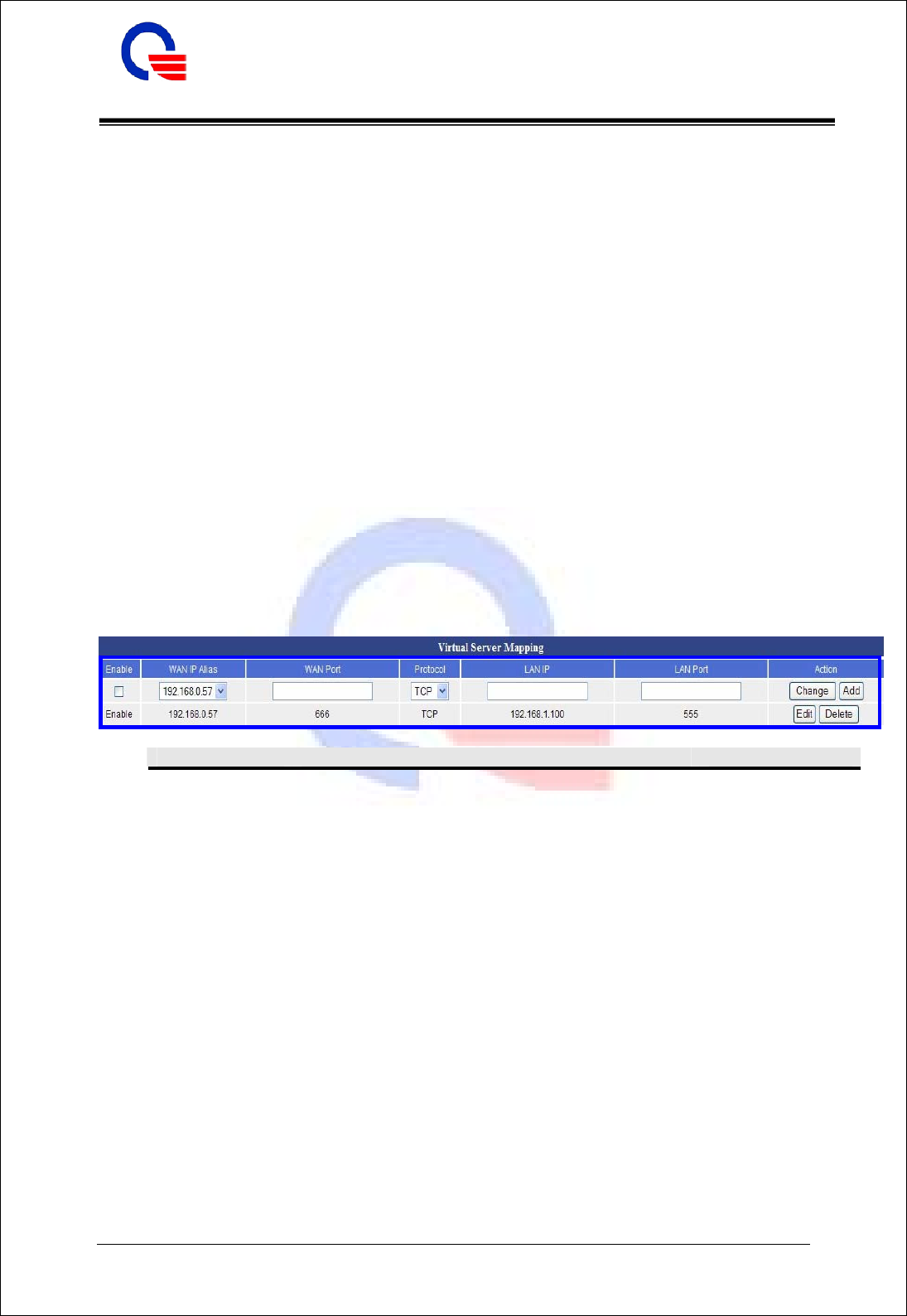
Quanta Computer Inc. IEEE802.16e WiMAX IAD (WV202)
User Manual
211, Wen Hwa 2nd Rd., Kuei Shan Hsiang, CONFIDENTIAL
Tao Yuan Shien, Taiwan, R.O.C. Classification: proprietary information
http://www.quantatw.com
34
3.7.2 Virtual Server Mapping
The device can be configured as a virtual server so that remote users accessing services such as Web or
FTP services via the public (WAN) IP address can be automatically redirected to local servers in the LAN
network. Depending on the requested service (TCP/UDP port number), the device redirects the external
service request to the appropriate server within the LAN network. You will only need to input the LAN IP
address of the computer running the service and enable it.
A Virtual Server is defined as a service port, and all requests to this port will be redirected to the computer
specified by the server IP.
Field Description Default value
Enable Enable/Disable the virtual server mapping, default setting
is Disable
Disable
WAN IP Alias Select which WAN IP address to mapping local IP
address.
WAN Port The port number on the WAN side that will be used to
access the virtual service. Enter the WAN Port number,
e.g. enter 80 to represent the Web (http server), or enter 25
to represent SMTP (email server). Note: You can specify
maximum 32 WAN Ports.
Protocol The protocol used for the virtual service. Select a protocol
type is TCP or UDP.
TCP
LAN IP The server computer in the LAN network that will be
providing the virtual services. Enter the IP address of
LAN.
LAN Port The port number of the service used by the Private IP
computer. Enter the LAN port number.
Change Click change button to modify an existed mapping item.
for Internet conferencing, telephony, presence, events
notification and instant messaging. Enable/Disable this
protocol verification.
NetMeeting ALG Enable or disable to support or not support NetMeeting
packets. Disable
DMZ In computer networks, a DMZ (Demilitarized Zone) is a
computer host or small network inserted as a "neutral
zone" between a company's private network and the
outside public network. It prevents outside users from
getting direct access to a server that has company data.
Disable
Non-Standard FTP
port Disable
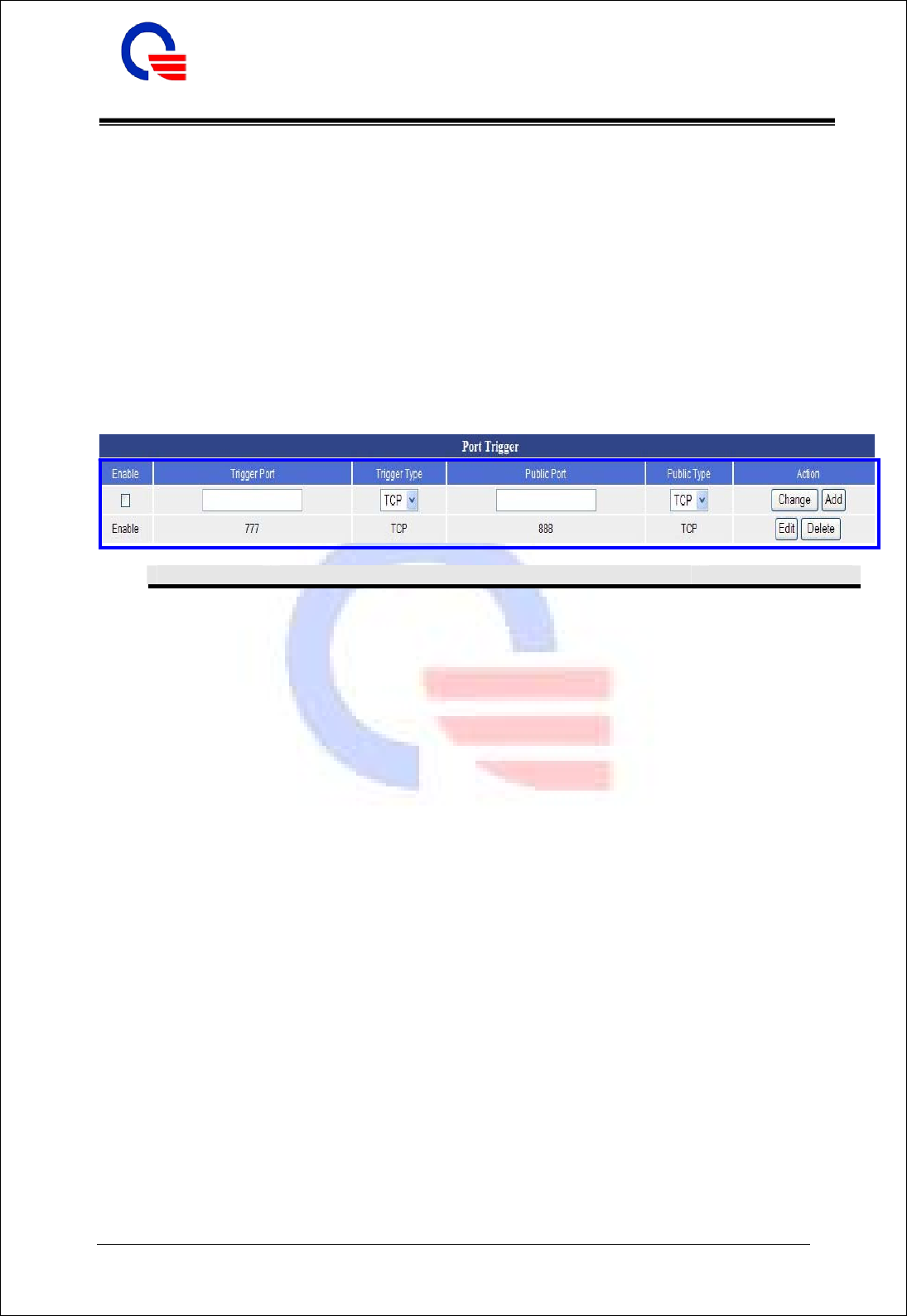
Quanta Computer Inc. IEEE802.16e WiMAX IAD (WV202)
User Manual
211, Wen Hwa 2nd Rd., Kuei Shan Hsiang, CONFIDENTIAL
Tao Yuan Shien, Taiwan, R.O.C. Classification: proprietary information
http://www.quantatw.com
35
Add Click add button to add a new mapping server.
Edit Click edit button to edit the existed item.
Delete Click delete button to delete the unneeded item.
3.7.3 Port Trigger
Some applications require multiple connections, such as Internet gaming, video conferencing, Internet
telephony and others. These applications have difficulties working through NAT (Network Address
Translation). If you need to run applications that require multiple connections, specify the port normally
associated with an application in the "Trigger Port" field, select the protocol type as TCP (Transmission
Control Protocol) or UDP (User Datagram Protocol), then enter the public ports associated with the trigger
port to open them for inbound traffic.
Field Description Default value
Enable Enable/Disable the port trigger, default setting is disabled.
Disable
Trigger Port This is the port used to trigger the application. It can be either
a single port or a range of ports.
Trigger Type This is the protocol used to trigger the special application.
TCP
Public Port This is the port number on the WAN side that will be used to
access the application. You may define a single port or a
range of ports. You can use a comma to add multiple ports or
port ranges.
Public Type This is the protocol used for the special application.
TCP
Change Click change button to modify an existed item.
Add Click add button to add a new item
Edit Click edit button to edit the existed item.
Delete Click delete button to delete the unneeded item.
3.7.4 Port Forward
Port forwarding is the act of forwarding a network port from one network node to another. This technique
can allow an external user to reach a port on a private IP address (inside a LAN) from the outside via a
NAT-enabled router. Port forwarding allows remote computers (e.g. public machines on the Internet) to
connect to a specific computer within a private LAN. The forwarding protocol type can be set in TCP or
UDP protocol.
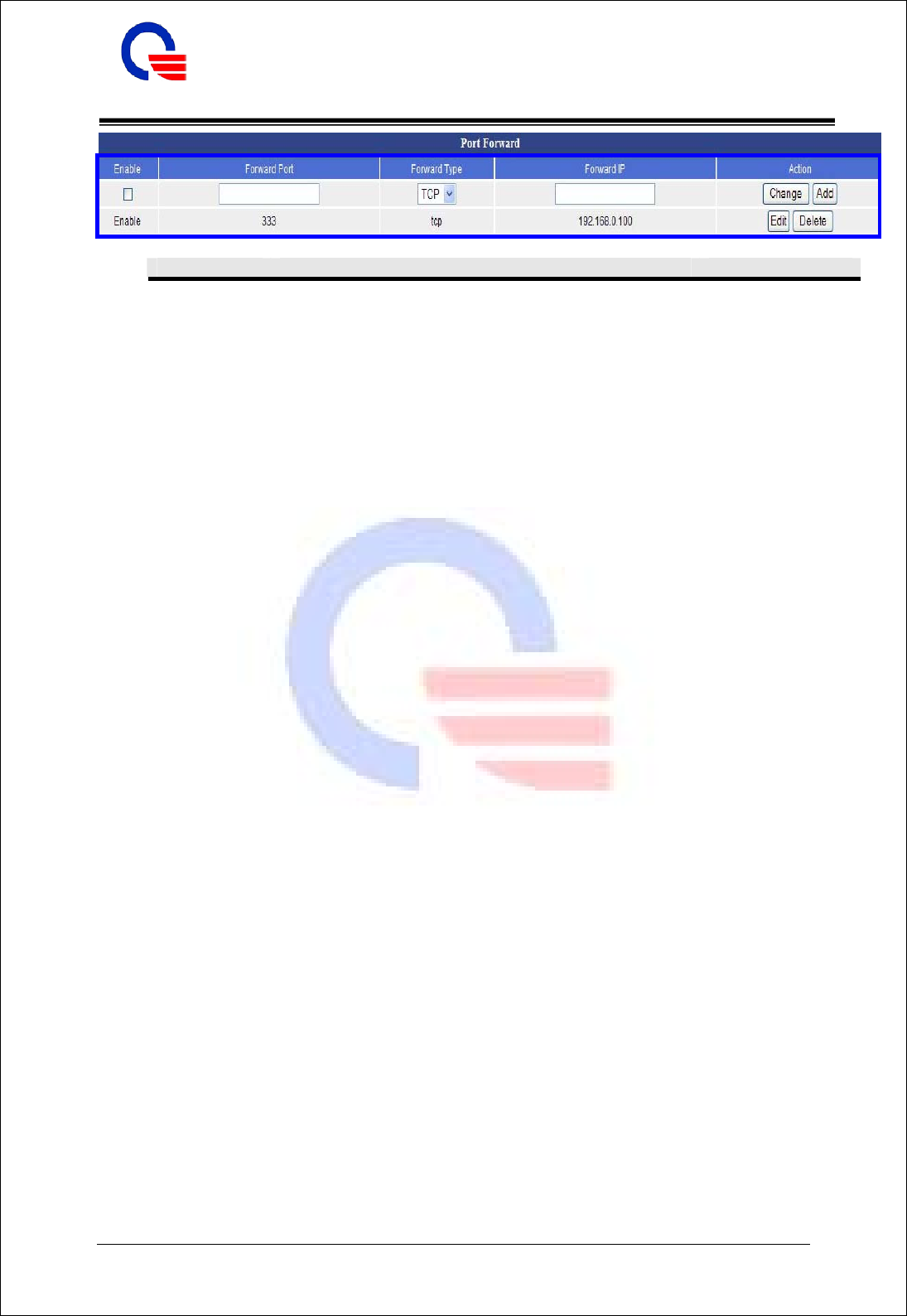
Quanta Computer Inc. IEEE802.16e WiMAX IAD (WV202)
User Manual
211, Wen Hwa 2nd Rd., Kuei Shan Hsiang, CONFIDENTIAL
Tao Yuan Shien, Taiwan, R.O.C. Classification: proprietary information
http://www.quantatw.com
36
Field Description Default value
Enable Enable/Disable the port Forward, default setting is disabled
. Disable
Forward Port This is the port used to forward the packets to a port on a
private IP address in LAN. It can be either a single port or a
range of ports.
Forward Type This is the protocol used to trigger the special application.
TCP
Forward IP The IP address in LAN that you want to forward the packets
to it
Change Click change button to modify an existed item.
Add Click add button to add a new item
Edit Click edit button to edit the existed item.
Delete Click delete button to delete the unneeded item.
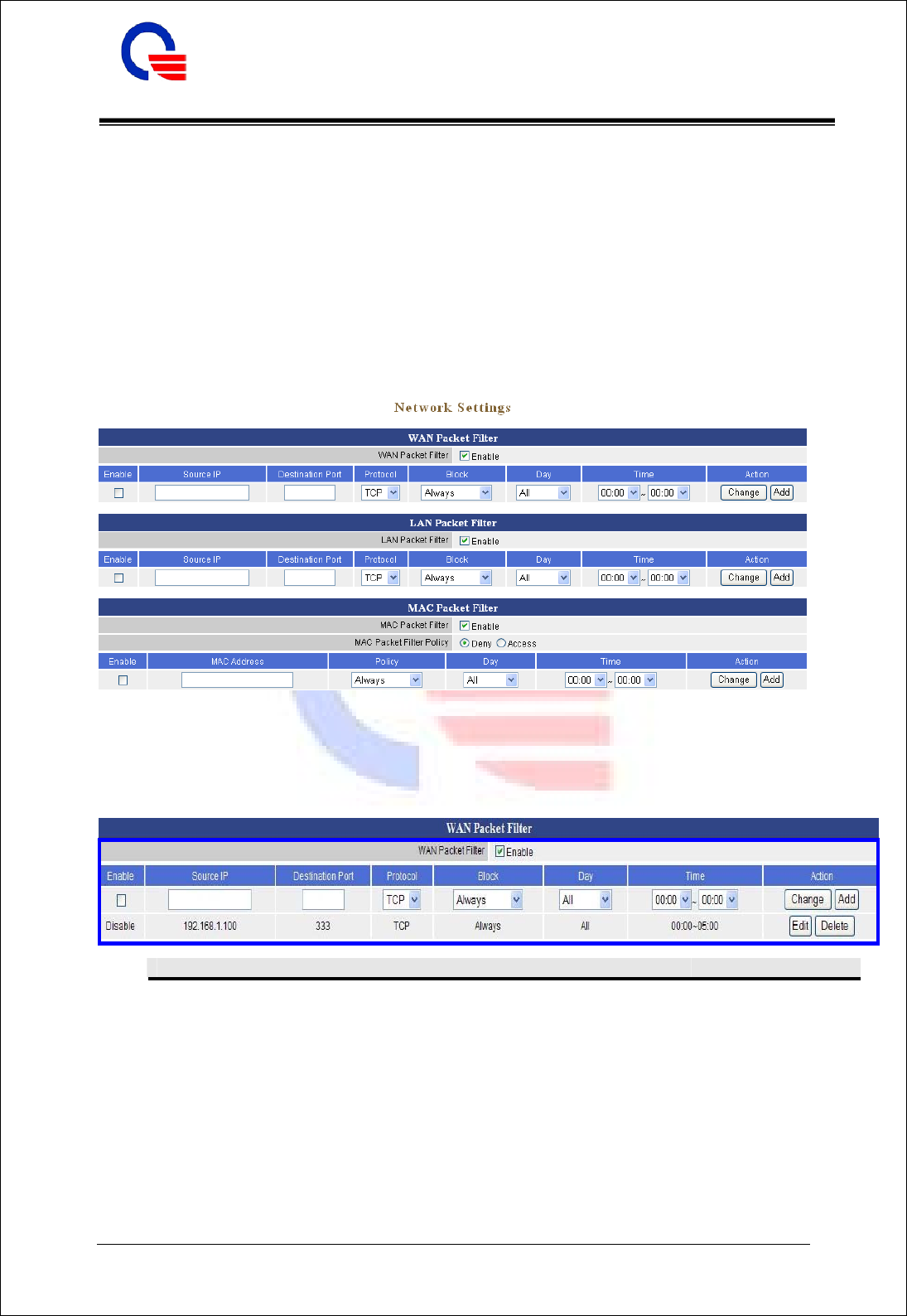
Quanta Computer Inc. IEEE802.16e WiMAX IAD (WV202)
User Manual
211, Wen Hwa 2nd Rd., Kuei Shan Hsiang, CONFIDENTIAL
Tao Yuan Shien, Taiwan, R.O.C. Classification: proprietary information
http://www.quantatw.com
37
3.8 Packet Filter
Filters are used to deny or allow LAN computers from accessing the Internet. Within the local area
network, the unit can be setup to deny Internet access to computers using the assigned IP or MAC
addresses. The unit can also block users from accessing restricted web sites.
This packet filter is used to inspect each packet for user defined content, such as an IP address but does
not track the state of sessions.
It is a feature incorporated into routers and bridges to limit the flow of information based on
predetermined communications such as source, destination, or type of service being provided by the
network. Packet filters let the administrator limit protocol specific traffic to one network segment, isolate
e-mail domains, and perform many other traffic control functions.
WAN Packet Filter
Use IP Filters to deny particular WAN IP addresses from the Internet. You can deny special port number or
all ports for a specific IP address. You will need to input the WAN IP address(es) of the computer(s) that
will be denied, and input which port of WAN side that you want to deny for accessing..
Field Description Default value
WAN Packet
Filter
Enable / Disable the packets filter function in WAN port. Enable
Enable Enable/Disable the WAN packet filter, default setting is
Disable
Disable
Source IP The IP address of the WAN computer that will be denied
access to the Internet. You can also add a range of IP
addresses.
Destination
Port
The single port that will be denied to access.
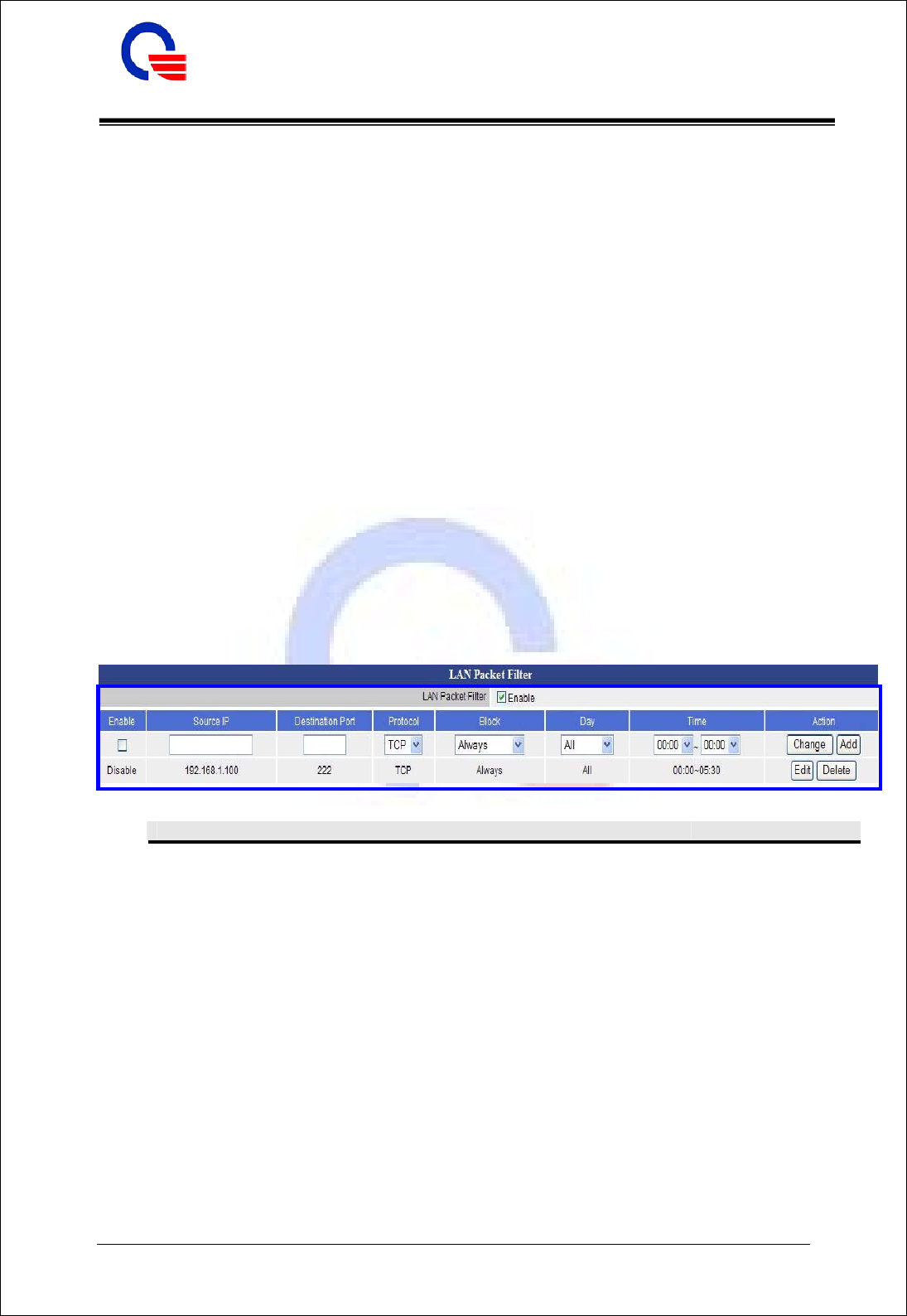
Quanta Computer Inc. IEEE802.16e WiMAX IAD (WV202)
User Manual
211, Wen Hwa 2nd Rd., Kuei Shan Hsiang, CONFIDENTIAL
Tao Yuan Shien, Taiwan, R.O.C. Classification: proprietary information
http://www.quantatw.com
38
Protocol This is the protocol type that will be used with the Port that
will be blocked.
TCP
Block You can block the IP address of the WAN computer always or
by schedule
Always
Day If Block set to “by schedule”, you need to determine which
day(s) will be performed
All
Time If Block set to “by schedule”, you need to determine which
time will be performed
00:00 ~ 00:00
Change Click change button to modify an existed item.
Add Click add button to add a new item
Edit Click edit button to edit the existed item.
Delete Click delete button to delete the unneeded item.
LAN Packet Filter
Use IP Filters to deny particular LAN IP addresses from accessing the Internet. You can deny special port
number for a specific IP address. You will need to input the LAN IP address(es) of the computer(s) that
will be denied Internet access, and input which port of LAN side that you want to deny for accessing..
Field Description Default value
LAN Packet
Filter
Enable / Disable the packets filter function in LAN port. Enable
Enable Enable/Disable the LAN packet filter, default setting is
Disable
Disable
Source IP The IP address of the LAN computer that will be denied
access to the Internet. You can also add a range of IP
addresses.
Destination
Port
The single port that will be denied access to the Internet. If no
port is specified, all ports will be denied access.
Protocol This is the protocol type that will be used with the Port that
will be blocked.
TCP
Block You can block the IP address of the WAN computer always or
by schedule.
Always
Day If Block set to “by schedule”, you need to determine which All
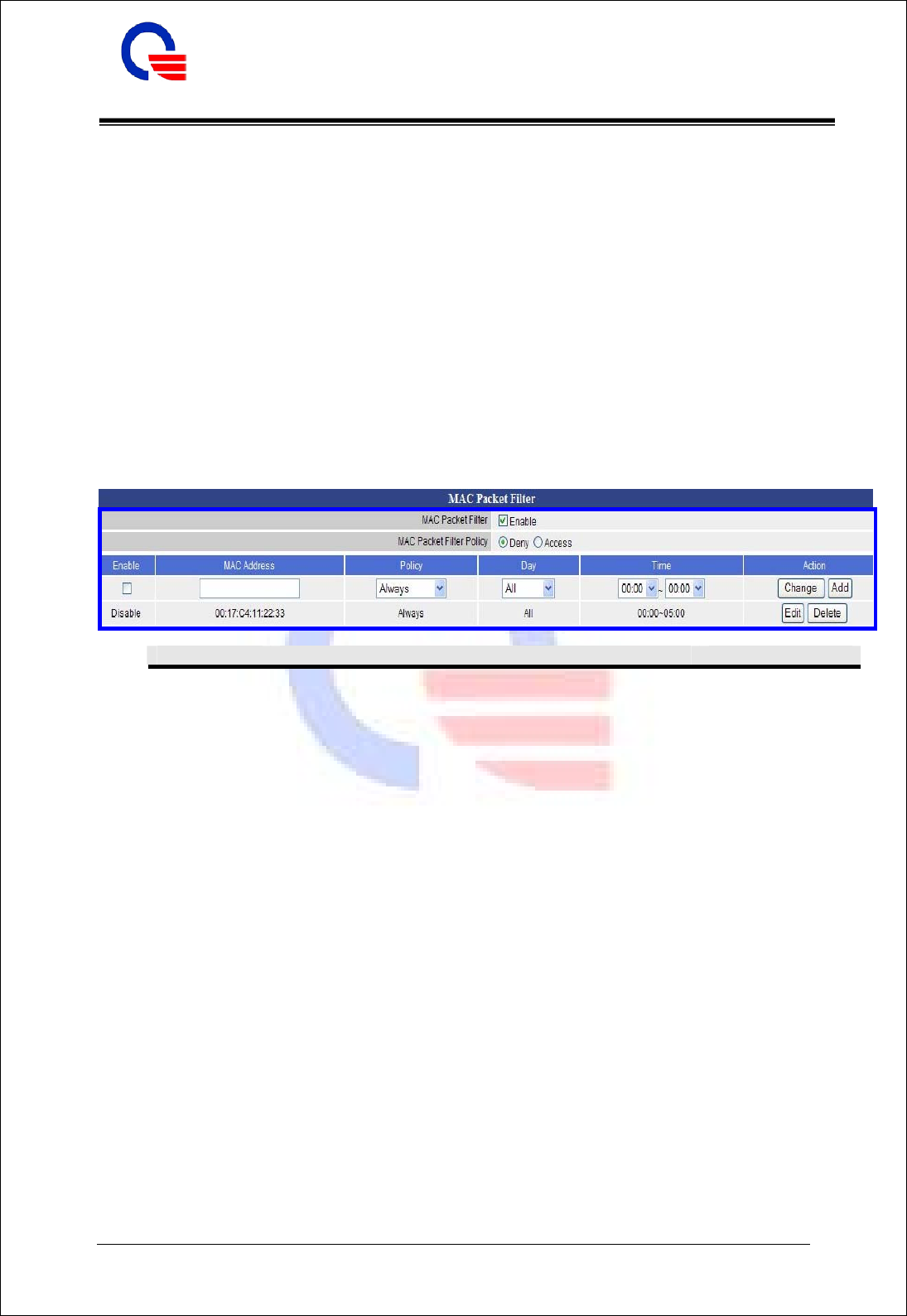
Quanta Computer Inc. IEEE802.16e WiMAX IAD (WV202)
User Manual
211, Wen Hwa 2nd Rd., Kuei Shan Hsiang, CONFIDENTIAL
Tao Yuan Shien, Taiwan, R.O.C. Classification: proprietary information
http://www.quantatw.com
39
day(s) will be performed.
Time If Block set to “by schedule”, you need to determine which
time will be performed.
00:00 ~ 00:00
Change Click change button to modify an existed item.
Add Click add button to add a new item
Edit Click edit button to edit the existed item.
Delete Click delete button to delete the unneeded item.
MAC – Packet Filter
Use MAC Filters to deny computers within the local area network from accessing the Internet. You can
either manually add a MAC address or select the MAC address from the list of clients that are currently
connected to the unit.
Field Description Default value
MAC Packet
Filter
Enable / Disable the packets filter function in LAN port. Enable
MAC Packet
Filter Policy Two way to determine the policies you want to deny or
access.
Deny
Enable Enable/Disable the MAC packet filter, default setting is
disabled.
Disable
MAC Address The MAC address of the computer in the LAN (Local Area
Network) to be used in the MAC filter table. Enter the MAC
address of LAN port, e.g. 00:00:27:88:81:18.
Policy
You can block the MAC address of the LAN computer
always or by schedule
Always
Day If Block set to “by schedule”, you need to determine which
day(s) will be performed.
All
Time If Block set to “by schedule”, you need to determine which
time will be performed.
00:00 ~ 00:00
Change Click change button to modify an existed item.
Add Click add button to add a new item
Edit Click edit button to edit the existed item.
Delete Click delete button to delete the unneeded item.
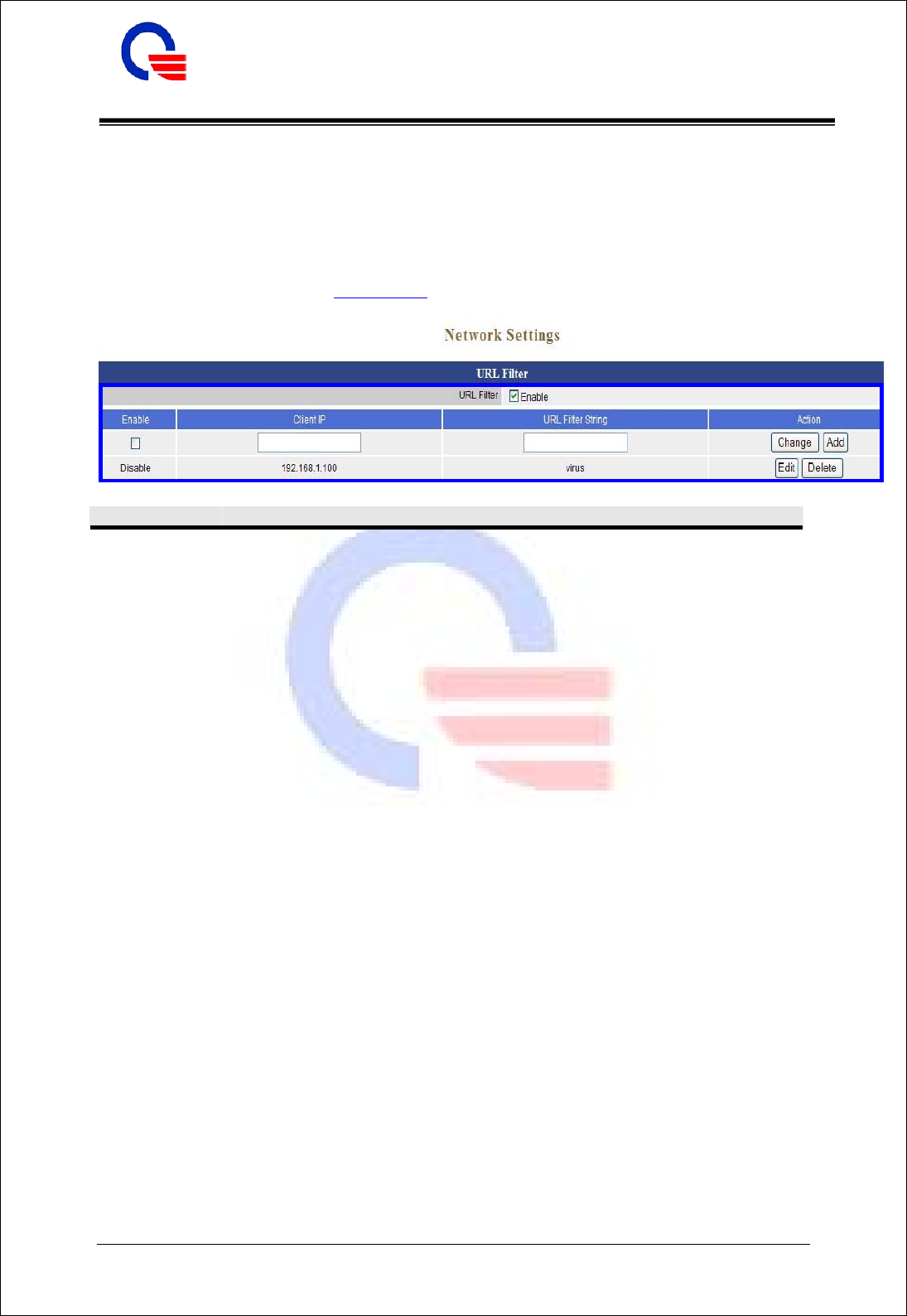
Quanta Computer Inc. IEEE802.16e WiMAX IAD (WV202)
User Manual
211, Wen Hwa 2nd Rd., Kuei Shan Hsiang, CONFIDENTIAL
Tao Yuan Shien, Taiwan, R.O.C. Classification: proprietary information
http://www.quantatw.com
40
3.9 URL Filter
With security reason, the URL Filter provides the enterprise to manage and restrict employee access to
non-business or undesirable content on the Internet. URL Filter is a web solution that blocks web-sites
access according the URL Filter String no matter the URL string is found full or partial matched with a
keyword.
For example, if you add URL Filter String with keyword “sex”, the WV202 will limit local hosts to access
the web site or web pages such as “www.sex.com” or “www.fronthost.com/sex/index.html”.
Field Description Default value
URL Filter
Enable/Disable the URL Filter, default setting is disabled. Enable
Enable Enable/Disable the MAC packet filter, default setting is
disabled.
Disable
Client IP The host computer which will be blocked to access the
Internet.
URL Filter
String The pattern which will be blocked. For example,
“yahoo.com” or keyword “sex”.
Change Click change button to modify an existed item.
Add Click add button to add a new item
Edit Click edit button to edit the existed item.
Delete Click delete button to delete the unneeded item.
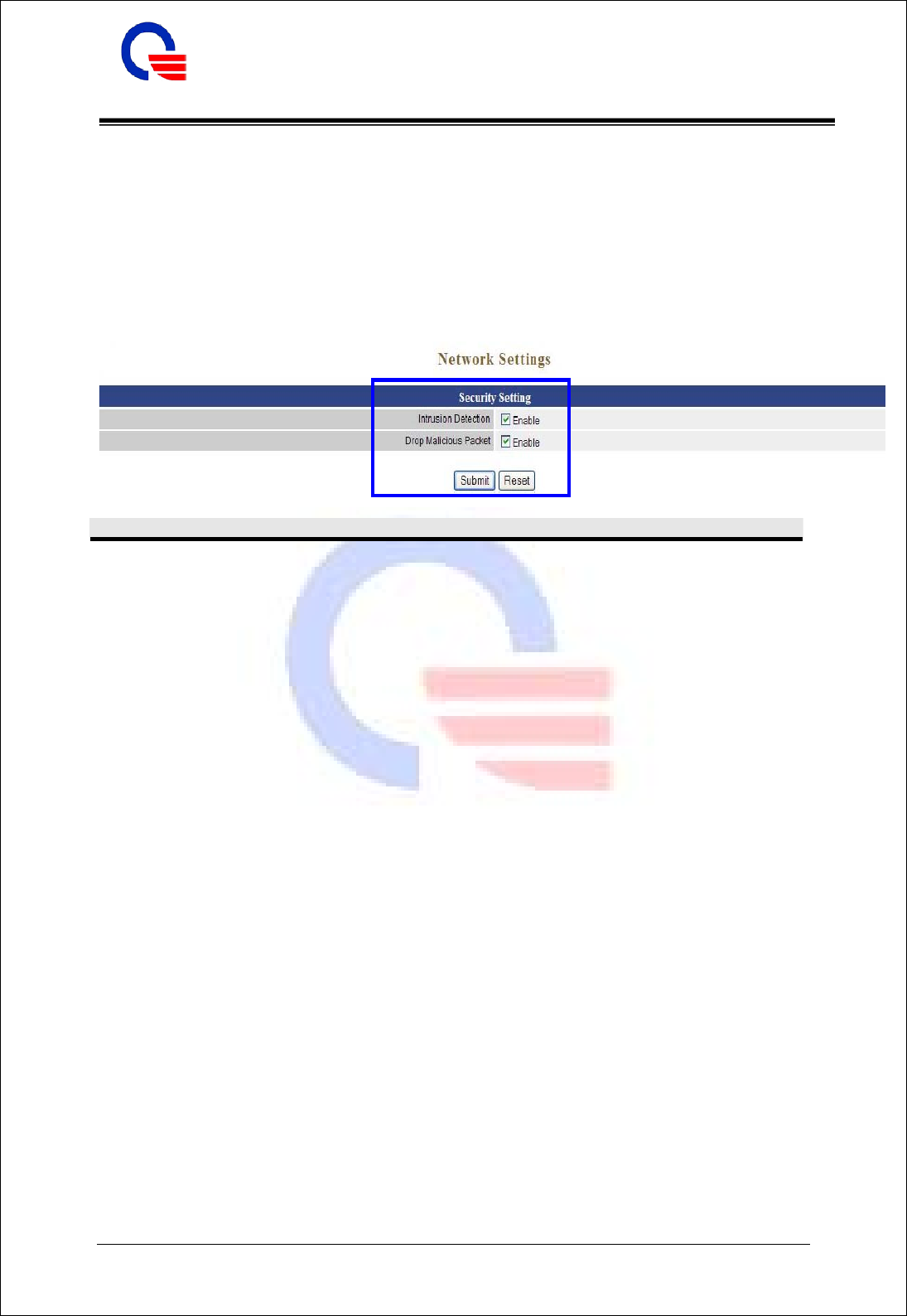
Quanta Computer Inc. IEEE802.16e WiMAX IAD (WV202)
User Manual
211, Wen Hwa 2nd Rd., Kuei Shan Hsiang, CONFIDENTIAL
Tao Yuan Shien, Taiwan, R.O.C. Classification: proprietary information
http://www.quantatw.com
41
3.10 Security
Intrusion detection (ID) is a type of security management system for computers and networks. An ID
system gathers and analyzes information from various areas within a computer or a network to identify
possible security breaches, which include both intrusions (attacks from outside the organization) and
misuse (attacks from within the organization).
User can enable the “Intrusion Detection” function in the “Security” page to detect the intrusions and
enable the “Drop Malicious Packet” function to drop the malicious packets.
Field Description Default value
Intrusion
Detection
Enable/Disable the intrusion detection. Disable
Drop Malicious
Packet
Enable/Disable the drop malicious packet. Disable
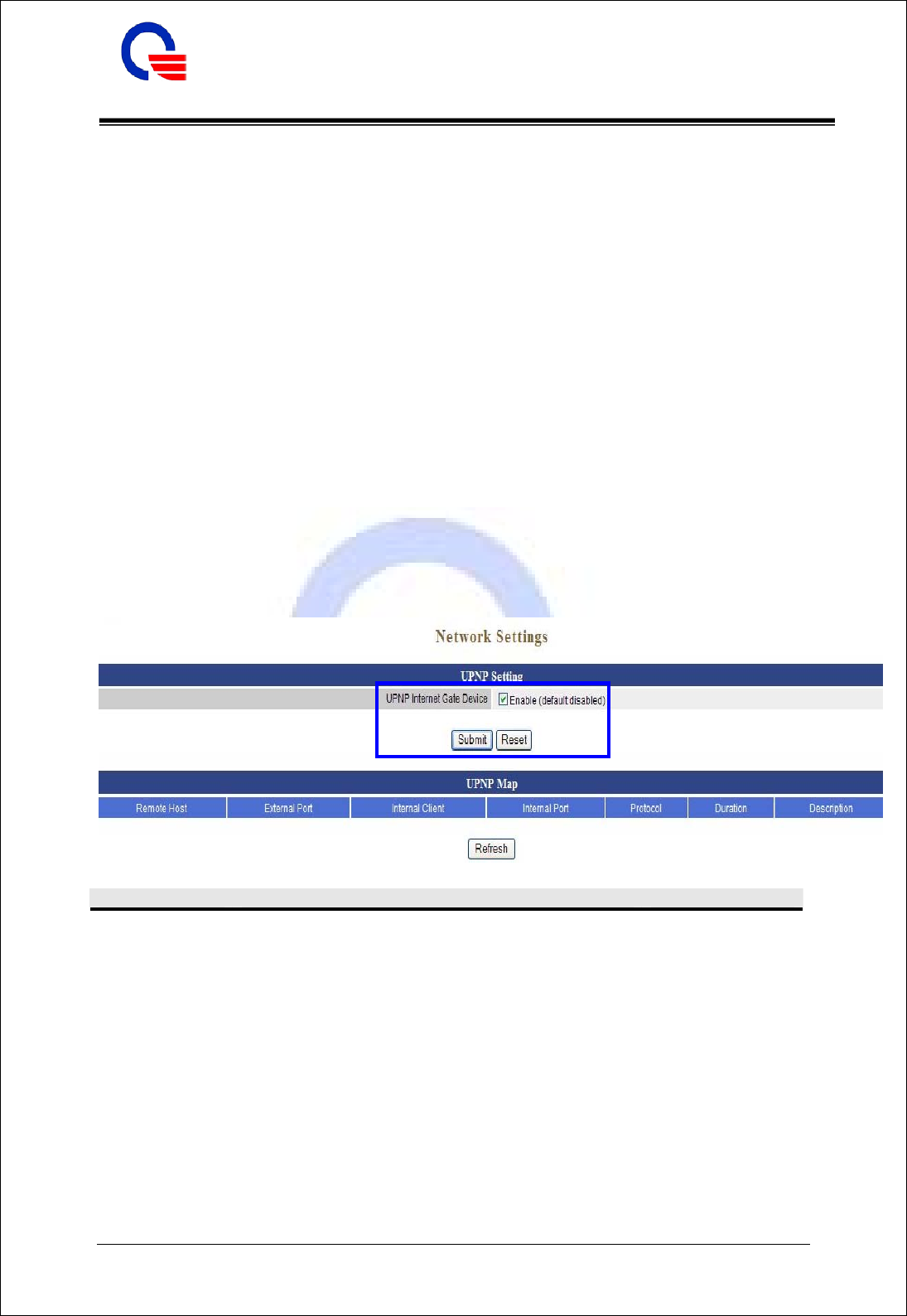
Quanta Computer Inc. IEEE802.16e WiMAX IAD (WV202)
User Manual
211, Wen Hwa 2nd Rd., Kuei Shan Hsiang, CONFIDENTIAL
Tao Yuan Shien, Taiwan, R.O.C. Classification: proprietary information
http://www.quantatw.com
42
3.11 UPnP
UPnP is short for Universal Plug and Play which is a networking architecture that provides compatibility
among networking equipment, software, and peripherals. The WV202 is an UPnP enabled router and will
only work with other UPnP devices/softwares. If you do not want to use the UPnP functionality, it can be
disabled by canceling the “Enable” item..
UPnP is architecture for pervasive peer-to-peer network connectivity of PCs and intelligent devices or
appliances, particularly within the home. UPnP builds on Internet standards and technologies, such as
TCP/IP, HTTP, and XML, to enable these devices to automatically connect with one another and work
together to make networking - particularly home networking - possible for more people.
The UPnP Internet Gateway Device (IGD) is an “edge” interconnect device between a residential Local
Area Network (LAN) and the Wide Area Network (WAN), providing connective to the Internet.
With UPnP support, the MSN message can communicate over NAT. In other words, the user of the
windows Massager behind the firewall/NAT device will be able to connect the peer for voice and video
conferencing.
UPnP (Universal Plug-and-Play). Network architecture based on TCP/IP and intended to allow
terminals to be networked without the need for configuration. In the Barricade router, for example, the
correct ports are automatically opened for applications like Net meeting, online games, etc. You can
choose to enable or disable the UPnP Service.
Field Description Default value
UPNP Internet
Gate Device
Enable/Disable the UPNP function. Disable
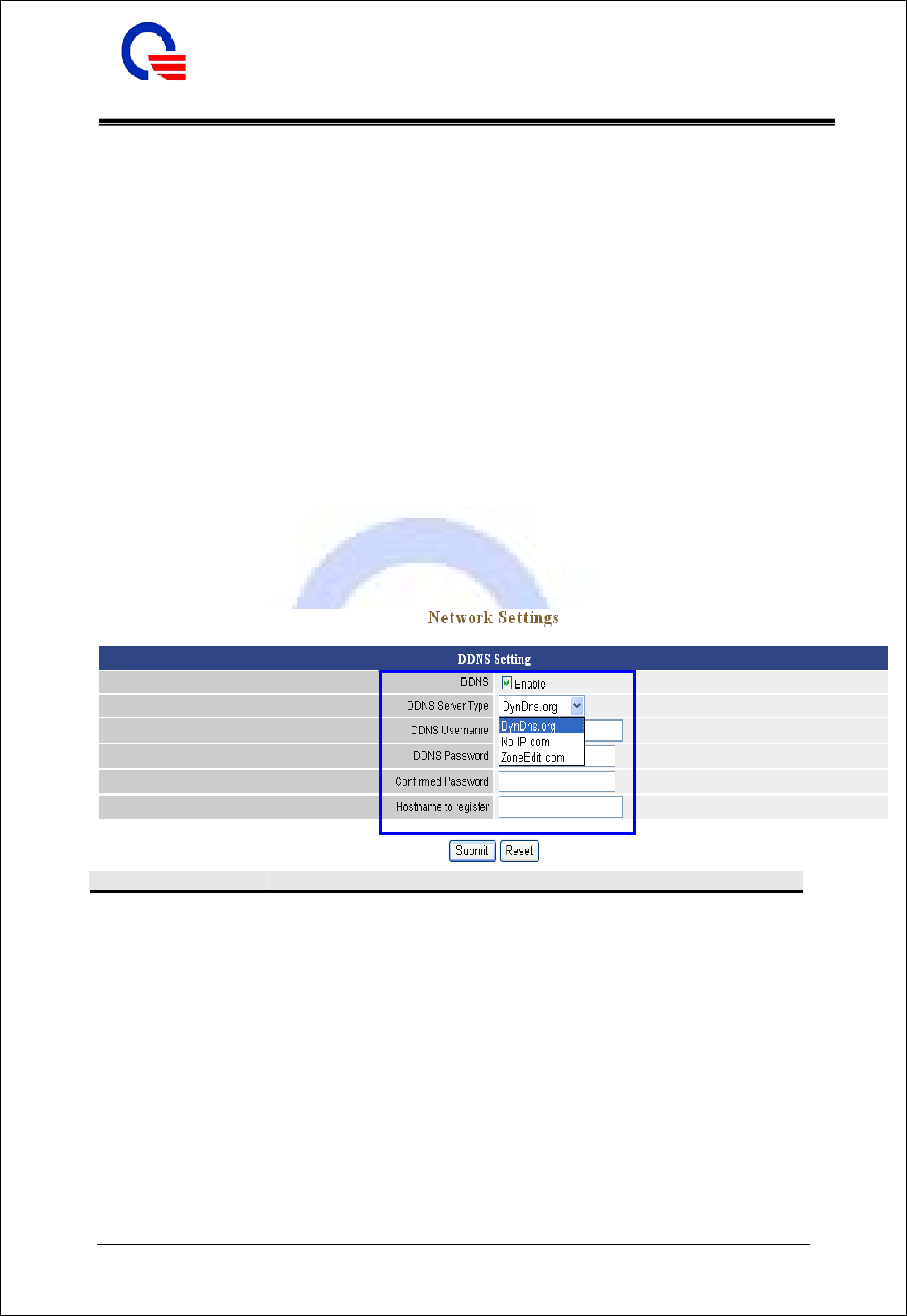
Quanta Computer Inc. IEEE802.16e WiMAX IAD (WV202)
User Manual
211, Wen Hwa 2nd Rd., Kuei Shan Hsiang, CONFIDENTIAL
Tao Yuan Shien, Taiwan, R.O.C. Classification: proprietary information
http://www.quantatw.com
43
3.12 DDNS
The DDNS (Dynamic DNS) service allows you to alias a dynamic IP address to a static hostname,
allowing your computer to be more easily accessed from various locations on the Internet.
Without DDNS, the users should use the WAN IP to reach internal server. It is inconvenient for the users
if this IP is dynamic. With DDNS supported, you apply a DNS name (e.g., www.xxx.com) for your server
(e.g., Web server) from a DDNS server. The outside users can always access the web server using the
www.xxx.com regardless of the WAN IP.
When you want your internal server to be accessed by using DNS name rather than using the dynamic IP
address, you can use the DDNS service. The DDNS server allows to alias a dynamic IP address to a static
hostname.
Unlike DNS that only works with static IP addresses, DDNS works with dynamic IP addresses, such as
those assigned by an ISP or other DHCP server. DDNS is popular with home networkers, who typically
receive dynamic, frequently-changing IP addresses from their service provider.
DDNS is a method of keeping a domain name linked to a changing (dynamic) IP address. If you are
assigned a dynamic IP address and that address is used only for the duration of that specific connection.
With the WV202, you can setup your DDNS service and the WV202 will automatically update your
DDNS server every time it receives a different IP address.
Field Description Default value
DDNS Enable/Disable the DDNS service, default setting is
disabled.
Disable
DDNS Server Type The WV202 support three types of DDNS,
DynDns.org / No-IP.com / ZoneEdit.com.
DynDns.org
DDNS Username The username which you register in DynDns.org ,
No-IP.com or ZoneEdit.com website.
DDNS Password The password which you register in DynDns.org ,
No-IP.com or ZoneEdit.com website.
Confirmed Password Confirm the password which you typing.
Hostname to register The hostname which you register in DynDns.org ,
No-IP.com or ZoneEdit.com website.
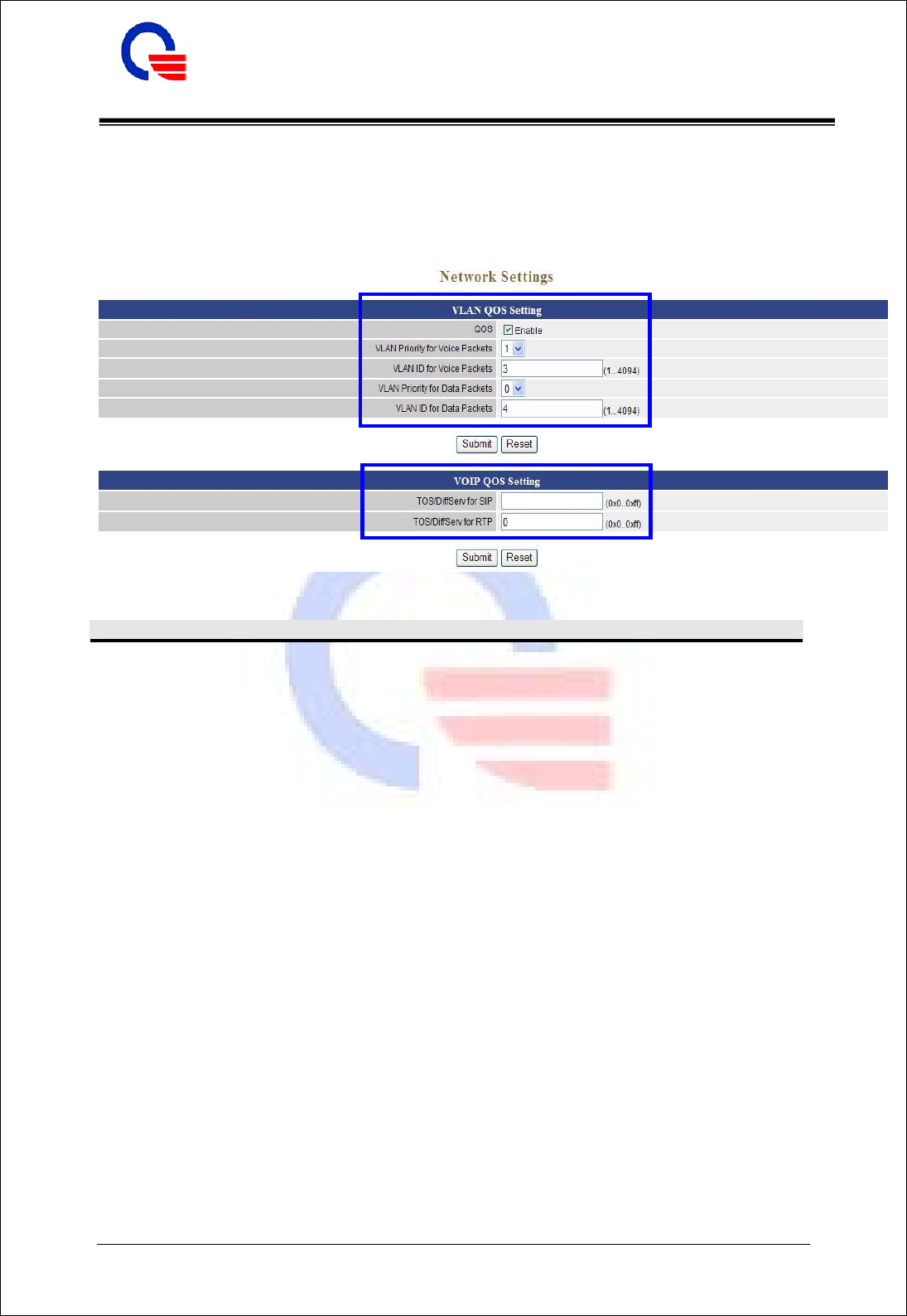
Quanta Computer Inc. IEEE802.16e WiMAX IAD (WV202)
User Manual
211, Wen Hwa 2nd Rd., Kuei Shan Hsiang, CONFIDENTIAL
Tao Yuan Shien, Taiwan, R.O.C. Classification: proprietary information
http://www.quantatw.com
44
3.13 QoS
The QOS (Quality Of Service) is to guarantee that the Voice and Data should be transmitting at the
same time and data couldn’t influence the Voice quality. When TOS bits is enabled, it will guarantee
the Voice have the first priority pass through the TOS enable devices.
Field Description Default value
QOS Enable/Disable the QOS Service. Default setting is
disabled.
Disable
VLAN Priority for
Voice Packets
The priority value for voice packet. Default is 1. 1
VLAN ID for Voice
Packets
The voice VLAN ID. Default is 3. 3
VLAN Priority for
Data Packets
The priority value for data packet. Default is 0. 0
VLAN ID for Data
Packets
The data VLAN ID. Default is 4. 4
TOS / DiffServ for
SIP This option enables the phone to support QOS for SIP
traffic in a network. This makes sense only if all parts of
the involved network also support QOS. Assign the
priority value from 0 to 255. Default is 0.
TOS / DiffServ for
RIP This option enables the phone to support QOS for RTP
traffic in a network. This makes sense only if all parts of
the involved network also support QOS. Assign the
priority value from 0 to 255. Default is 0.
0
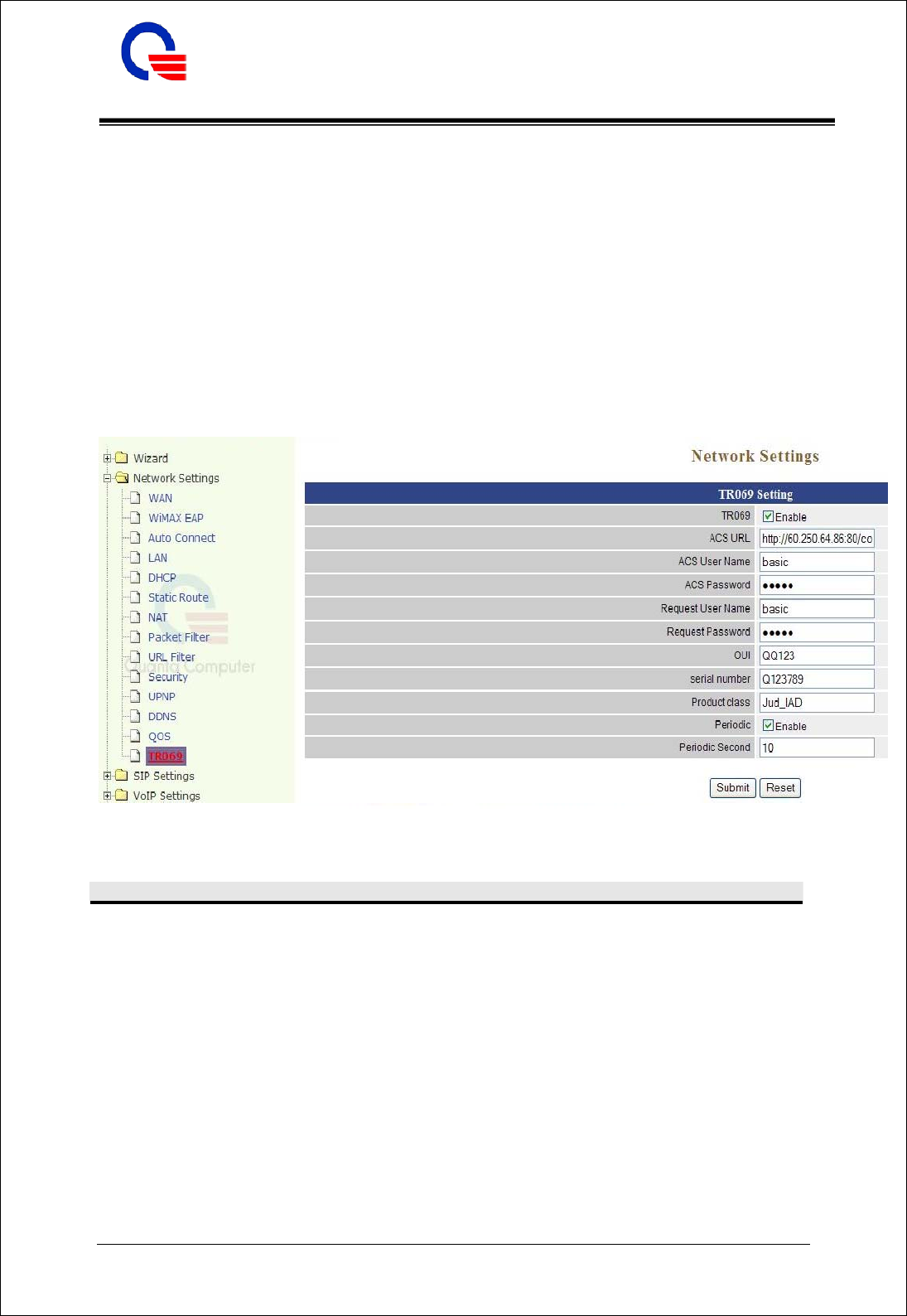
Quanta Computer Inc. IEEE802.16e WiMAX IAD (WV202)
User Manual
211, Wen Hwa 2nd Rd., Kuei Shan Hsiang, CONFIDENTIAL
Tao Yuan Shien, Taiwan, R.O.C. Classification: proprietary information
http://www.quantatw.com
45
3.14 TR069
The TR069 is the CPE WAN Management Protocol, intended for communication between a CPE
and Auto-Configuration Server (ACS). ACS can remote manage the CPE and modify the settings via
TR069 protocol. The CPE WAN Management Protocol defines a mechanism that encompasses secure
auto-configuration of a CPE, and also incorporates other CPE management functions into a common
framework.
When you enable the TR069 function and want to manage this IAD, please make sure the
connection is worked between IAD and ACS. The IAD will send the request packets to ACS and ACS
will feedback the request packets from IAD.
Field Description Default value
TR069 Enable / Disable the TR069 function
Disable
ACS URL The URL of ACS (Auto Configuration Server) for
connecting. Depending on different security mechanism,
the URL will be different, like as with SSL security or
not.
ACS User Name The user name is provided by ACS for IAD to connect
ACS Password The password is provided by ACS for IAD to connect
Request User Name When user wants to mount device to the system, user
must send a connection request to the device including
the username and password.
The user name and password are also used when user
notify the device

Quanta Computer Inc. IEEE802.16e WiMAX IAD (WV202)
User Manual
211, Wen Hwa 2nd Rd., Kuei Shan Hsiang, CONFIDENTIAL
Tao Yuan Shien, Taiwan, R.O.C. Classification: proprietary information
http://www.quantatw.com
46
Request Password When user wants to mount device to the system, user
must send a connection request to the device including
the username and password.
The user name and password are also used when user
notify the device
OUI An Organizationally Unique Identifier (OUI) is a unique
identifier value for different organization. This settings is
not the needed item for connecting between CPE and
ACS, it’s depending on the connecting requirement of
ACS.
Serial number The unique serial number of this device is used to
connect to ACS.
Product Class The product class is the description of this product.
Periodic To enable or disable the periodic function that CPE will
auto send connection request to ACS periodic.
Disable
Periodic Second It’s the time to send the connection request periodic to
ACS

Quanta Computer Inc. IEEE802.16e WiMAX IAD (WV202)
User Manual
211, Wen Hwa 2nd Rd., Kuei Shan Hsiang, CONFIDENTIAL
Tao Yuan Shien, Taiwan, R.O.C. Classification: proprietary information
http://www.quantatw.com
47
4. SIP Settings
SIP (Session Initiation Protocol) is a request-response protocol, dealing with requests from clients and
responses from servers. Participants are identified by SIP URLs. Requests can be sent through any
transport protocol. SIP determines the end system to be used for the session, the communication media
and media parameters, and the called party's desire to engage in the communication. Once these are
assured, SIP establishes call parameters at either end of the communication, and handles call transfer and
termination.
¾ Basic Setting
¾ Account Setting
¾ Server Setting
¾ NAT Traversal
4.1 Basic Setting
Field Description Default value
Session Timer Flag Disable / Enable the session timer to refresh Sip sessions.
Default setting is disabled.
Disable
Session Timer SIP session refresh time interval. The time interval in
which the phone periodically refresh SIP sessions by
sending repeated INVITE or Update request, depending
on session type. Its range is 90 to 65535, default setting
is 1800 seconds.
1800

Quanta Computer Inc. IEEE802.16e WiMAX IAD (WV202)
User Manual
211, Wen Hwa 2nd Rd., Kuei Shan Hsiang, CONFIDENTIAL
Tao Yuan Shien, Taiwan, R.O.C. Classification: proprietary information
http://www.quantatw.com
48
Media Port Start The starting range of port for RTP. Port number for initial
of sending RTP packet. Its range is 1024 to 65535,
default setting is 5000.
5000
Media Port End The ending range of port for RTP. Its range is 1024 to
65535, default setting is 5009
5009
Transport Assigns the default SIP transport protocol.
UDP – UDP (User Datagram Protocol) provides very few
error recovery services, offering instead a direct way to
send and receive datagram over an IP network. It's used
primarily for broadcasting messages over a network.
Here the UDP is a default setting.
TCP (Transmission Control Protocol) guarantees delivery
of data and also guarantees that packets will be delivered
in the same order in which they were sent.
UDP
SIP Time Interval SIP time interval in milliseconds. The default setting is
500 msec.
500
Timeout for Invite INVITE message timeout value. Assigns a value 1 to
100, default setting is 12 seconds. It denotes if an
INVITE request was sent, and a response is not received
from the remote site within the allotted time (the value of
Invite Timeout). The present request will be dropped and
a new connection request will be initiated.
12
Timeout for Ring
Back Timeout value for dropping a call after receiving 180
responses. Ring back is an intermittent audio tone that a
caller in a telephone system hears after dialing a number,
when the distant end of the circuit is receiving a ringing
signal. It can be generated by the servicing switch of
either the called party or the calling party. It is not
generated by the called instrument. The default setting is
180 seconds.
180
Timeout for
Release BYE message timeout value. Assigns a time interval 1 to
10, default setting is 4 seconds.
4
Registration Retry
Count When the SIP registration is failed, it will retries to
registry again after the Registration Retry Interval time.
You can set how many times to retry SIP registration.
The default setting is the maximum number ‘65535’.
65535
Registration Retry
Interval The interval time to retry SIP registration. The default
setting is 30 seconds.
30
Ping Interval It is the interval time to execute ping the SIP server.
0
PRACK Flag Indicates if INVITE messages sent on the specified trunk
group require reliable provisional responses. This is used
to deliver provisional responses (like alerting) reliably
and is useful for SIP trunks. The default setting is
disabled.
Disable
SIP User Agent
Name The name of the SIP User Agent. VOIP_Agent_001
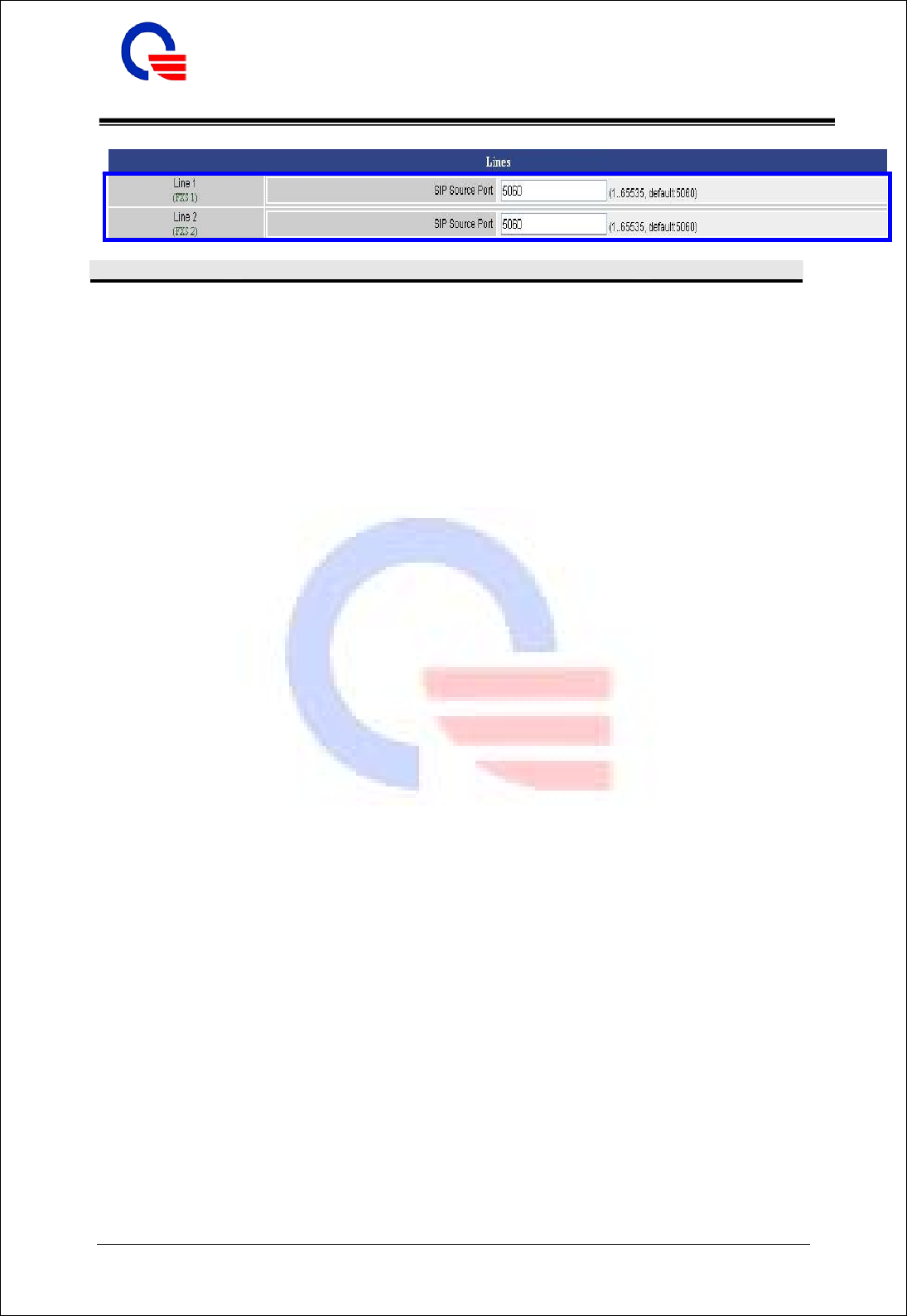
Quanta Computer Inc. IEEE802.16e WiMAX IAD (WV202)
User Manual
211, Wen Hwa 2nd Rd., Kuei Shan Hsiang, CONFIDENTIAL
Tao Yuan Shien, Taiwan, R.O.C. Classification: proprietary information
http://www.quantatw.com
49
Field Description Default value
SIP Source Port Assign the SIP port number of terminal adapter. Its range
is 1 to 65535, default setting is 5060. 5060
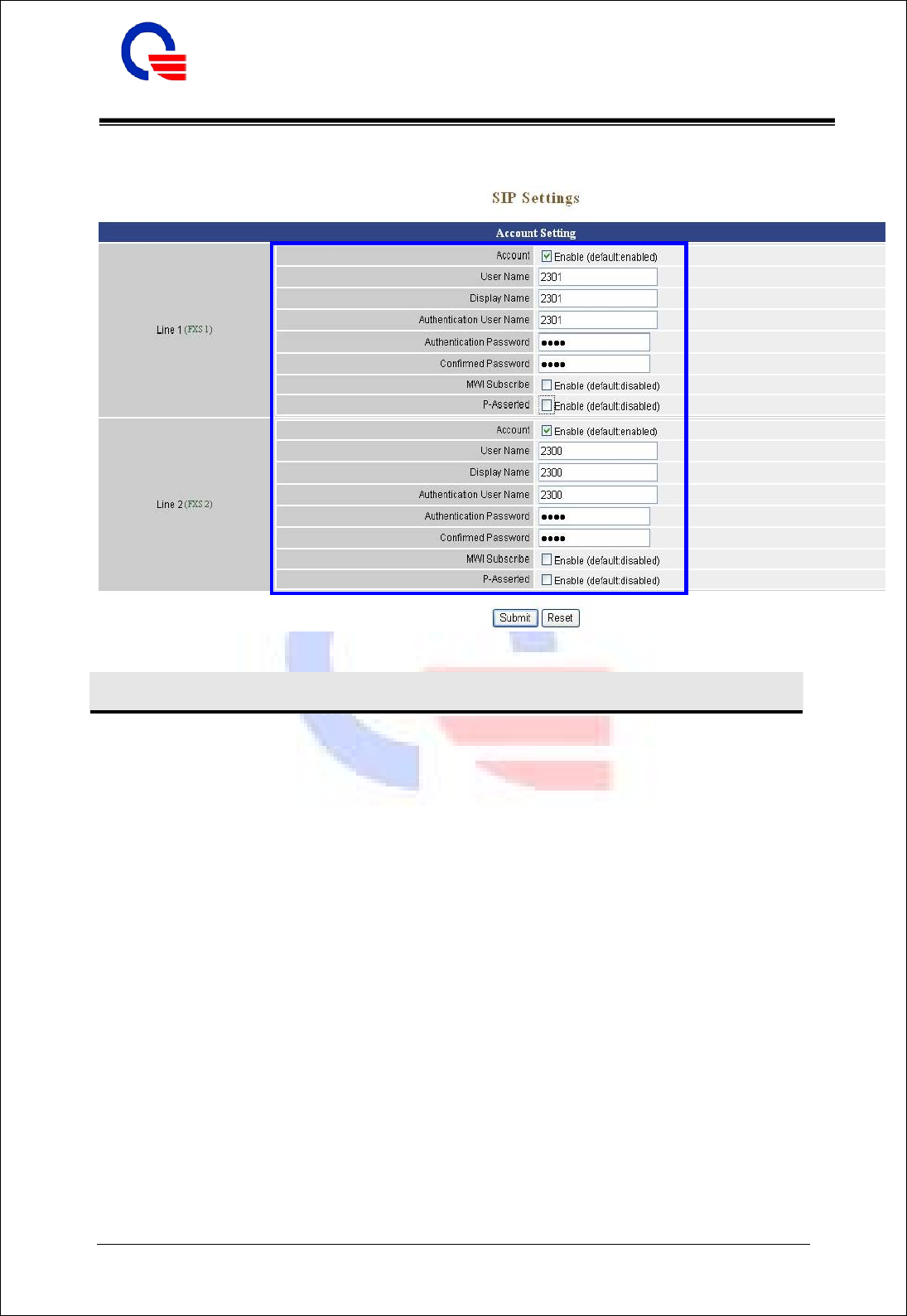
Quanta Computer Inc. IEEE802.16e WiMAX IAD (WV202)
User Manual
211, Wen Hwa 2nd Rd., Kuei Shan Hsiang, CONFIDENTIAL
Tao Yuan Shien, Taiwan, R.O.C. Classification: proprietary information
http://www.quantatw.com
50
4.2 Account Setting
There are two ports can be setup for SIP account.
Field Description Default value
(Line1 / Line2)
Account To disable / enable the account settings. The default
value is disabled.
Enable / Enable
User Name The user name Provided from your ISP.
2301 / 2300
Display Name This text message will be sent between the callee and
caller and will show on LCD panel for general using.
2301 / 2300
Authentication User
Name
User name for authentication. Maximum 36 characters. 2301 / 2300
Authentication
Password User password for authentication. Maximum 24
characters.
2301 / 2300
Confirmed
Password Enter the password again, this is used to confirm user
password for authentication. Maximum 24 characters.
2301 /2300
MWI Subscribe Message Waiting Indication (MWI)
To disable / enable the function for the VoIP phone to ask
for MWI (Message Waiting Indication) periodically.
Disable / Disable
P-Asserted To disable / enable the P-Asserted function, the default
setting is disabled. Disable / Disable
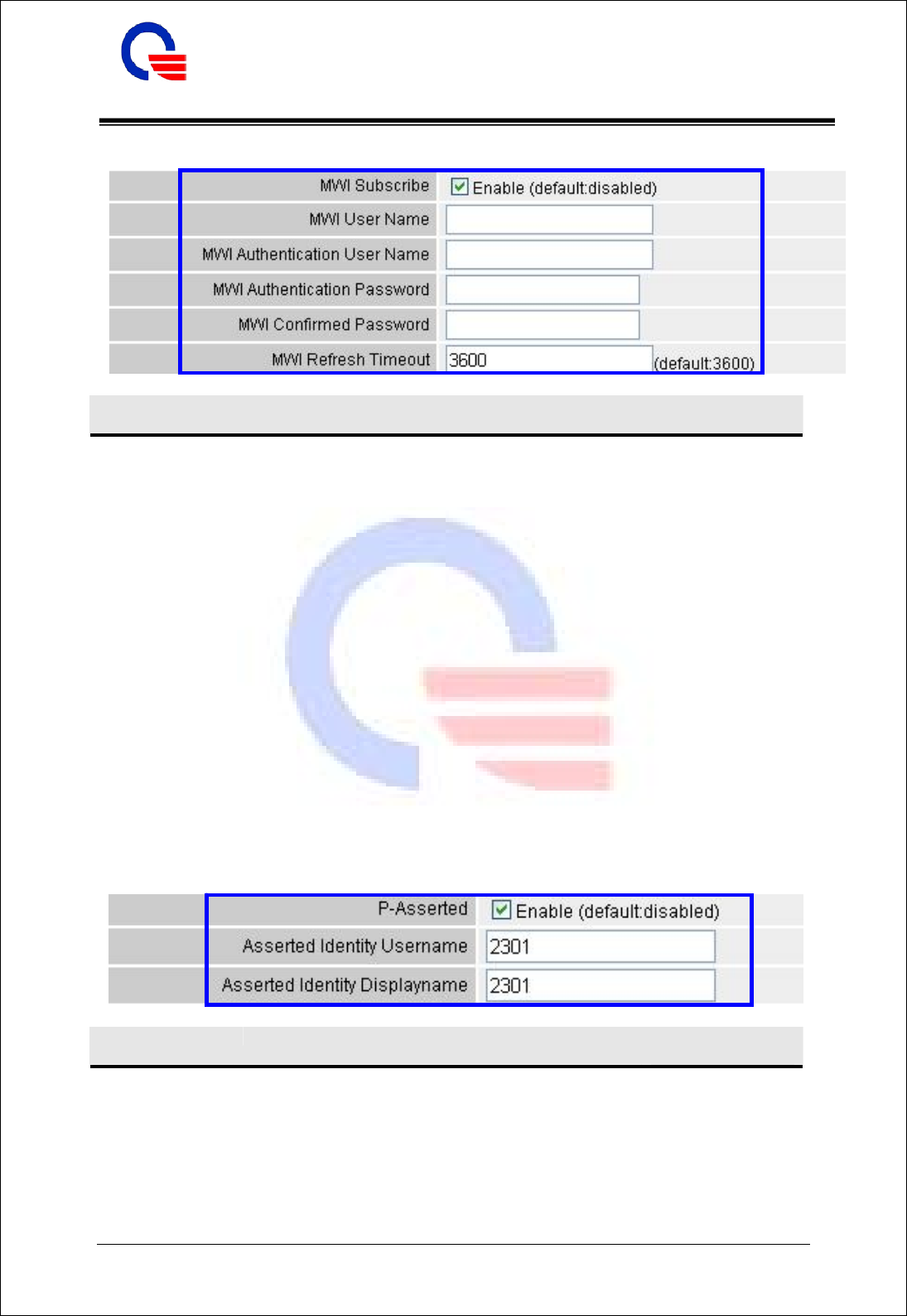
Quanta Computer Inc. IEEE802.16e WiMAX IAD (WV202)
User Manual
211, Wen Hwa 2nd Rd., Kuei Shan Hsiang, CONFIDENTIAL
Tao Yuan Shien, Taiwan, R.O.C. Classification: proprietary information
http://www.quantatw.com
51
Message Waiting Indication (MWI) enables your phone to give you a message-waiting (beeping) dial
tone when you have one or more voice messages.
P-asserted header is used when you want to send some extra number other than calling, called. Assume the
SIP Invite request is with numbers, and the Call agent wants to out pulse charge number. It does that in the
P-asserted header. The P-Asserted-Identity header is used among trusted SIP entities (typically
intermediaries) to carry the identity of the user sending a SIP message as it was verified by authentication.
Field Description Default value
(Line1 / Line2)
MWI Subscribe Message Waiting Indication (MWI)
To disable / enable the function for the VoIP phone to
ask for MWI (Message Waiting Indication) periodically.
Disable / Disable
MWI User Name The username for MWI.
MWI
Authentication User
Name
User name for authentication. Maximum 36 characters
MWI
Authentication
Password
User password for authentication. Maximum 24
characters.
MWI Confirmed
Password Enter the password again, this is used to confirm user
password for authentication. Maximum 24 characters.
MWI Refresh
Timeout The time to refresh MWI, it will stops to refresh MWI
when the message-waiting time is over this time setting.
The default setting is 3600 seconds.
3600 / 3600
Field Description Default value
(Line1 / Line2)
P-Asserted To disable / enable the P-Asserted function, the default
setting is disabled.
Disable / Disable
Asserted Identity
Username
The name of asserted identity. 2301 / 2300
Asserted Identity
Displayname This text message will be sent between the callee and
caller and will show on LCD panel for general using. 2301 / 2300
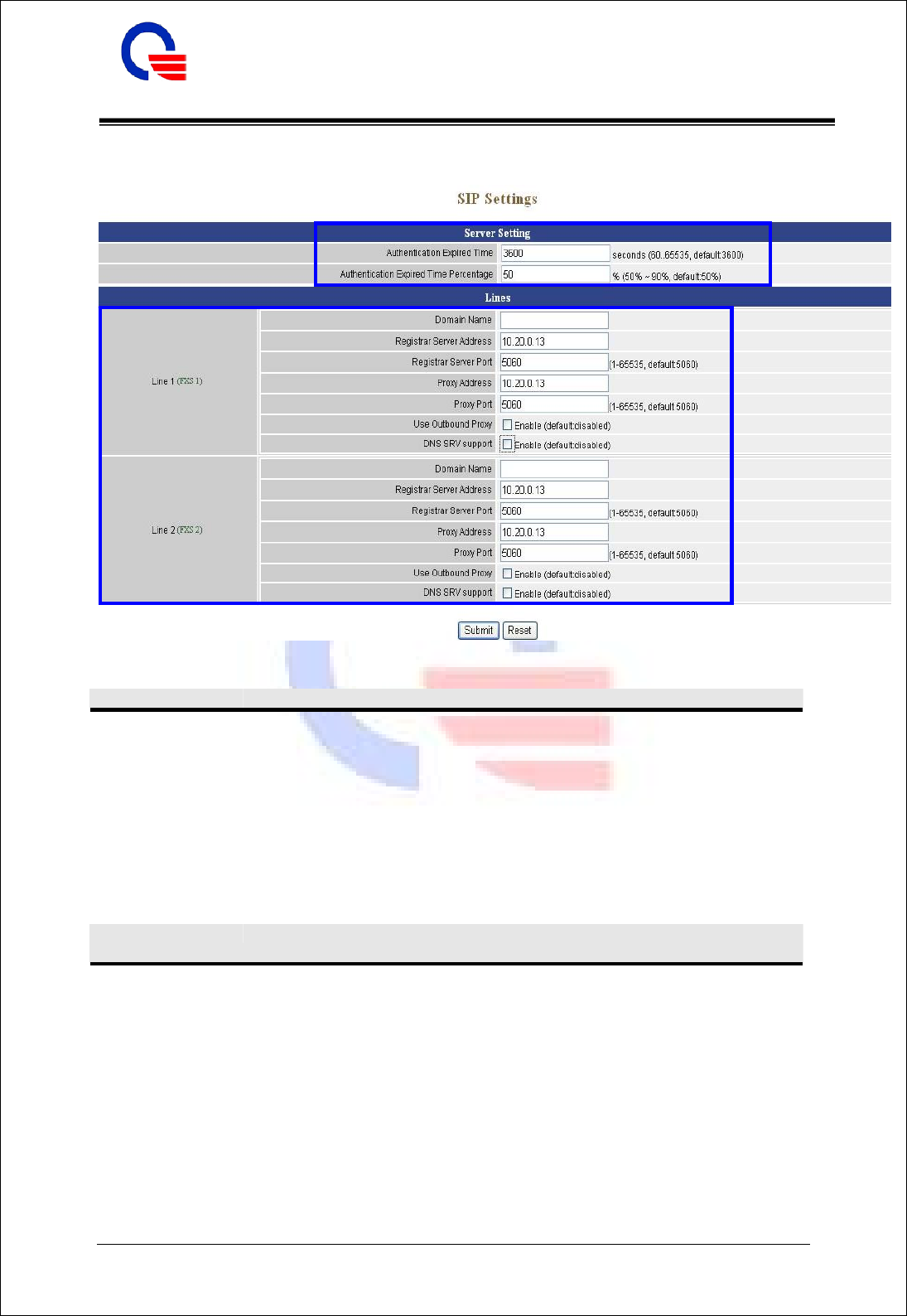
Quanta Computer Inc. IEEE802.16e WiMAX IAD (WV202)
User Manual
211, Wen Hwa 2nd Rd., Kuei Shan Hsiang, CONFIDENTIAL
Tao Yuan Shien, Taiwan, R.O.C. Classification: proprietary information
http://www.quantatw.com
52
4.3 Server Setting
Field Description Default value
Authentication
Expired Time SIP registration expired time. Assigns the time interval
from 60 – 65535, default setting is 3600 seconds.
3600
Authentication
Expired Time
Percentage
Before the expired time is timeout, IAD need to send a
re-register packet to SIP server for keeping the connection.
To set how many percentage of the expired time to send the
register packets.
50
Field Description Default value
(Line1 / Line2)
Domain Name Enter the SIP service domain name. In the full SIP URI,
this is the part after the @ symbol. You can use up to
127 printable ASCII Extended set characters.
Registrar Server
Address
Assigns the SIP Register Server’s IP address. 10.20.0.13 /
10.20.0.13
Registrar Server
Port Port number of SIP Register Server. Assigns a value from
1 to 65535, default setting is 5060.
5060 / 5060
Proxy Address The IP address of a SIP proxy server receives requests
from clients and forwards them to another server.
10.20.0.13 /
10.20.0.13
Proxy Port Port number of SIP proxy Server. Assigns a value from 1 5060 / 5060
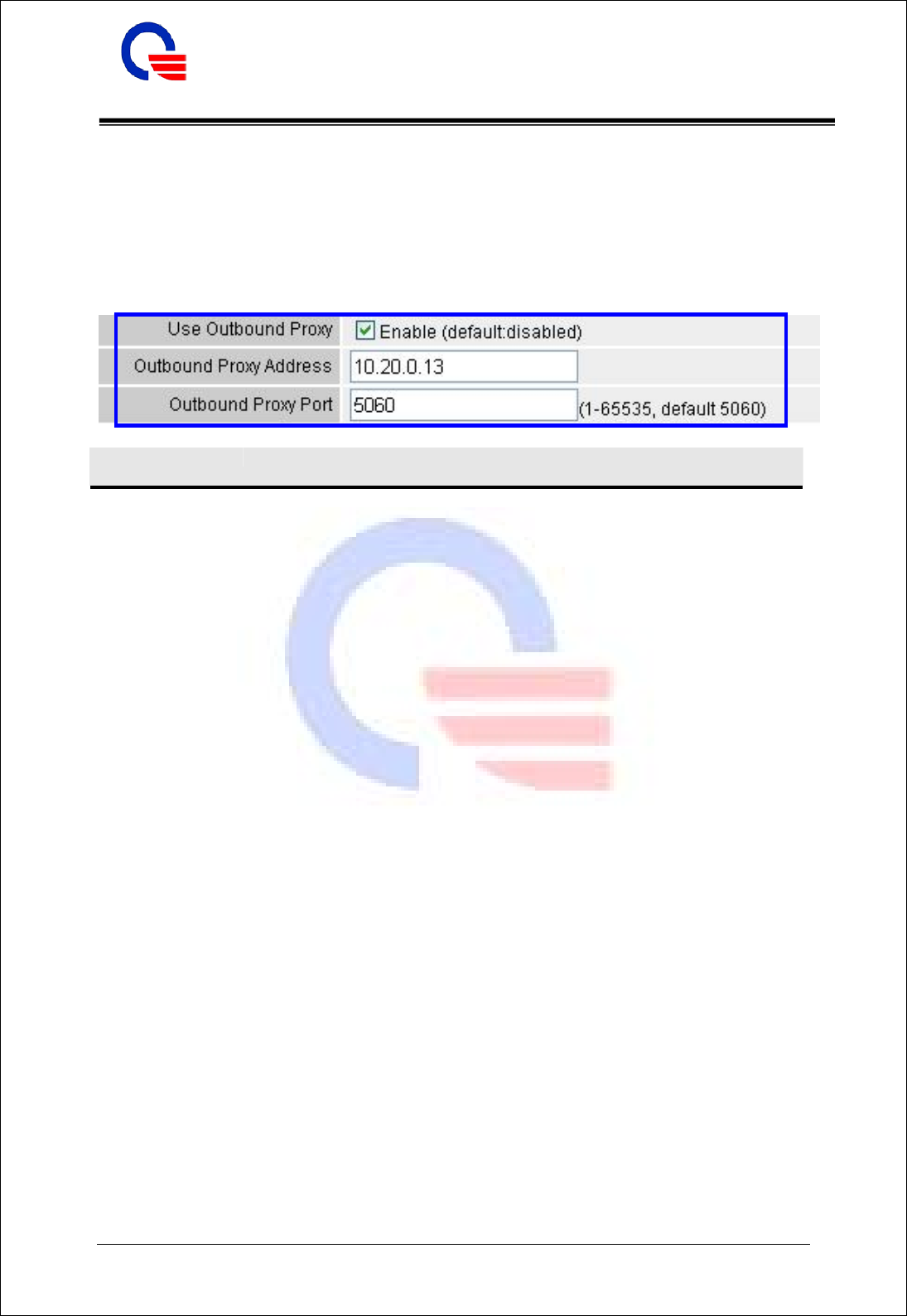
Quanta Computer Inc. IEEE802.16e WiMAX IAD (WV202)
User Manual
211, Wen Hwa 2nd Rd., Kuei Shan Hsiang, CONFIDENTIAL
Tao Yuan Shien, Taiwan, R.O.C. Classification: proprietary information
http://www.quantatw.com
53
to 65535, default setting is 5060.
Use Outbound
Proxy Enable/Disable this flag for out-bound (out-session and
in-session) requests. Default setting is disabled.
Disable / disable
DNS SRV Support To disable / enable the DNS SRV lookups for the SIP
proxy server. Disable / Disable
Field Description Default value
(Line1 / Line2)
Use Outbound
Proxy Enable/Disable this flag for out-bound (out-session and
in-session) requests. Default setting is disabled.
Disable / Disable
Outbound Proxy
Address Outbound Proxy server’s IP address. Assigns the server’s
IP which is in charge of call-out service.
10.20.0.13 /
10.20.0.13
Outbound Proxy
Port Port number of Outbound Proxy Server. Assigns a number
from 1 to 65535, default setting is 5060. 5060 / 5060
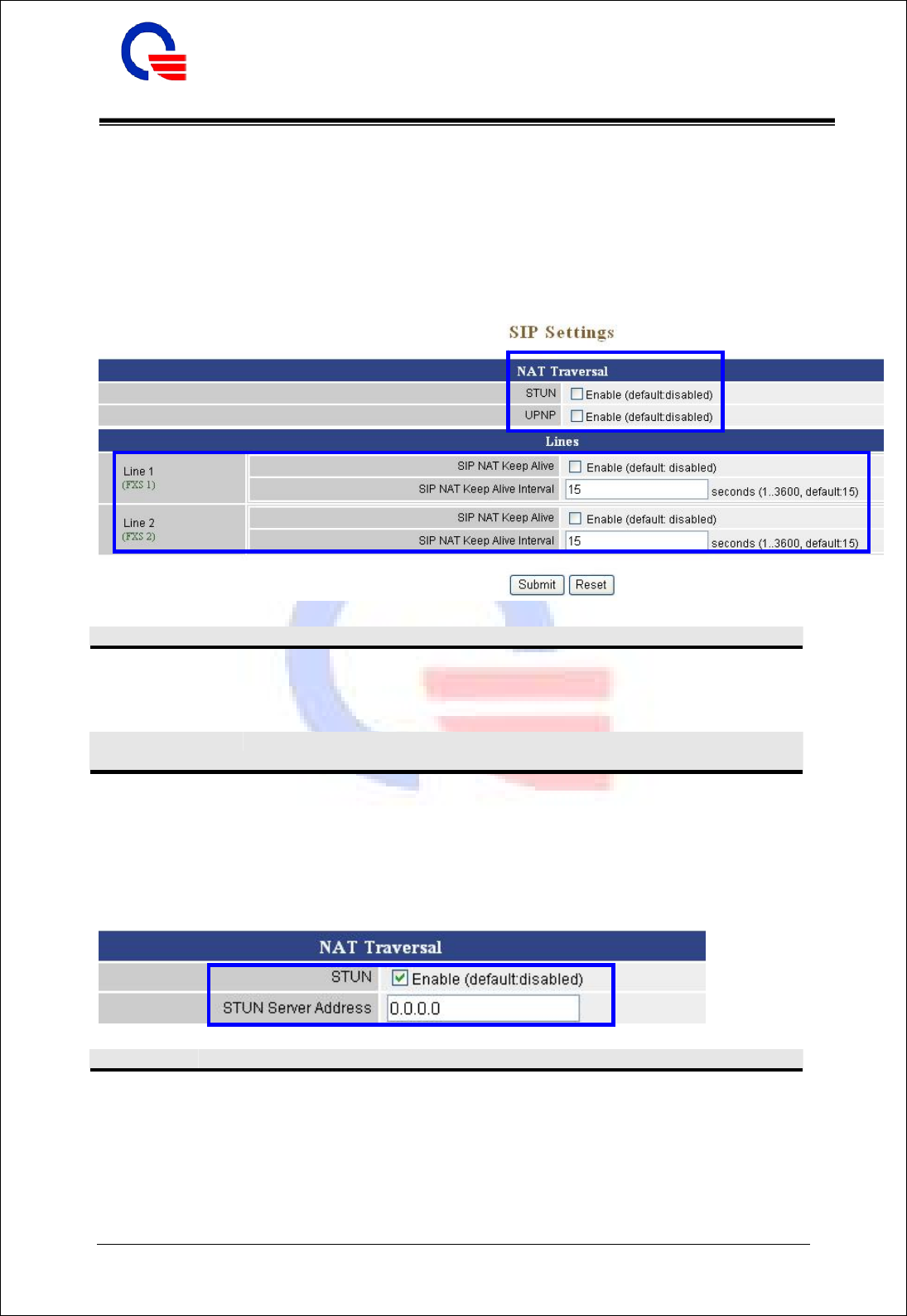
Quanta Computer Inc. IEEE802.16e WiMAX IAD (WV202)
User Manual
211, Wen Hwa 2nd Rd., Kuei Shan Hsiang, CONFIDENTIAL
Tao Yuan Shien, Taiwan, R.O.C. Classification: proprietary information
http://www.quantatw.com
54
4.4 NAT Traversal
VoIP NAT Traversal is a technology allowing IP phones or gateways capable of making and receiving
calls behind NAT router. In brief, if your IP phone or gateway is using private IP and you want to talk
with users over Internet WV202 supports two ways to handle this issue:
(1) Implement STUN (Simple Traversal of UDP through NATs) to learn the IP address of NAT WAN
port and then automatically fake WAN address on SIP and RTP on IP phone or gateway
(2) UPnP between NAT router and IP phone
Field Description Default value
STUN Enable/Disable STUN function. Default setting is disabled.
Disable
UPNP Enable/Disable STUN function. Default setting is disabled. Disable
Field Description Default value
(Line1 / Line2)
SIP NAT Keep
Alive Enable/Disable NAT Keep Alive function. If enable NAT
traversal function, the SIP client will sends the NAT keep
alive packets. Default setting is disabled.
Disable / Disable
SIP NAT Keep
Alive Interval The interval time to send the NAT keep alive packets.
Assigns a value from 1 to 3600, default setting is 15
seconds.
15 / 15
Field Description Default value
STUN Enable/Disable STUN function. Default setting is disabled.
Disable
STUN Server
Address The IP address of STUN server. The STUN server allows
clients to find out their public address, the type of NAT they
are behind and the internet side port associated by the NAT
with a particular local port
0.0.0.0
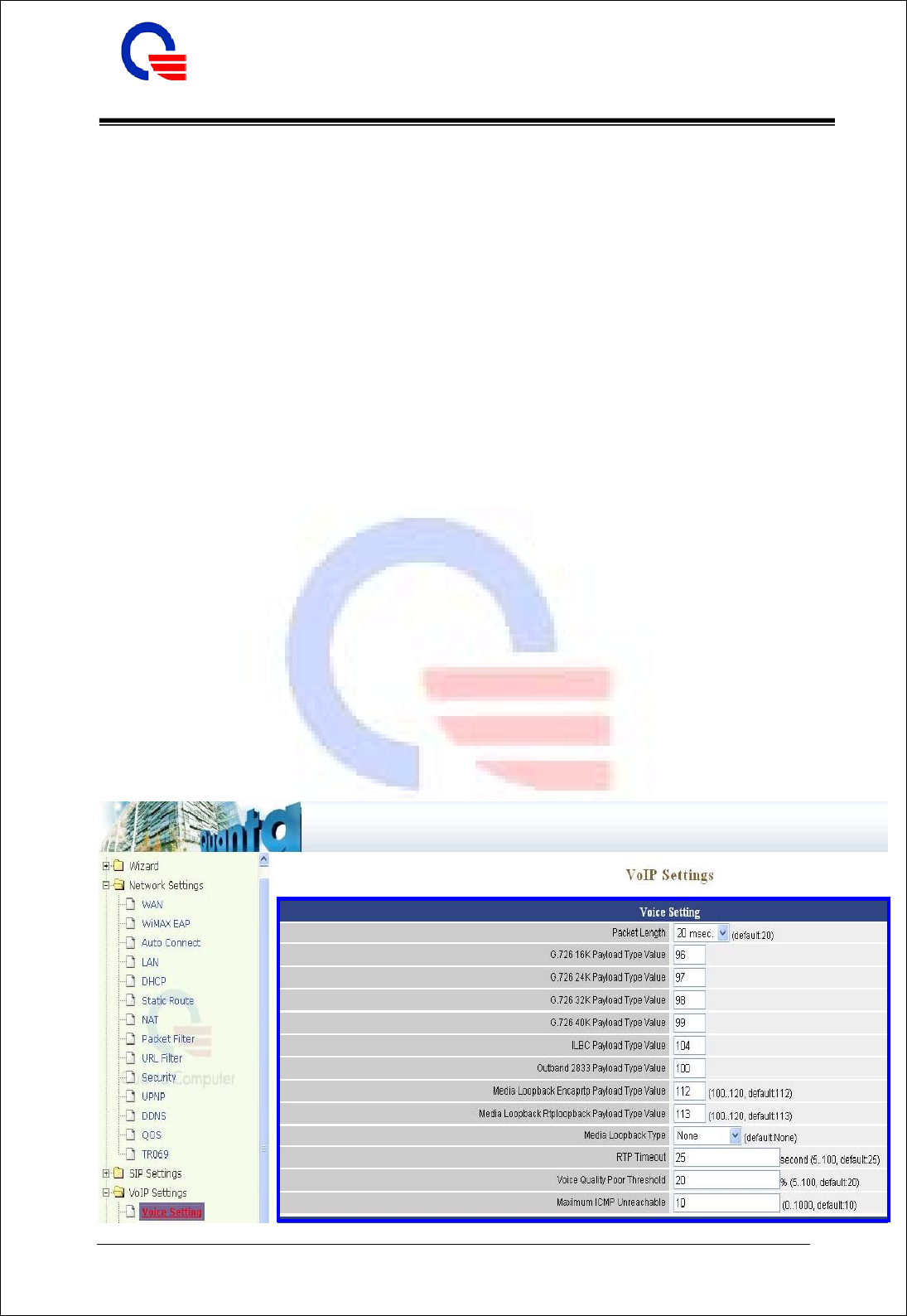
Quanta Computer Inc. IEEE802.16e WiMAX IAD (WV202)
User Manual
211, Wen Hwa 2nd Rd., Kuei Shan Hsiang, CONFIDENTIAL
Tao Yuan Shien, Taiwan, R.O.C. Classification: proprietary information
http://www.quantatw.com
55
5. VoIP Settings
The VoIP setting contains the following items:
¾ Voice Setting
¾ Tone Setting
¾ Call Service
¾ FXS Port
¾ FAX Setting
¾ General Dialing
¾ Phone Book
¾ Call Screen
5.1 Voice Setting
The parameters in “Voice Setting” will be worked in all FXS port (FXS1 and FXS2), like as the
payload type value in different codec and RTP settings. And some parameters can be set to different values
in line1 (FXS1) and line2 (FXS2), like as setting different priority of different codec, DTMF settings, and
Tx/Rx gain value in all lines (Line1 and Line2).
RTP provides end-to-end network transport functions suitable for applications transmitting real-time data,
such as audio, video or simulation data, over multicast or unicast network services. RTP does not address
resource reservation and does not guarantee quality-of-service for real-time services. The data transport is
augmented by a control protocol (RTCP) to allow monitoring of the data delivery in a manner scalable to
large multicast networks, and to provide minimal control and identification functionality. RTP and RTCP
are designed to be independent of the underlying transport and network layers. The protocol supports the
use of RTP-level translators and mixers.

Quanta Computer Inc. IEEE802.16e WiMAX IAD (WV202)
User Manual
211, Wen Hwa 2nd Rd., Kuei Shan Hsiang, CONFIDENTIAL
Tao Yuan Shien, Taiwan, R.O.C. Classification: proprietary information
http://www.quantatw.com
56
Field Description Default value
Packet Length The timing to send packets. Default setting is 20 msec.
20 msec
G.726 16K Payload
Type Value
Define the payload type value in RTP packets for codec G.726 16K. 96
G.726 24K Payload
Type Value
Define the payload type value in RTP packets for codec G.726 24K. 97
G.726 32K Payload
Type Value
Define the payload type value in RTP packets for codec G.726 32K. 98
G.726 40K Payload
Type Value
Define the payload type value in RTP packets for codec G.726 40K. 99
ILBC Payload Type
Vlaue
Define the payload type value in RTP packets for ILBC Payload Type
Valu e. 104
Outband 2833
Payload Type Value Define the payload type value in RTP packets for Outband 2833
Payload Type Value.
100
Media Loopback
Encaprtp Payload
Type Value
Define the payload type value in RTP packets for Media Loopback
Encaprtp Payload Type Value. Assigns a value from 100 to 120, default
setting is 112.
112
Media Loopback
Rtploopback
Payload Type Value
Define the payload type value in RTP packets for Media Loopback
Rtploopback Payload Type Value. Assigns a value from 100 to 120,
default setting is 113.
113
Media Loopback
Type There are 3 loopback types for the media transfer.
(1) Media - This loopback is activated as close as possible to the
analog interface and after the decoder so that the RTP packets are
subsequently re-encoded prior to transmission back to the sender.
(2) Encaprtp –Each received packet MUST be encapsulated in a
different packet
(3) Rtploopback- In this mode, the RTP packets are looped back to the
sender at a point before the encoder/decoder function in the receive
direction to a point after the encoder/decoder function in the send
direction.
None
RTP Timeout The timeout value setting for RTP packets to wait the response.
25
Voice Quality Poor
Threshold The measurement for the voice quality. If the voice packets lost
over this value, the call will be drop. Assigns a value from 5% to
100%, default setting is 20%.
20
Maximum ICMP
Unreachable Allowable the maximum number of consecutive ICMP destination
unreachable responses. ICMP differs in purpose from TCP and UDP in
that it is usually not used directly by user network applications. One
exception is the ping tool, which sends ICMP Echo Request messages
(and receives Echo Response messages) to determine whether a host is
reachable and how long packets take to get to and from that host.
Assigns a number from 10 to 100, default setting is 10. The count of
unreachable ICMP packets. If the value is over this maximum
value, the call will be drop.
10
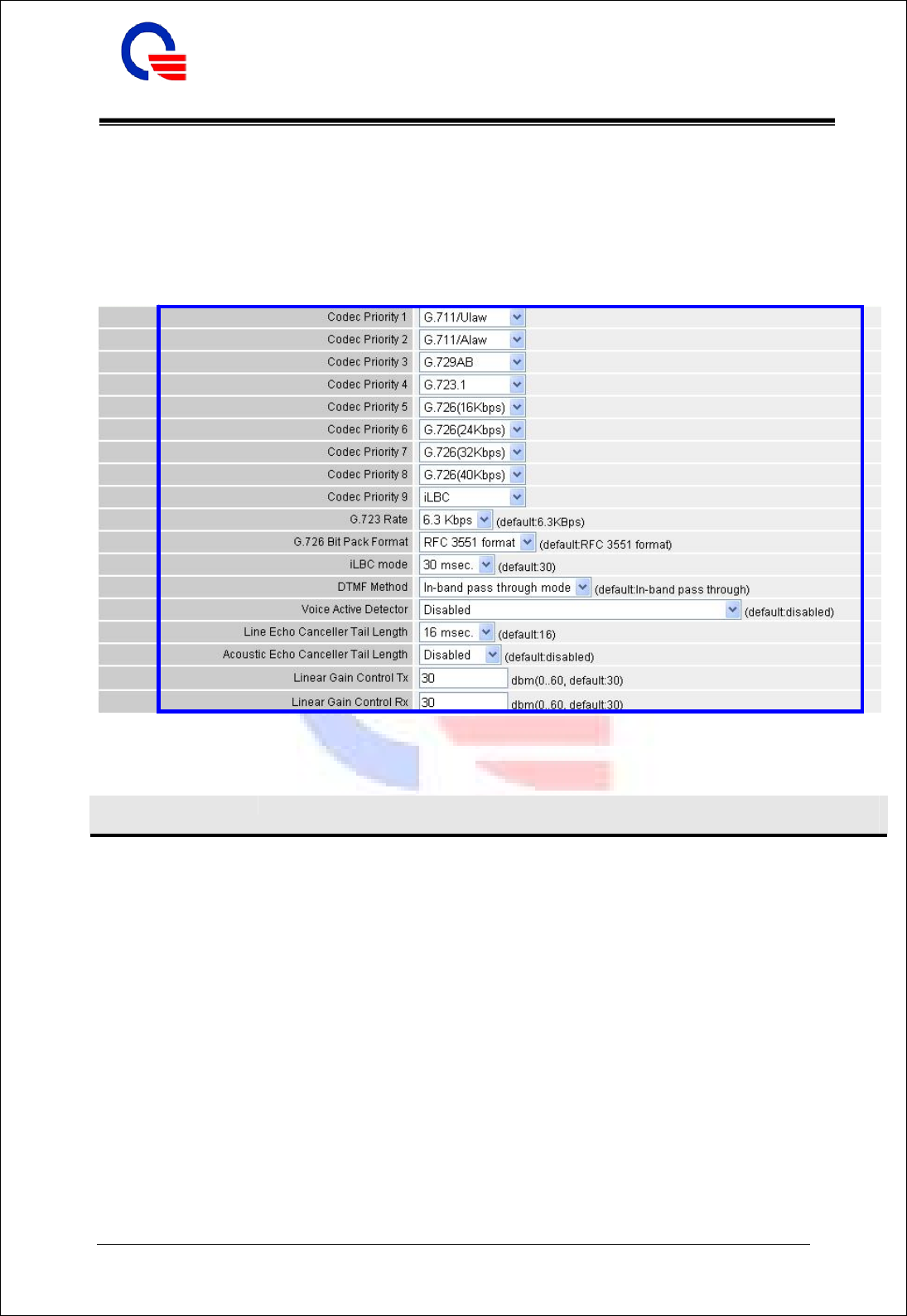
Quanta Computer Inc. IEEE802.16e WiMAX IAD (WV202)
User Manual
211, Wen Hwa 2nd Rd., Kuei Shan Hsiang, CONFIDENTIAL
Tao Yuan Shien, Taiwan, R.O.C. Classification: proprietary information
http://www.quantatw.com
57
5.1.1 Codec
A CODEC (COmpressor/DECompressor) is an algorithm for taking voice or video and compressing the
information. This type of codec combines analog-to-digital conversion and digital-to-analog conversion
functions in a single chip. The Codec is used to compress the voice signal into data packets. Each Codec
has different bandwidth requirement. There are 9 kinds of codec, G.711/Ulaw, G.711/Alaw, G.729, G.723,
G.726(16K bps), G.726(24K bps), G.726(32K bps), G.726(40K bps), and iLBC.
Field Description Default value
Line1 / Line2
Codec Priority 1 The priority 1 of codec algorithm to compress the voice signal into
data packets.
G.711/Ulaw /
G. 711 / Ul a w
Codec Priority 2 The priority 2 of codec algorithm to compress the voice signal into
data packets.
G.711/Alaw /
G. 711 / Al a w
Codec Priority 3 The priority 3 of codec algorithm to compress the voice signal into
data packets.
G.729AB /
G.729AB
Codec Priority 4 The priority 4 of codec algorithm to compress the voice signal into
data packets.
G.723.1 /
G.723.1
Codec Priority 5 The priority 5 of codec algorithm to compress the voice signal into
data packets.
G.726(16Kbps) /
G.726(16Kbps)
Codec Priority 6 The priority 6 of codec algorithm to compress the voice signal into
data packets.
G.726(24Kbps) /
G.726(24Kbps)
Codec Priority 7 The priority 7 of codec algorithm to compress the voice signal into
data packets. G.726(32Kbps) /
G.726(32Kbps)

Quanta Computer Inc. IEEE802.16e WiMAX IAD (WV202)
User Manual
211, Wen Hwa 2nd Rd., Kuei Shan Hsiang, CONFIDENTIAL
Tao Yuan Shien, Taiwan, R.O.C. Classification: proprietary information
http://www.quantatw.com
58
Codec Priority 8 The priority 8of codec algorithm to compress the voice signal into
data packets.
G.726(40Kbps) /
G.726(40Kbps)
Codec Priority 9 The priority 9 of codec algorithm to compress the voice signal into
data packets.
iLBC /
iLBC
G.723 Rate To select which mode for codec G.723. With the ability to provide
data at two-bit rates (5.3 Kbps or 6.3 Kbps), G.723 is able to
deliver near toll-quality performance at a low bit rate.
6.3 Kbps /
6.3 Kbps
G.726 Bit Pack Format To select the packet format for codec G.726.
RFC 3551 format /
RFC 3551 format
iLBC mode RTP Payload length. Select a length from the pull-down menu,
default setting is 30 msec.
30 msec. /
30 msec.
DTMF Method Control how the Device handles the tones that your telephone
makes when you push its buttons. You should use the same mode
with your VoIP service provider uses.
In-band pass through mode - send the DTMF tones in SIP
messages
In-band PCMU mode - is typically used in North America and Japan
In-band PCMA mode - is typically used in Europe
Out-bank 2833 relay - send the DTMF tones in RTP packets
In-band pass
through mode /
In-band pass
through mode
Voice Active Detector Enable/Disable this function. There are three types of silence
suppression:
1. Silence Suppression Enabled - NO CNG
2. Silence Suppression Enabled - Only G.711 Annex II type
3. Silence Suppression Enabled - Codec Specific CN.
Disabled /
Disabled
Line Echo Canceller
Tail Length
Tail length for line echo cancellation.
16 msec. /
16 msec.
Acoustic Echo
Canceller Tail Length
Tail length for acoustic echo cancellation.
Disabled /
Disabled
Linear Gain Control Tx Voice gain control for transmitting.
30 dbm /
30 dbm
Linear Gain Control Rx Voice gain control for receiving.
30 dbm /
30 dbm
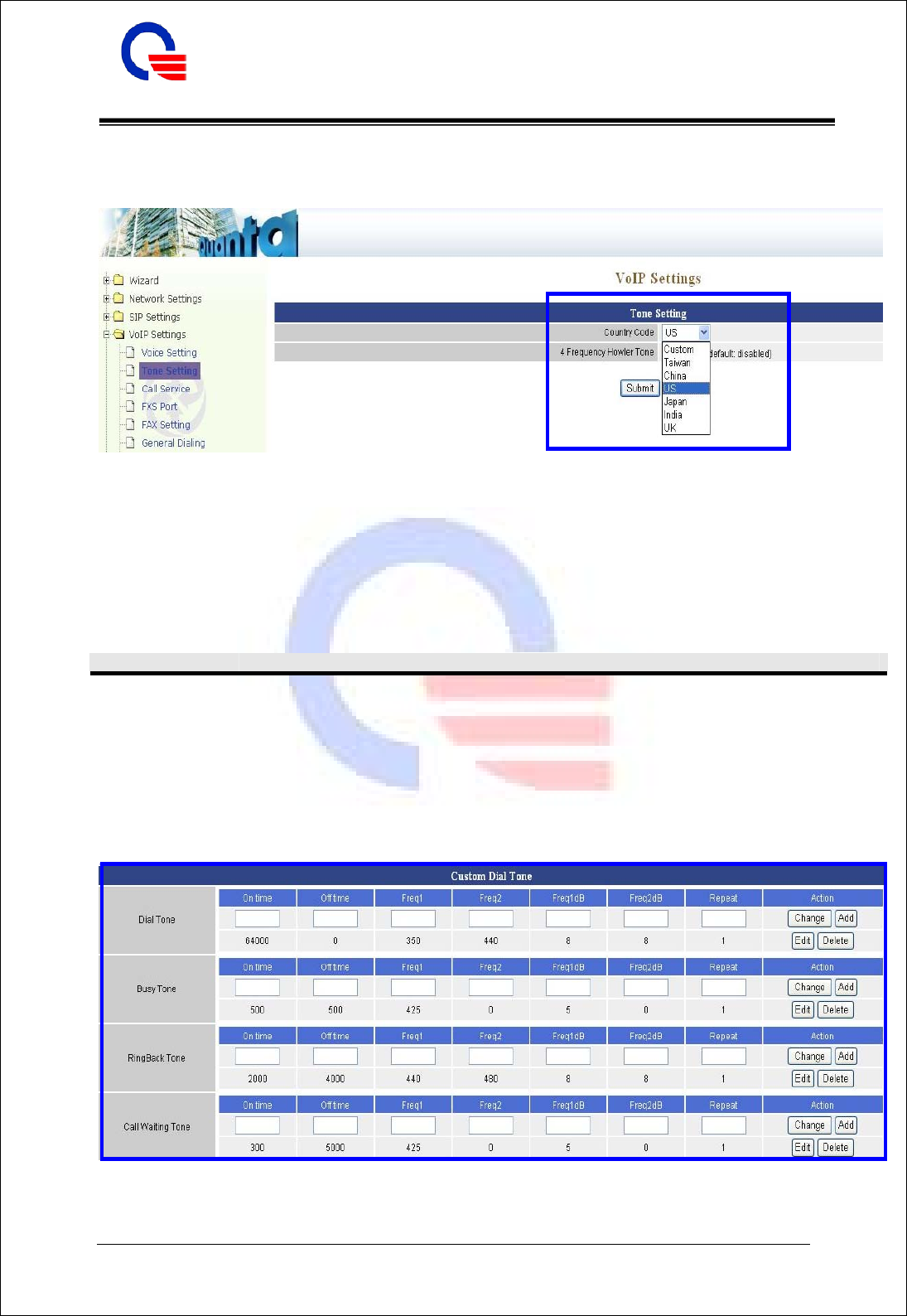
Quanta Computer Inc. IEEE802.16e WiMAX IAD (WV202)
User Manual
211, Wen Hwa 2nd Rd., Kuei Shan Hsiang, CONFIDENTIAL
Tao Yuan Shien, Taiwan, R.O.C. Classification: proprietary information
http://www.quantatw.com
59
5.2 Tone Setting
This IAD supports configuration of pre-configured audible tones based on the geographical location.
Adjust the tone frequency according to each country.
Telephony developers working in VoIP, PBXs, VoIP gateways, phones, modems and other
PSTN technologies that are developing products internationally have to know the varying international
call progress tones that differ from country-to-country. To custom the call progress tones, you should
search on a specific call progress tone (e.g. dial tone, busy tone, call waiting tone…etc.) for their
frequency, wavelength, period, amplitude, speed, and cadence. Click Tone Setting and select a country
from the pull-down menu.
When you select the country code “Custom”, you can set the detail settings as below for dial tone, busy
tone, ringback tone and call waiting tone.
Field Description Default value
Country code Select the country for the tone setting
US
4 Frequency Howler
Tone Howler tone means that a subscriber can hear a high frequency tone to
notify subscriber not hanging on well.
Disabled